
How to Plan an Around the World Itinerary in 8 Steps
Last updated on January 5, 2024 by Shannon
You’re planning an around the world trip . Congrats! My one-year trip turned into a decade of wandering and it transformed my life . My own one-year trip itinerary took me through 15 countries and countless experiences—but narrowing down my dream countries to just 15 was hard.

After so many years on the road—and after several round the world trips since that first one—I have some hard learned advice for anyone planning their own route and building their own trip around the world. If you’re planning a world trip, it’s usually a long-term route of at least a few months and up to a year around the world, or more.
These are eight ideas—eight steps really—to help narrow your travel itinerary down to those stops along your route that will fit your budget, highlight the most memorable places to you, and make sense for the trip you’ve always dreamed of taking.
Table of Contents
1. Make an itinerary bucket list for the entire world.
The inspiration phase of planning your round the world trip itinerary is one of the most fun. Maybe you already have a laundry list of places you hope to cram into your world trip itinerary. Or perhaps you’ve nailed down a few key experiences but you’re open to more inspiration. You should absolutely start with a long bucket list of locations all over the world, because weather and route might automatically strike a few off the list for you.
If you’re curious for more travel ideas, browse the best travel books sorted by destination , or search for long-reads and podcast recommendations on my Destination Travel Guides . Use these books and resources for inspiration on not only places to add to your round the world route, but activities, too.
Perhaps you read The Devil’s Picnic and subsequently add Paris to your list for that stinky but toothsome Époisses de Bourgogne cheese, or you add Bhutan because of its intriguing portrayal in The Geography of Bliss (that’s what has it on the itinerary for my next around the world trip!).
Books and podcasts are a phenomenal way to expand your idea of what is possible on your trip.
Once you have a list of dream destinations for your travel itinerary, highlight up to five that are your absolute priorities—these will become the bedrock of your around the world trip. The rest of the places on your list will slot in around those stops based on timing, weather, and more.
How granularly you plan is personal—some travelers leave with a precise list of destinations and timelines, while others plan the first couple of months of their round the world trop.
My three key travel destinations:
For my first year, I had three key activities on my list. The first was diving the Great Barrier Reef —that’s why my trip started in Australia . The second was meeting my cousin in India and backpacking north from Mumbai together for two months before ending our time together at a volunteer placement in Nepal . The third was time-sensitive as I had always dreamed of attending the Edinburgh Fringe Festival , which takes place every August in Scotland.
Later, when I traveled with my 11-year-old niece for six months in Southeast Asia , I led her through some basic Google searches so that she could see what was on offer. We planned our joint world trip itinerary together centered around her three biggies: an ethical elephant encounter , ziplining somewhere, and visiting Angkor Wat .
2. Pick a direction around the world.
From your home country, your travel itinerary will take you either east to west, or west to east around the world. Backtracking is not ideal—it’s expensive, causes more jet lag, and is bad for the environment. Use this strategy whether you use a round the world ticket (which requires this stipulation) or if you book flights as you travel.
Pros and cons of traveling east:
- Science says this direction is harder on your body and produces more jet lag . The short of it is because you are losing time when you fly through time several zones, but your body actually prefers cycles slightly longer than 24 hours, not shorter.
- You’ll need to become a pro at minimizing jet lag so you don’t lose several days to it in each new location.
- If you’re planning a very long RTW trip, perhaps 18 months or more, and your itinerary creeps around the world, then you will likely not notice the difference much.
Pros and cons of traveling west:
- As noted, your body actually prefers days that run longer than 24 hours, so your internal clock has a much easier time adding hours into your day. This means fewer nights adjusting and staring at the hotel ceiling at 3am.
- Your body can do at least two hours of time zone jumping in this direction without having a noticeable effect on you, so it’s ideal to slowly hop west around the world. And if you’re crossing the Pacific from the U.S., your largest time zone change will likely occur at the beginning of your trip, so you can then enjoy more relaxing travel for the many months afterwards.
How I decided my world trip direction:
I was lucky that two of my key experiences could bookend my trip. Scotland and Australia are not close, so it was easy to plan many of my other dream destinations to fill the space between these countries.
Since I planned to leave the U.S. in November, it was easy to surmise that starting my trip in Australia, which was entering summer, made the most sense. Then I would make my way west toward Scotland for Edinburgh Fringe, handily skirting both winter in Europe and summer in Asia.
3. Find creative overland routes.
Whew, you now have a list of dream destinations for your world trip and a direction of travel. Now it’s time to fill in the space in your itinerary. And you’ll do that by using local transportation, which is a lot more fun than flying—you’ll see more of the country and culture, and you’ll have richer travel experiences .
Go back now to those handful of key destinations from your bucket list that. These are the foundational bedrocks of your world trip itinerary. These dots on the map should lend a rough overview of a route. If they don’t, if one is just an outlier that makes it hard to see logical jumps, narrow your list down to four, and see if that helps—if you truly love the idea of an experience, but it doesn’t fit this trip it might make a great trip on its own in a couple years time.
Now, your world trip itinerary needs the details, and those usually come from visiting clusters of bordering countries—you’ll be crossing overland among many of these destinations. (For that to work, however, check visa restrictions for your nationality as some countries require visas in advance, or don’t allow crossings at certain borders).
Popular routes ( backpacking Southeast Asia , for example), have only a few restrictions and those are easily handled online, or in the days before your border crossing.
Start dotting the map with the countries that are very close to your bedrock destinations. That looks like this: If trekking in Nepal is a bedrock item, and India’s Golden Triangle and Sri Lanka were both on your dream list, then it makes sense to add them into your route, since you’ll definitely be in the region.
My creative overland routes:
As I planned my itinerary, a dear friend announced she wanted to meet me in Florence, Italy in June. That became another bedrock item with a firm date, so I now had a time I had to leave South Asia and head to Eastern Europe.
Nearby Croatia was on my tentative list, and I had a friend in Bosnia , so both of those became stops on my itinerary that helped give it shape. Prague hadn’t been on my list, but I decided to move north through Eastern Europe after leaving Bosnia.
I filled in adventurous stops that would take me from my friend in Italy in June to Scotland in August—plenty of time for rafting in Slovenia , finding charming towns in Czech Republic , biking Amsterdam like a local, and walking through the Lake District of England first!
Research activities in countries you’re considering.
If there are countries nearby your “must-visit” locations, use a site like GetYourGuide to research the types of activities you could see and do if you visited these adjacent destinations as well. I like checking out the day tour sites more than a guidebook at this stage because it’s a very quick overview of the must-dos in each location.
4. Research festivals in your favored locations.
Local festivals around the world are amazingly full of life, culture, and fun. It’s a huge letdown when you learn too late that you missed a major religious and celebratory festival by just a few days. And it’s also a shock if you arrive thinking it’s shoulder season but you really arrived during Brazil’s carnival.
Plan your route to coincide with the dates of festivals that seem most fun for you (this is especially important for trips with kids, because they love the excitement, colors, and foods at these types of events. You’ll need to book accommodation early depending on the event, so that may take some flexibility from your world travel route, but it’s worth it.
Here are a few favorite annual festivals that many travelers plan around: La Tomatina in Spain in late August; Holi the Festival of Colors in India around early March; Thailand’s Songkran Water Festival often falls within April and its Loy Krathong Lantern Festival falls in late October or early November.
Festivals around the world I sought out:
When my cousin told me should could only meet in India in February, and I knew we’d be there for two months, I went into planning mode to decide where we should celebrate Holi the Festival of Colors . It was a real highlight of my trip and I am so glad our world travel itinerary allowed us to experience this incredible Indian festival.
Then, of course, was the Fringe Festival —that was one of my bedrock destinations so it was definitely on the planned route.
5. Play Tetris with locations to fit your travel budget.
I stuck to an amazing year-long world travel budget that came in under $20,000. The only way I could do that was by carefully planning my time to favor budget-friendly countries, and then add in high-cost countries in smaller supply.
Research each of your dream destinations ahead of time because some places you might assume are budget actually cost more than you imagine (a safari in Africa is not cheap, nor is accommodation in much of Africa, but visiting a dream destination on the continent is worth it). Japan may be in Asia, but it’s pricey, too. Central America and Mexico are easy on your budget, as are parts of South America.
How I made my RTW travel budget work:
Australia , England, Scotland, and Ireland were mega expensive and represented three of my eleven months on the road. India and Nepal were, by far, the cheapest places (even cheaper than backpacking Southeast Asia ), and it was actually difficult to go over budget during the three-and-a-half months that I backpacked South Asia.
I spent the other months in Southeast Asia and Eastern Europe, two regions that are in the discount to mid-range. All told, I was able to easily average $50 a day, even though some days in Europe topped $100.
6. Plan around weather trends.
On your trip, research destinations ahead of time and plan according to your own weather preferences. While it’s not likely you will hit every destination in your preferred season, you should know when monsoon season makes a paradise island unenjoyable, or when blizzards will thwart a planned ski trip.
Research using this great rundown of shoulder season locations around the world, and this European shoulder season list , and this very cool map of a a sample round the itinerary featuring perfect weather in every location.
Why I chased summer around the world:
I planned my trip itinerary to chase summer around the world. As a native Floridian, my tolerance for heat is higher than most others, and I deeply enjoy warmth. A year of summer was lovely.
Whether your around the world trip chases summer or snow—and note it’s way easier to pack for long-term travel when you can leave behind thick jackets and boots—you’ll want to pack effectively using packing cubes .
I have probably 20 packing cubes after 15+ years of travel—cubes of all shapes, sizes, and uses to fit every trip. This eight-pack starter set is well-priced, durable, and will give you a worthy introduction into the sheer magic of packing cubes.
7. Consider how you will fly.
When planning your itinerary, you have to consider more than just major long-haul flights. On my travels, I research local budget airlines too, and I always have a good idea of which regions of the world offer affordable puddle-jumper flights. If you’re considering buying round the world tickets , read my insider tips and advice first!
Southeast Asia has AirAsia and Vietjet, among others. Europe has many budget carriers: Vueling, Ryan Air, and EasyJet. And JetStar has good flight deals in South Asia. By checking for budget airline routes, I know that I can easily visit more countries in a region if there are sub $100 flights around the area. (Tip: this is an amazing interactive map of low-cost airline routes ).
My transportation choices:
I priced out my year on the road and found it was cheaper to combine overland travel with local carriers than it would have been to buy a RTW ticket up front. I also have a guide to how I find good flight deals , since I never buy round the world airfare.
Generally, flights are likely necessary unless you plan an entirely overland route around the world , but flights are harmful if you solely rely on this form of transportation, so truly consider how you can incorporate other options, such as buying a Eurail ticket in Europe, or a Greyhound bus ticket to travel down the east coast of Australia.
Don’t forget to book travel insurance for your trip —a great policy provides coverage in case of medical emergencies, lost or stolen gear, adventure sports riders, and more. I’ve used IMG Global for more than a decade highly recommend it !
8. Remove some destinations from your world trip itinerary.
There is no wrong way to plan your route around the world, and there is no perfect number of places that you can visit in a year—it all depends on what you’re looking for on your trip. And no matter how carefully you plan, you will love some places, feel mediocre toward others, and perhaps even leave early from a few. You won’t know until you set out which type of places and experiences best fit your long-term travel style.
But please keep in mind that the pace of short-term travels is very different from a multi-month trip. Create a route that travels slowly, avoids the dreaded travel-fatigue , and includes destinations you have long dreamed of visiting. To do that, you now need to take a critical eye to your trip and trim the fat.
Is there something you added it because it seemed fun and was moderately close, but it wasn’t a bedrock item? Or perhaps it’s a location you love the idea of so much that you know you will plan a trip there in the future if you skip it now. Snip those from your world travel itinerary right now and you will be shooting me an email of thanks once you’re on the road.
The countries I cut from my around the world trip:
The best advice other travelers gave me when I asked for itinerary advice in a travel forum was to remove an entire leg of the trip. I had hoped to backpack Scandinavia between my time in the Czech Republic and Amsterdam, but long-term travelers assured me that I would be grateful for wiggle room in my itinerary by that stage of my trip (nine months into it).
Plus, they accurately pointed out that I just couldn’t swing these very expensive countries on my limited travel budget.
Turns out that I burned out a month before reaching Czech Republic and camped out in Slovenia for an extra two weeks—if I had been dead-set on Scandinavia, I would have never had time to do that while still making it to Edinburgh Fringe in time! (And let’s not even think about what Scandinavia would have done to my travel budget!).
If you’re overwhelmed about planning the nitty-gritty details on a months-long trip around the world, know that a rough route suffices. All you truly need before you leave home is logistics for the first couple of weeks—you can easily sort out the rest on the road. I promise.
Really, I promise. It seems scary but I swear to you that you will be grateful for flexibility once you land, and that it’s completely possible to plan the smaller details as you go. Moving between countries and regions was infinitely easier than I had anticipated before my first round the world.
Your Next Steps for Planning an Around the World Itinerary
Research places around the world and assemble a dream list of locations. That’s really the first step and should be a lot of fun.
While my travel books selections are a starting point, you can also peruse guidebooks for inspiration. I always buy a Lonely Planet or Rough Guide for my first planned destination (and then I swap it along the way for each new country), and before my first round the world trip I checked out a stack of 25 guidebooks from my library. Do your research and dream big before you even begin selecting an itinerary and paring down your list of destinations.
This is my core page compiling resources on How to Travel the World and here are a few other pages sharing advice specifically for long-term travel planning.
- How Much Does it Cost to Travel the World
- How to Save for Travel
- Free Destination Travel Guides
- Best Credit and Debit Cards for Travel
- How to Pack for Long-Term Travel
- How to Pick the Right Travel Insurance
How to Travel the World
Free resources and first-hand advice on how to plan long-term and round the world travels.
Essential Travel Planning Resources
❗ Yes, you need travel insurance . IMG Global is the travel insurance I’ve used for well over a decade of traveling solo, and with kids. Here’s why .
🧳 Smart packing can save your trip. Shop my favorite travel gear , including all of the packing essentials for world travel , gear to keep you safe on the road, my favorite travel books , and more.
🛏️ Find great accommodation . Booking.com is essentially the only hotel booking site that I use. It has a wide and affordable selection of traditional hotels, but also hostels and vacation rentals, too. Use these pro tips to find the best travel accommodation .
📍 Navigate more effectively. Rome2Rio is super handy to assess the full range of transport options between two cities—shows everything from flights to trains, buses, minibuses, and more. If you’re booking a rental car, I’ve always found the best deals on RentalCars.com .
✈️ Book affordable flights. Expedia is one of the first places I look for low-cost flights .
☕ Peruse all of my tips for round the world travel , or learn how to move and live abroad .
Here's what you need to know to plan a trip around the world
Dec 29, 2021 • 7 min read

Don't start planning your round-the-world trip without reading this guide © Getty Images
In 1924, a team of aviators from the USA successfully completed the first-ever circumnavigation of the globe by airplane, a feat that took 175 days, 76 stops, a cache of 15 Liberty engines, 14 spare pontoons, four aircraft and two sets of new wings. This achievement ushered in an era of international air travel, and nearly a century later, travelers are still creating their own round-the-world itineraries.
You might not have the same worries as those early aviators, but planning a round-the-world trip has never been a more complex process. As COVID-19 continues to alter world travel , heading out on a multi-country trip might be more complicated than it has been in decades. While it might not be the right time to hit the road, luckily it's never too early to start figuring out the logistics of a trip around the globe. After all, who doesn't have a lot of pent-up wanderlust at the moment?
When it comes to booking your trip, there are several options for booking your airfare, as well as flexibility on timing, destinations and budget. But don't let that overwhelm you – start here with our handy guide on how to plan that round-the-world trip you’ve always dreamed of.
Where and how to get a round-the-world plane ticket
The most economical way to circumnavigate the globe is to buy a round-the-world (RTW) plane ticket through a single airline alliance. These are confederations of several different airlines that make it simple to maximize the number of places you can travel and pay for it all in one place or with points. There are three primary airline alliances to choose from: Star Alliance, OneWorld and Skyteam. Star Alliance is a coalition of 26 airlines that fly to 1300 airports in 98% of the world’s countries. OneWorld includes 14 airlines traveling to 1100 destinations in 180 territories. Skyteam is made up of 19 airlines that serve 1000 destinations in 170 countries.
Read more: How to save money when you're traveling
Once you pick an airline alliance, whether because of a loyalty program you’re already a member of or because you like its terms, conditions and destination list, you can purchase a single RTW airline ticket made up of several legs fulfilled by that alliance’s partners. The RTW ticket rules vary between each of the airline alliances, with particulars like Star Alliance’s rule that a RTW ticket can include two to 15 stops. But there are some general principles that apply to most RTW tickets, no matter which airline group you go with.
You typically must follow one global direction (east or west – no backtracking); you must start and finish in the same country; and you must book all your flights before departure, though you can change them later (though this could incur extra charges). Typically you have one year to get from your starting point to the finish line.
How long do I need for a round-the-world trip?
You could whip around the world in a weekend if you flew non-stop, especially with the advent of new ultra-long-haul flights that can clock in at 20 hours of flight time. However, the minimum duration of most RTW tickets is 10 days – still a breathless romp. To get the most out of your round-the-world ticket, consider stock-piling vacation days, tagging on public holidays or even arranging a sabbatical from work to take off at least two months (but ideally six months to one year). Because most airline alliances give you up to a year to use your ticket, you can maximize your purchase if you plan well.

When should I travel on a round-the-world trip?
The weather will never be ideal in all your stops, so focus on what you want to do most and research the conditions there. In general, city sightseeing can be done year-round (escape extreme heat, cold or rain in museums and cafes), but outdoor adventures are more reliant on – and enjoyable in – the right weather.
Research ahead of time if any must-see destinations or must-do activities will mean facing crowds. For example, if you’re hoping to be in Austria for the famous Salzburg Festival, you’ll want to plan ahead and book your tickets months in advance. If you’re hoping to fit a shorter thru-hike into your round-the-world trip, you’ll want to make sure you’re going in the correct season and starting in the right spot. You won’t get far or have as enjoyable an experience if you’re, say, attempting the Tour du Mont Blanc during the dates of the annual winter marathon or headed northbound on the Pacific Crest Trail in July, missing most of the warmer months.
Accept youʼll be in some regions at the "wrong" time – though this might offer unexpected benefits. For example, Victoria Falls has a dry season each year , which means a slightly less thunderous cascade, but it does open up rafting opportunities and a chance to swim right up to the lip of the falls in The Devil’s Pool. Going to Venice in the winter might mean grayer skies but fewer crowds. Heading to Kenya and Tanzania in April is likely to mean fewer humans, but not fewer chances to spot wildlife, all while saving money on safari. Also keep in mind that mom-and-pop locations have their downtime and holiday seasons as well; don't be too surprised if your local bakery in Paris is closed for a holiday week or two in August.
Where should I go on my round-the-world trip?
The classic (and cheapest) RTW tickets flit between a few big cities, for example, London – Bangkok – Singapore – Sydney – LA . If you want to link more offbeat hubs ( Baku – Kinshasa – Paramaribo , anyone?), prices will climb considerably. The cost of the ticket is also based on the total distance covered or the number of countries visited.

Remember, you donʼt have to fly between each point: in Australia you could land in Perth , travel overland and fly out of Cairns . Or fly into Moscow , board the Trans-Siberian railway and fly onwards from Beijing. Pick some personal highlights and string the rest of your itinerary around those. For instance, if youʼre a keen hiker, flesh out a Peru ( Inca Trail ) – New Zealand ( Milford Track ) – Nepal ( Everest Base Camp ) itinerary with stops in Yosemite , Menz-Gauassa and the Okavango Delta .
If budgetʼs an issue, spend more time in less expensive countries and plan budget city breaks along the way. You’ll spend more in metros like Paris, Dubai and San Francisco than in Nusa Tenggara , Budapest and Buffalo .
Tips, tricks and pitfalls of round-the-world tickets
Talk to an expert before you book a round-the-world ticket: you may have an itinerary in mind, but an experienced RTW flight booker will know which routes work best and cost least. A few tweaks could mean big savings in time and money. Hash out a budget well ahead of time, not only for your RTW ticket, but also for the whole trip. Reach out to friends or travel bloggers who have done a round-the-world trip or are full-time travelers because they can offer tips on how to budget for a trip around the world .
Be flexible: moving your departure date by a few days can save money. Mid-week flights are generally cheaper, as are flights on major holidays such as Christmas Day. Avoid days and times popular with business travelers to escape higher prices and more crowded cabins.
Think about internal travel: it can be cheaper to book internal flights at the same time as booking your RTW ticket, but with the global increase of low-cost airlines, you may find it better (and more flexible) to buy them separately as you go.
Be warned: if you donʼt board one of your booked flights (say, on a whim, you decide to travel overland from Bangkok to Singapore rather than fly it) your airline is likely to cancel all subsequent flights.
You might also like: 10 destinations perfect for solo travel Can visiting lesser-known places offer a better travel experience? 6 things I learned from flying 6 days in a row
This article was first published Mar 20, 2012 and updated Dec 29, 2021.
Explore related stories

Jul 18, 2024 • 2 min read
Is it possible to go sightseeing in London with just an 8-hour layover at Heathrow Airport? LP is here to help.

Mar 14, 2024 • 10 min read

Nov 19, 2023 • 10 min read

Aug 27, 2023 • 6 min read

Apr 28, 2023 • 3 min read

Dec 1, 2022 • 3 min read

Jan 12, 2020 • 5 min read

Sep 17, 2024 • 12 min read

Sep 6, 2024 • 6 min read

Sep 3, 2024 • 7 min read

The Ultimate Guide to Planning the Round the World Trip of a Lifetime

After planning 10 around the world trips, I’ve learned a few things. Here’s how to plan your dream RTW vacation, from Round the World flights to choosing your Bucket List itinerary.
Let’s face it, the pandemic was a punch to the gut for travel lovers around the world.
Never did I think I’d see a day when I couldn’t just bebop onto a transatlantic flight. Or just, say, leave my own home. But there we were.
When I (literally) dusted off my passport in early 2021, the thin layer of dust accumulated was borderline soul crushing.
But thankfully, the pandemic era is finally in the rearview mirror and international travel has rebounded with a heart-warming zeal in the years since!
Note: This post may contain affiliate links. If you choose to book through these links, I receive a small commission, which I will undoubtedly blow on more flights (it’s a vicious cycle). All of this internet voodoo takes place at no additional cost to you.
So now what?
You’ve got some lost time to make up for, that’s what.
And there’s no better way to do it than with a life-changing, Bucket-List-crushing, dream vacation around the world .
Take my word for it…I’ve done 10 around the world trips, visiting more than 175 countries on all 7 continents along the way.
And you can, too.
But I probably don’t need to waste my time selling you on the idea of a trip around the world. You found this site. I suspect you’re on board.
So let’s start with the basics.

What is a Round the World Trip?
Simply put, a Round the World (RTW) trip is a circumnavigation of the globe, either in an eastward or westward direction. Start in one city and continue east or west until you get back to it.
That’s all there is to it!

Tip: West is best for combatting jetlag, while East saves time and hotel nights ($$) with overnight flights. (I’m cheap and usually short on time, I fly East. )
Read More: 8 Reasons to Stop Dreaming & Start Planning a Trip “Around the World in 30 Days “
Of course, while the concept of round the world travel is simple, the variables are far more complex.
For example, you may be wondering…
How many days do I need for a Round the World trip?
What you’ve probably seen on YouTube and Instagram from round the world travelers is true.
Most quit their jobs, sell their possessions, and hit the road for a year or more with big dramatic flair. Of course, that kind of nomadic commitment is not for everyone.
And I’m living proof that there are other options.

My first 9 RTW trips were approximately 30 days each. The lone exception was RTW #10, my honeymoon , which clocked in at a pretty incredible 3 months.
I’ve also done 30-day trips focused on various regions of the world like Europe , Central America , Oceania , the Balkans , and the Himalayas (a great option if there’s a specific part of the world that interests you or you just hate jetlag).
For me, a month is the ideal amount of time to travel.

Long enough to truly disconnect and explore.
Yet short enough that I’m unlikely to throw my carry-on (we’ll get to that) suitcase out the nearest train window because I’m tired of every single thing in it.

There’s no right answer to how long your round the world trip should take. I know someone who went around the world in 5 days (zero stars, do not recommend) and someone else who started 10 years ago and is still going strong.
So, two weeks, a month, or even 6 months to travel around the world? It’s totally up to you.
The bottom line: Take as much time as you can, anywhere from 2 weeks to 2 months will do. If 2020 taught us anything, it’s that you never know if you’ll have the chance to do it again.

A trip around the world sounds amazing, but how do I get the time off?
When I wrote the first edition of The Grown-Up’s Guide to Globetrotting 12 years ago, this topic was a central focus and the largest hurdle to taking a career-friendly trip around the world.
After all, most Americans are stuck with a measly 2 weeks of annual vacation leave (the horror!).
So, how do you travel around the world without tanking your career?
Amazingly, on this front, the COVID-19 pandemic gifted us with one gleaming silver lining:
WORK. FROM. HOME.
Yes, even the stuffiest of Fortune 500 corporations have finally come around to the idea that work from home can (and does) work – with the right employee.
This revelation is especially thrilling to me as someone who has been working from home (combined with business travel) for more than 20 years.
In fact, my friends will tell you that my life mantra has always been:

Or Paris. Or Bangkok. Or wherever floats your boat.
You get the idea.
There’s a lot more to making this work successfully from exotic locales – time zone challenges, reliable internet, etc. (I go into that in detail in the book) – but I can assure you, it can be done.

And it beats the pants off working from your dining room table.
The bottom line: You can use the WFH option to increase your available time for travel. Add days or weeks onto your trip or schedule a trip just to work from somewhere inspiring.

What’s on your Bucket List?
And now we come to the fun part. This is where the magic happens.
Where in the world do you want to go?
I speak from experience when I say that there are few things more thrilling than sitting down in front of a giant foldout map of the world and plotting out your dream vacation .

Maybe you already have a dozen exotic destinations in mind. Or maybe there are places in the world you never considered visiting because they always seemed too far away.
The beauty of going around the world is that the entire world becomes just a short flight away.

How many destinations should I choose?
The answer will directly correlate to how much time you plan to take. My 4 week round the world trips have ranged from an uber-ambitious 15 stops on Round the World #1 to a more relaxed pace with 8 stops on Round the World #2 .
Here’s a simple, 3-step plan for crafting your round-the-world trip itinerary:
- Make your wish list.
- Compare it to the number of days you have to travel.
- Adjust accordingly.
Critically evaluate how long you actually need to see each desintaiton on your wish list.

For some (like me), 2-3 days per destination can be a good rule of thumb.
Devote more time to your “ Top 5 ” must-see destinations and maybe just spend one day exploring the city you only added to the itinerary because it was right there and you couldn’t just skip it (you laugh, but I guarantee a few of these stops will sneak their way onto your itinerary!).
Remember that a 4 week round the world trip, however incredible, is not going to be an in-depth cultural experience at every stop.

Think more Amazing Race and less Under the Tuscan Sun .
It IS, however, a terrific way to get a taste of new and exciting places and start building a new wish list for future trips.
Depending on your interest level, you may not need a week to see the Pyramids , I did it in an afternoon and it was magnificent.
A full day at the Taj Mahal and a morning walk along the Great Wall of China were enough to fulfill my dream of seeing those world wonders.
But that’s me. And I’ve been told I can be a little, ah, overly-energetic when I travel.
You do you.
Need some destination inspiration? Here are 30 of my favorite travel experiences around the world:
Around the World in 30 Extraordinary Travel Experiences

And here are the Top 50 places I think should be on every Travel Bucket List:
50 Amazing Places for Your Travel Bucket List (2024)

Round the World Flights: The RTW Ticket (your new best friend)
I am fortunate that my years of excessive business travel have one nifty little side benefit, I have a crap ton of airline miles.
So when I discovered the magical world of “ Round the World airline tickets ” years ago, those Delta miles not only afforded me the opportunity to take that first RTW trip but to take it in first class with Delta’s Skyteam Alliance.

Sadly, the days of booking a RTW ticket with miles went the way of the dodo bird in 2015. I won’t lie to you, I wept openly when Delta first announced it (followed quickly by United and American).
But all is not lost if you’ve been hoarding miles like pandemic toilet paper. All major US airlines now allow one-way award booking. This means you can still use your miles to route yourself around the world, one one-way flight at a time!

And honestly, the old mileage RTW tickets were a deal but they were a BEAR to book and had zero flexibility.
One-way award booking gives you a ton more flexibility plus the option to mix economy and business class legs (for longer flights) on your journey.

This is a BIG perk.
Here are a few more tips for you “ Up in the Air ” business travelers out there with miles & points to burn:
How to Use Points & Miles to Redeem Your RTW Dream
No miles, no problem
Two of the three major airline alliances do still offer paid RTW ticket options. Delta’s Skyteam Alliance is the exception, they discontinued the RTW ticket option completely a few years ago.
There are pros and cons to booking a round the world ticket with an airline alliance:
- Cons – Airline alliance RTW tickets are not cheap and you’ll spend extra time connecting through hub cities to get where you want to go.
- Pros – You can earn a ton of miles (and airline status) as you travel and those extra cities can be fun stopovers. Plus, if you already have status with an airline in the network, you’ll get lots of extra benefits like free checked bags and early boarding.
If that option interests you, start here:
- Oneworld – World Travel (American, Alaska)
- Star Alliance – Round the World (United)

The affordable RTW ticket…
If redeeming (or earning) miles isn’t your jam and you truly just want the most affordable way to see the world, skip the airline alliances and head straight to:
- Airtreks – This site is more service oriented, you enter a proposed itinerary and a travel planner will contact you to create the perfect customized itinerary.
- BootsnAll – This one is more DIY. You can create and book an itinerary yourself online.
Unlike the airline alliances, these two round the world airfare specialists utilize all airlines to create your dream itinerary. This will often yield both the best price and the most direct routing for your trip.
WARNING: Once you start playing around with the trip planners on these two sites, you may become addicted to the global possibilities.
Tip: You guessed it, I’ve covered all the ins and outs of booking RTW tickets in the book.
Hotels vs. Airbnb – Where to stay?
Once again business travel rewards can be handy when planning trips around the world.
My Marriott and Hilton points have been offsetting the costs of my round the world trips for years. Not to mention affording me swank rooms at hotels and resorts that were WAY outside of my round the world budget, like these:

But if you don’t have points, not to worry!
I am a firm believer that a quality, affordable hotel can always be found, even in the most expensive destinations. My go-to hotel site (when I’m not using points) is Booking.com .

Tip: If you’re not a member of any hotel frequent guest programs, sign up for all of them before you go. It’s free and you’ll earn points as you travel. Many also offer perks during your stay, just for being a member.
If you’re not a fan of chain hotels or if you’re going to be in one spot for more than 3 or 4 days, I’d highly recommend an apartment rental. They can be considerably cheaper than even the most economical hotel, and having a kitchen can also be a tremendous cost-saver.
Not to mention it’s just fun to live more like a local!
One of my favorite apartment rental sites is Airbnb but I’ve also found that more and more apartment rentals are also listed on Booking.com (and the fees there are often cheaper than Airbnb). That said, I’ve booked with Airbnb all over the world (including the Tuscan villa we used for our wedding – below!) and never had a bad experience.

Who should I travel with on an around the world trip?
If you’re married, it would probably be rude to go without your spouse (try it at your own marital peril).
But if you’re single, this is a question that deserves serious consideration. If you’ve never traveled solo, your gut instinct may be to find a friend or family member to travel with.
But before you do that, consider this…

A solo trip around the world is perhaps the best gift you can ever give yourself, especially for women. It’s empowering, it’s safe and it just might be the best travel experience of your life.
Read More: Why Every Woman Should Travel the World Solo (at Least Once) & How to Stay Safe Doing It

So yes, it’s perfectly fine (and perhaps even preferable) to travel round the world solo.
No matter what you decide, choose carefully.

How to pack (carry on only!) for an around the world trip
Yes, you read that right. I just casually floated the idea of traveling around the world for a month or longer with nothing but a carry-on bag.
If you’re a guy, you were probably not at all alarmed by the previous paragraph and thought, “ Couple of t-shirts, some shorts, underwear, got it. ” You can scroll down to the next topic, this section is not about you.
Now, for my globetrotting ladies. I’m going to ask you to trust me on this one. We’ve known each other for 10 or 15 minutes now and I feel like you get me.
With so many flights involved in an around-the-world itinerary, carry-on is truly the only option.
Reuniting with a lost bag can quickly become a logistical nightmare when you’re changing cities every few days. (And I can assure you that no one at the lost baggage desk understands what “ RTW ticket ” means.)
If you don’t believe me you can read all about the one time I broke my own rule and ended up spending an entire day at baggage claim in Paris on Round the World #4 . (Actually, don’t. It’s mind-numbing reading and definitely not my best work.)

You can do this. You don’t need all the “ stuff ” you think you do!
(For the things you do need, here’s all the Stuff I Love most!)
I have traveled for as long as 3 months out of just a carry-on (and in case I forgot to mention it, I’m a girl!). I do freely admit, however, that I was over just about every item of clothing in that suitcase by the end.
I also confess I checked a bag to Antarctica. Because Antarctica .

How do I do it? This excerpt from “ The Grown-Up’s Guide to Globetrotting ” is guaranteed to help you overcome your RTW packing challenges:
How to Travel Around the World with Just a Carry-On: A Girl’s Guide to Traveling Light
What else do I need to know for a RTW trip?
We’ve covered the big-ticket items – how long to travel, how many places to visit, with who, how to find RTW tickets, where to stay, and what to pack.
So what’s left?
Well, a LOT actually. But hey, that’s where my book comes in (insert shameless plug here).
I’ll end with a hit list of other tips, tricks, and things to consider when planning your once-in-a-lifetime (or maybe more!) round the world trip:
- Apps : For currency conversion, I like the Oanda app. And Google Translate is also a life saver.
- Thoroughly research entry requirements for ALL countries you plan to visit well in advance. Almost all visa applications can now be completed online.
- A good universal power adapter & converter is a must. More than one is a plus if you have lots of devices (and don’t we all these days?).
- Check with your doctor for any immunizations you may need for your destinations. I got the works before my first trip and haven’t had to worry about it since (other than the occasional prescription for malaria pills).
- Consider purchasing travel insurance, for a trip of this magnitude, it’s a must! Especially in the post-pandemic era. Here’s a good independent review of the benefits of travel insurance and the options available: 10 Best Travel Insurance Companies
- Make sure your passport is valid for at least 6 months after your planned date of return because all countries have different requirements on this.
And finally…

Get the Book!
For more comprehensive advice on planning your around the world itinerary, booking Round the World tickets, and everything else you ever wanted to know about travelling around the world, get the ultimate Round the World trip planner:
Round the World in 30 Days: The Grown-Up’s Guide to Globetrotting
Now get out there and start planning the around the world trip of your dreams!
As Phil Keoghan says at the start of every season of the Amazing Race,
“The world is waiting for you!”
i am globe trekker
How Do I Plan A Round-the-world Trip Itinerary?
Are you dreaming of embarking on an epic adventure around the world? Wondering how to plan a round-the-world trip itinerary that covers all the must-visit destinations? Well, buckle up, my young traveler, because I’ve got some exciting tips and tricks to help you navigate the globe like a pro!
Picture this: exploring ancient ruins in South America, befriending kangaroos in Australia, savoring street food in Asia, and lounging on pristine beaches in the Caribbean. Planning a round-the-world trip can be a thrilling yet overwhelming experience, but fear not! I’m here to show you the ropes.
So, grab your compass and pack your curiosity, because together, we’ll learn how to create the ultimate round-the-world itinerary that will make your globetrotting dreams come true. Ready? Let’s dive in!
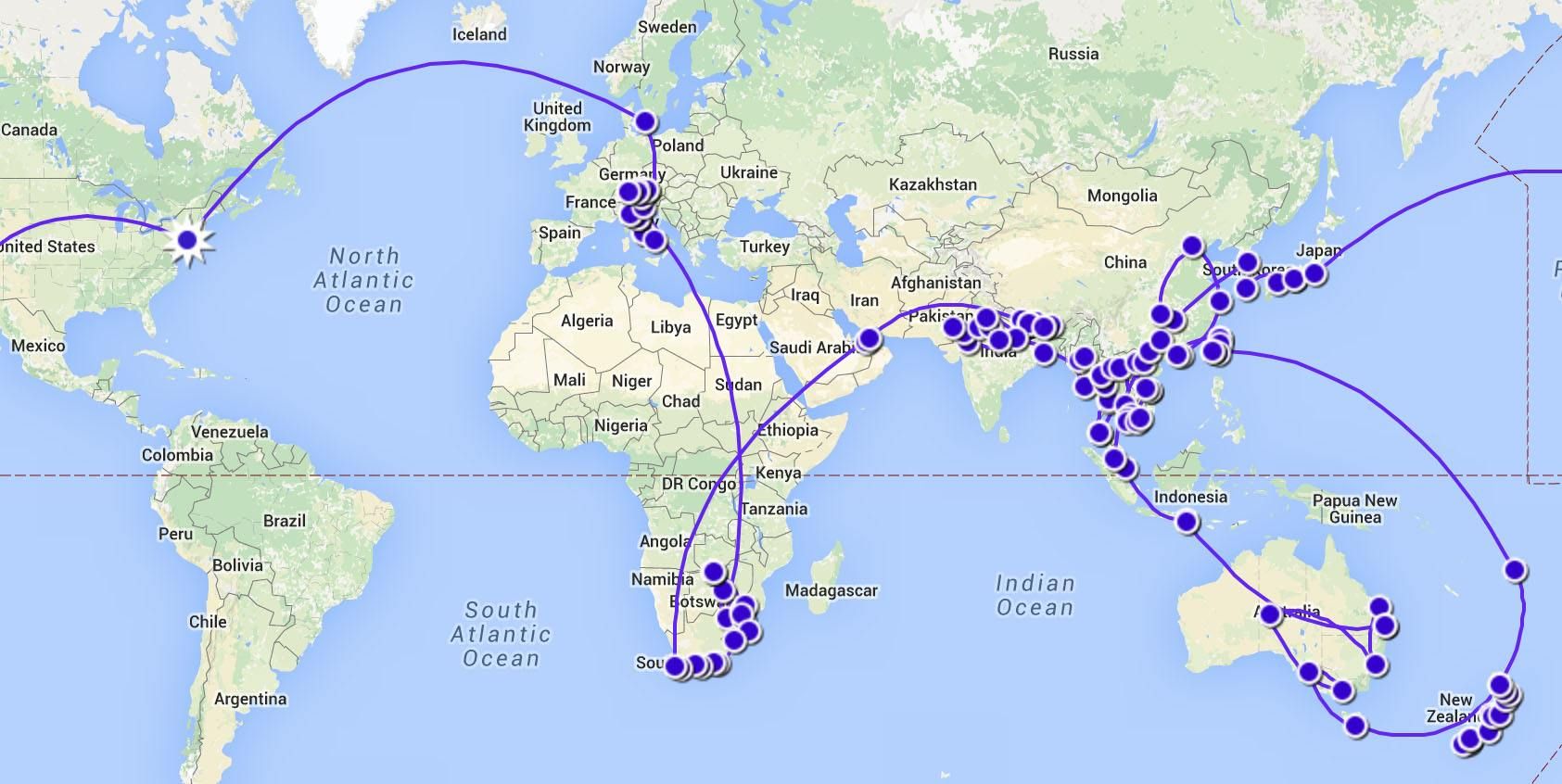
How to Plan a Round-the-World Trip Itinerary
Planning a round-the-world trip can be an exciting and overwhelming experience. There are so many destinations to choose from and countless logistics to consider. In this article, we will guide you through the process of creating a well-thought-out itinerary for your dream adventure. Whether you’re a seasoned traveler or embarking on your first long-term journey, these tips and insights will help you plan an unforgettable round-the-world trip.
Factors to Consider when Planning a Round-the-World Trip
Before diving into the specifics of creating an itinerary, it’s important to consider several factors that will influence your decision-making process. These factors include your budget, time constraints, interests, and travel preferences. Understanding these elements will help you narrow down your options and design a customized itinerary that suits your unique needs.
1. Identifying Your Interests and Priorities
The first step in planning a round-the-world trip is to determine your interests and priorities. Ask yourself what you want to experience and explore during your journey. Are you a history buff looking to visit ancient ruins? Or perhaps you’re a nature lover who wants to hike through scenic landscapes. Identifying your passions will help you decide which countries and regions to include in your itinerary.
Consider your priorities as well. Are you more interested in immersing yourself in local cultures or exploring vibrant cities? Do you prefer adventurous activities or relaxing by the beach? By knowing what matters most to you, you can create a well-rounded itinerary that aligns with your travel goals.
Once you have a clear idea of your interests and priorities, you can start researching destinations that offer the experiences you’re looking for. Consult travel blogs, guidebooks, and online resources to gather information about each potential stop on your itinerary. Use the insights you gather to narrow down your choices and select the destinations that best match your interests.
2. Establishing a Realistic Budget
When planning a round-the-world trip, budgeting is a crucial aspect to consider. Determine how much money you are willing to spend on your journey, taking into account expenses such as flights, accommodations, meals, transportation, activities, and visas. Remember to include a buffer for unexpected costs as well.
Research the cost of living in each destination to estimate daily expenses, and consider the length of your stay in each place. Some countries may be more budget-friendly than others, so finding a balance between affordability and your desired experiences is essential.
Once you have established a budget, prioritize your destinations accordingly. Allocate more time and resources to countries that are more costly, and consider spending less time in places that offer more affordable options. This approach will help you make the most of your budget and ensure a well-managed trip.
3. Considering Time Constraints and Travel Season
Time constraints play a significant role in shaping your round-the-world itinerary. Take into account the duration of your trip and how much time you can allocate to each destination. Consider the average length of stay required to explore each place adequately and adjust accordingly.
Additionally, research the climate and weather patterns in each region during your planned travel dates. Depending on your preferences and comfort level, you may want to avoid peak tourist seasons or extreme weather conditions. Balancing your desired activities with favorable climate conditions will enhance your overall experience.
Finally, be mindful of any specific events or festivals that may be taking place in your preferred destinations. Attending unique cultural celebrations or special events can add depth and richness to your journey. Incorporating these occasions into your itinerary will provide unforgettable memories and a deeper understanding of the local culture.
4. Mapping Out Your Route
Once you have considered your interests, budget, time constraints, and travel season, it’s time to start mapping out your round-the-world route. Consider the sequence in which you plan to visit each destination. This sequence can be influenced by factors such as flight connections, geographic proximity, and visa requirements.
Begin by identifying a starting point and an endpoint for your trip. These could be the cities where you will depart from and return to, or they could be different locations depending on your preferences. From there, outline a logical flow of destinations that maximizes efficiency and minimizes backtracking.
Consider the transportation options available between each location, such as flights, trains, buses, or ferries. Research airline alliances and round-the-world tickets, which can offer cost savings and simplify the logistics of booking multiple flights.
Make use of online mapping tools and travel websites to visualize your route and estimate distances between destinations. This will help you identify any countries or regions that may be challenging to access or require additional transit time. Being mindful of these factors will enable you to create a practical and well-connected itinerary.
5. Allotting Sufficient Time in Each Destination
One mistake many travelers make when planning a round-the-world trip is trying to fit too many destinations into a limited timeframe. Overloading your itinerary can lead to exhaustion and prevent you from fully immersing yourself in each place you visit.
Instead, allow sufficient time in each destination to explore, relax, and soak in the local atmosphere. This will enable you to delve deeper into the culture, try local cuisines, and truly connect with the people and surroundings. A slower-paced itinerary will also provide flexibility for unexpected adventures and the chance to veer off the beaten path.
Consider the recommended length of stay for each location, as well as any specific activities or day trips you plan to undertake. Be realistic about how much time you need to truly experience each place, and adjust your itinerary accordingly. Remember, quality over quantity is key when it comes to planning a fulfilling round-the-world trip.
6. Navigating Visa Requirements
When planning a round-the-world trip, it’s essential to research and understand the visa requirements for each country you plan to visit. Some countries offer visa-free entry or tourist visas upon arrival, while others require advance visa applications.
Make a list of the countries on your itinerary and research their specific visa regulations. Determine whether you need to obtain visas in advance, how long they are valid for, and any restrictions or requirements that may apply. Factor in the processing time for visa applications when calculating your timeline.
Consider consulting with travel agencies or online forums to seek advice from individuals who have navigated the visa process for similar itineraries. Their experiences and insights can help you plan accordingly and avoid any unexpected visa-related issues during your journey.
Additional Considerations for Planning a Round-the-World Trip
After you have established the main components of your itinerary, there are a few additional considerations that can further enhance your round-the-world trip planning process.
Choosing Accommodations
Research different types of accommodations available in each destination, such as hotels, hostels, guesthouses, or vacation rentals. Consider factors like comfort, location, and price. Look for accommodation options that align with your travel preferences and budget.
Booking accommodations in advance can provide peace of mind, especially during peak travel seasons or in popular tourist destinations. However, leaving some flexibility in your schedule for spontaneous changes or last-minute decisions can also add excitement to your journey.
Creating a Travel Budget and Tracking Expenses
Aside from establishing an overall trip budget, it is helpful to create a detailed travel budget that accounts for daily expenses during your journey. Break down your budget by categories such as accommodations, transportation, meals, activities, and miscellaneous expenses.
Tracking your expenses throughout your trip will allow you to adjust your spending habits and ensure that you stay within your allocated budget. Numerous smartphone apps and online tools are available to help you manage and track your expenses on the go.
Health and Safety Precautions
Prioritize your health and safety by researching any necessary vaccinations or medications required for the destinations on your itinerary. Consult a healthcare professional or visit a travel clinic to receive personalized advice based on your specific travel plans.
Invest in comprehensive travel insurance, which should cover medical emergencies, trip interruptions, and lost or stolen belongings. Familiarize yourself with local customs and regulations to avoid any unnecessary risks or misunderstandings during your journey.
Staying Connected and Managing Technology
In today’s digital age, staying connected while traveling has become increasingly important. Research local SIM card options, portable Wi-Fi devices, or data roaming plans to ensure you have reliable internet access during your trip.
Consider investing in travel-friendly technology such as a lightweight laptop or tablet for planning, booking, and staying organized. Portable charging devices and adapters are also essential for keeping your electronic devices powered throughout your journey.
Remaining Flexible and Embracing Spontaneity
While having a well-planned itinerary is crucial for a successful round-the-world trip, it is equally important to remain flexible and open to unexpected opportunities. Embrace spontaneity and allow room for detours and changes along the way.
Interact with locals, fellow travelers, and other backpackers you meet along the journey. They can offer valuable insights, recommendations, and even join you on exciting adventures. Some of the most memorable moments of your trip will likely come from these unplanned encounters.
Remember that your round-the-world trip is an adventure of a lifetime. Embrace the unknown, step out of your comfort zone, and savor every moment of this incredible journey. Bon voyage!
Key Takeaways: How do I plan a round-the-world trip itinerary?
- Consider your budget and time frame when planning a round-the-world trip.
- Research destinations and create a list of places you want to visit.
- Make a rough itinerary, including the order of destinations and estimated duration of stay.
- Be flexible and allow for changes based on personal preferences and new discoveries.
- Consider transportation options, such as flights and train routes, to connect different destinations.
Frequently Asked Questions
Planning a round-the-world trip itinerary can be an exciting but daunting task. Here are some common questions and answers to help you plan your dream adventure:
1. How do I decide on the destinations for my round-the-world trip?
When deciding on destinations for your round-the-world trip, consider your interests, budget, and time frame. Make a list of places you’ve always wanted to visit and research the best times to go. Consider the cultural experiences, natural wonders, and historical landmarks each destination offers. Take into account the ease of transportation and visa requirements. Prioritize the countries or regions that intrigue you the most and create a tentative itinerary accordingly.
Remember, you don’t have to visit every country. It’s better to thoroughly enjoy a few places rather than rushing through many. Be realistic about the time and money you have available, and choose a mix of popular destinations and hidden gems to make your trip truly unforgettable.
2. How do I create a budget for a round-the-world trip?
Creating a budget for a round-the-world trip is crucial to ensure you have enough money to cover your expenses. Start by researching the cost of accommodation, transportation, meals, activities, and visas in each destination. Use online travel guides or consult fellow travelers who have been to those places for an estimate. Add a buffer for unexpected expenses and emergencies.
To minimize costs, consider traveling during the shoulder seasons, staying in budget accommodations, and opting for public transportation or budget airlines. Cut down on unnecessary expenses like eating out for every meal or splurging on luxury accommodations. Keep track of your expenses during the trip to stay within your budget and make adjustments if necessary. Remember, frugality doesn’t mean compromising on experiences, but it allows you to make the most of your resources and extend your trip.
3. How do I plan the logistics for a round-the-world trip?
Planning the logistics for a round-the-world trip involves understanding the transportation options, visa requirements, and the best route to take. Research different modes of transportation such as flights, trains, buses, and ferries to determine the most efficient and cost-effective way to move between destinations. Consider using a combination of one-way flights, open-jaw tickets, and overland travel to navigate the globe.
Before traveling, check the visa requirements for each country you plan to visit and make sure you have the necessary documents and vaccinations. Some countries require an advanced visa application, so it’s important to plan accordingly. You can also consult travel agencies or online resources that specialize in round-the-world itineraries to help you with the logistics and ensure a smooth trip.
4. How can I make the most out of my round-the-world trip on a limited timeframe?
If you have a limited timeframe for your round-the-world trip, focus on key highlights and must-see destinations. Prioritize the places that hold the most appeal to you and plan your itinerary accordingly. Consider spending more time in fewer countries to fully immerse yourself in the local culture and explore the attractions in depth.
Research time-saving travel options like direct flights or overnight trains. Be selective in your activities and choose experiences that align with your interests and goals for the trip. Don’t rush from one place to another; instead, savor the moments and enjoy the journey. Remember, even with limited time, a round-the-world trip can still be an incredible adventure filled with unforgettable memories.
5. How far in advance should I start planning a round-the-world trip?
It’s recommended to start planning a round-the-world trip at least 6 to 12 months in advance. This allows you enough time to research destinations, create a budget, book flights and accommodations, and apply for visas. It also gives you the flexibility to make changes or adjustments to your itinerary as needed.
However, if you have limited time, you can still plan a round-the-world trip in a shorter period by focusing on the key aspects such as destinations, budget, and logistics. Just be prepared to make quick decisions and be flexible with your plans. Remember, the key is to plan ahead as much as possible to maximize your time and minimize any last-minute complications.

AROUND THE WORLD ITINERARY – How to plan long term travel
Planning a round-the-world trip can be exciting but overwhelming. Here are the key points to remember:
First, decide on your destinations and create a rough itinerary. Research the best times to visit and any visa requirements.
Next, consider transportation options. Flights are convenient but can be pricey. Trains and buses offer a more budget-friendly alternative.
Remember to allocate enough time in each location to truly experience the culture and attractions. Don’t rush!
Lastly, be flexible and open to changes. Unexpected opportunities may arise, so be prepared to adjust your plans.
In conclusion, with careful planning and a sense of adventure, you can create an amazing round-the-world trip itinerary that will be the journey of a lifetime.
By Jordan Row
Related post, what are some common travel scams to be aware of as a world traveler, how can i stay safe while traveling to different countries, how do i adapt to different climates and weather conditions while traveling, leave a reply cancel reply.
Your email address will not be published. Required fields are marked *
Save my name, email, and website in this browser for the next time I comment.
How Do I Find And Book Cheap Flights For World Travel?

How to Plan a Trip Around the World in 7 Steps
By: Author Zachary Friedman
Posted on Last updated: June 22, 2024
Categories Travel Budgeting , Travel Tips
Home » Travel » Travel Tips » How to Plan a Trip Around the World in 7 Steps
Planning a round the world trip is overwhelming. Hours of research and thought go into making a trip like this a reality. You must consider your route, visas, your budget, accommodation, transportation, activities, and much more. This guide will give you an outline to follow to help you plan a trip around the world. It also includes useful tips and advice to make your journey a little smoother, safer, and more affordable.
Over the past 12 years of traveling, I have made 2 trips around the world and have visited over 60 countries. On my first round-the-world trip, I traveled for 6 months through 15 countries on 4 continents. On my second trip, I visited 12 countries on 3 continents over the course of 5 months. In this guide, I’ll share my experience in planning round-the-world trips. Currently, I’m in the middle of my 3rd round the world trip.

Key Takeaways: How to Plan a Trip Around the World
-Step 1: Decide where you want to go. Try to choose 3-4 continents to visit and choose 2-3 destinations on each. -Step 2: Plan a route. Try to find the most efficient and cost effective route between your destinations. -Step 3: Plan a budget. Calculate the costs of airfare, accommodation, food, drinks, sightseeing, entertainment, travel gear, etc. Determine how much money you have to save. -Step 4: Do your research. Research visas, entry requirements, travel documents, transportation, accommodation, security, things to do, points of interest, etc. -Step 5: Determine how long you’re going to travel and which direction you’re going to travel in. -Step 6: Re-evaluate your plans. Try to streamline your itinerary. Eliminate or re-arrange sections to avoid having to backtrack. -Step 7: Book your round-the-world trip. Book your flights and accommodation for the first leg of your trip.
Table of Contents
- Route Planning- Where do you want to go?
- Budgeting- How Much does a Round the World Trip Cost?
- Visas and Entry Requirements- What documents do you need?
- Transportation- Info on booking your flights as well as ground transportation
- Accommodation- Where will you sleep?
- Money- Banking and finances
- Packing and Travel Gear- Preparing for departure
- Sample round-the-world trip itineraries- A few ideas to help get you started
Step 1: Decide Where You Want to Go and Plan a Route
Choosing your route is the most exciting and important part of planning a round the world trip. You need to know where you’re going in order to calculate costs and plan activities, accommodation, and transportation. At this point, let your imagination run wild.
I recommend you start by researching the various regions of the world that interest you and make a list of potential destinations. While making your list, you may want to consider:
- Cities- Are there any major world cities that you’ve always wanted to see? Maybe you’ve always dreamed of visiting London, New York, or Tokyo. Add it to your round-the-world itinerary.
- Countries- Maybe there’s a particular country that you’ve always dreamed of visiting. While planning my round the world trip, I knew I had to include India and Thailand in my round the world itinerary.
- Major tourist sights – Which world wonders do you want to visit? For example, maybe you’ve always dreamed of visiting the Great Pyramids of Giza, Angkor Wat, the Great Wall of China, the Taj Mahal, or Macchu Picchu. One of my bucket list activities was going on an African safari. I ended up visiting the Serengeti and Maasai Mara parks.
- Foods- Consider your favorite cuisines. Maybe you really like Italian or Thai food and want to taste authentic flavors.
- Activities- What types of activities do you like to do? Do you enjoy hiking, diving, surfing, laying on the beach, dancing, extreme sports, or visiting museums ?
- People- Do you have family or friends in another country? Your around-the-world trip is an excellent opportunity for you to stop in for a visit.
- Culture- Maybe you’ve always wanted to experience a particular culture. For example, maybe you’re fascinated by Japanese culture and you want to learn more about it.
- Parties, festivals, and concerts- Another valid reason to choose a destination. Maybe you’ve always wanted to attend a particular music festival, for example. Maybe you’ve always wanted to visit Rio de Janeiro for Carnival or Munich for Octoberfest.
If you need some inspiration, you can check out my destinations page. Also, read some travel guides, blogs, or books, or watch some travel vlogs.

How to Make a Rough Around the World Itinerary
After making your list of potential destinations, it’s time to put together a rough round-the-world itinerary. This itinerary will probably change multiple times throughout the planning and research process. This is just a rough draft so you have something to start with for budgeting purposes. You can always add or remove destinations as you plan your round the world trip. You can even change plans mid trip. Nothing is set in stone.
To make a round the world itinerary:
- Prioritize your list- Chances are, you can’t hit every destination in one trip. Move the ‘can not miss’ destinations to the top of your list and place the lower-priority destinations toward the bottom. I recommend you select 3-5 dream destinations that you can not miss. These will be the base of your round the world trip.
- Look at the location of each ‘can not miss’ destination on the map- This gives you a rough overview of your general route. You’ll travel from one destination to the next either east to west or west to east until you return home. If one destination is too remote or out of the way, consider saving it for a future trip.
- Find the closest ‘can not miss’ destination either to the east or west of your starting point- That will be the first region that you visit on your around-the-world trip.
- Look for nearby countries and cities to visit in the same region- You will visit these destination on this leg of your journey. If you’re unsure, research nearby cities and countries. You want to visit all of your desired destinations on each continent or region before moving on. If you don’t have any other destinations to visit in that region, you can move on to the next region.
- Find the next closest ‘can not miss’ destination in the same direction of travel- It’s time to move on to the next another continent or region. This is the second leg of your journey. Research the region and look for activities, events, and points of interest in nearby cities and bordering countries.
- Continue plotting a general route around the world- As you go, research each destination to find potential activities and other nearby destinations. The number of stops that you make depends on your budget and the amount of time that you can travel.
By now, you should have a rough around-the-world trip itinerary. If you’re having trouble, look at a map. I found it really helpful to study the world map while planning my trip. Looking at the map made it much easier for me to plot out my travel path.
Consider the Timing of Your Round the World Trip
Some destinations are seasonal. When planning your around the world trip, you’ll need to consider the season you’ll visit each destination. You may need to be in a specific place for a specific date. This can determine the direction you travel or the order you visit each region.
For example, you may not want to visit Europe during the winter because most of the continent is cold and snowy. You might travel to Asia for the winter, then head to Europe in the spring when the weather warms up.
if you’re planning a particular activity, you may need to visit during a particular season. For example, if you’re planning on going skiing in Colorado, you’ll have to visit during the winter.
Also, keep in mind that the seasons are flipped in the southern hemisphere. If you’re visiting the southern cone of South America, Australia, or southern Africa, summer runs from December-February. These are the warmest months. If you’re visiting the global south, you may need to take this into consideration.
If you’re planning on traveling for a particular holiday, festival, or event, you’ll have to time your visit. For example, maybe you want to visit Oktoberfest in Germany. You’ll have to plan your trip so you’re in Germany in October.
Traveling East Vs West on a Round the World Trip
When planning your around the world itinerary, it’s important to decide whether you want to travel East or West and stick with this decision. You want to minimize backtracking. Many round-the-world tickets don’t allow you to backtrack. Backtracking also increases costs and travel time. It’s inefficient.
If you have the option, traveling west is better. Traveling west produces less jet lag because it disrupts your circadian rhythm less. This is because your days will be longer when you travel west. This makes it easier to sleep at night. If you travel east, you’ll deal with more jet lag.
It’s also important to consider the dates. When you cross the international date line, you will gain or lose a day. Consider this when making bookings.
Scheduling Your Round the World Trip
You’ll have to calculate how much time you need to see every country you plan to visit. Spend some time researching each attraction and how much time it takes to see. Don’t forget to consider transport time.
Exactly how many countries you can visit on your round-the-world trip depends on which countries you’re visiting. In some countries, you can see all of the main tourist sites in a week. In some countries, you might need a month or more to see everything you want to see.
When planning your around the world trip, it’s important to remember that you can’t see everything. Pick and choose the sites that you want to see. Save the rest for a future rtw trip. You can always find something to do if you have some extra time. If you want to visit a country to see one world wonder, you can.
Also, try not to pack your around the world itinerary too full. You will burn out if you’re running from one site to the next every day of your rtw trip. You need some rest days. Another problem with packing your schedule too full is that you can easily fall behind if you hit a setback such as a canceled flight or missed connection. Many new world travelers on their first trip try to visit too many countries and see everything.
Plan Overland Routes
Most around-the-world travelers fly into a region and then take overland transport between destinations. Traveling overland is cheaper and more adventurous than flying everywhere. You’ll also get to see more when you travel overland.
For example, maybe your first ‘can not miss’ destination is London. You might fly into London, then take a train to Amsterdam and Paris before moving on to the next destination. Maybe your next ‘can not miss’ destination is Los Angeles. From there, you might rent a car and drive to the Grand Canyon.

Step 2: Create a Budget
Before you start calculating how much your rtw trip will actually cost, you need to know how much money you have to work with. Most travelers don’t have an unlimited budget for world travel. Look at your finances and calculate how much money you are able to spend. Consider your occupation, your age, your savings, and your income.
The average round-the-world trip costs somewhere between $1500-$2500 per month or $18,000-$30,000 per year. This budget includes all costs including airfare, accommodation, food, ground transport, activities, and entertainment. Basically, all costs associated with an rtw trip.
A good budget for a one-year round-the-world trip for one person is $25,000. That gives you $2083 per month or about $68 per day. That is manageable if you budget correctly.
You will have to watch your spending to stick to this budget. You’ll have to limit your time in expensive countries, shop for affordable airfare, stay in hostels, and cook some of your own food. You will have some room to splurge on some more expensive activities.
Of course, your budget can be significantly lower or higher than this depending on the style of travel that you prefer and the level of comfort that you require.
If you’re a frugal traveler, you may be able to travel for a year for $15,000-$20,000. If you’re on a shoestring budget, you can take a round the world trip for as little as $500-$1000 per month or $6,000-$12,000 per year. In this case, you’ll be camping for accommodation, hitchhiking or bicycle touring for transportation, and cooking all of your own meals.
If you prefer to stay in hotels every night and eat in restaurants every day, you might have to budget $35,000-$40,000 for a year of travel. If you prefer to travel in luxury, the sky is the limit. A round-the-world trip could easily exceed $100,000 for a year of travel. In this case, you would be staying in luxury hotels and resorts, traveling in business or first class, and eating in restaurants for every meal.
In the following sections, I’ll give a brief outline of each of the major costs associated with a round-the-world trip. This will help you form a rough idea of your total budget. We’ll cover flights, accommodation, food, transportation, and entertainment.
Flights for an Around the World Trip
Most round-the-world travelers fly between continents. This cost of flights depends on the number of flights you plan to take, the countries and cities you plan to fly into, when you plan to fly, and how far in advance you book your rtw ticket.
To purchase round-the-world flights, you have two options . You can book your flights individually or you can buy a rtw ticket. There are benefits and drawbacks to both options.
Booking your flights individually is usually cheaper because you can take advantage of budget airlines. In Europe, you have Ryanair and Easy Jet. In Asia, you have AirAsia, IndiGo, JetStar, and more. On these budget airlines, you can find flights to nearby countries for less than $100. Booking flights as you go allows you to be more spontaneous. You can change your plans as you go. It is slightly less convenient to book your flights individually because you must do all of your own planning and booking.
A number of companies offer round-the-world airplane tickets. Buying a rtw ticket is slightly more expensive because these tickets offer more flexibility. You can generally change the date of departure without an extra charge on round-the-world tickets. You can also change the airports but there will be an extra charge. This makes it a bit harder to change your plans as you go.
If you’re traveling for a year or more or if you’re booking a very simple around the world itinerary, buying flights as you go is probably the best choice. I always book my own airfare because I appreciate the spontaneity. I can also save money by taking advantage of budget airlines.
Sometimes buying a rtw ticket can be more convenient. Particularly for round the world trips that are shorter than one year or trips with many stops. Some travelers find that having all of their flights booked brings peace of mind.
Most travelers who book flights individually spend $2000-$3000 on airfare for a simple round-the-world trip stopping on 2-3 continents. This includes 3-4 international flights. If you want to fly more frequently or visit more remote destinations, like Africa or South America, you might spend $5000 or more on airfare.
Travelers who book a rtw ticket typically spend $2500-$5000 on airfare. This includes 3-4 stops on 3-4 continents. You can spend up to $15,000 or more on a rtw ticket if you want to make lots of stops, fly into smaller airports, or fly first class.
To save money on airfare, try to fly into and out of major cities in each region you visit. Flights are cheaper if you fly into major hub cities. For example, if you’re flying to Europe, fly into London, Paris, Amsterdam, or Frankfurt. If you’re flying to Southeast Asia, fly into Bangkok, Singapore, or Kuala Lumpur. Every region has large hubs. Once you’re in a large hub, you can easily catch a budget flight, train, or bus to your next destination. This can save you a good amount of money on flights.
Accommodation
Accommodation is probably the biggest expense of your rtw trip. If you plan to stay in budget accommodation like hostels, guesthouses, and campgrounds, you can expect to spend $20-$30 per night in expensive countries and $10-$15 per night in cheap countries.
If you prefer to stay in private accommodation like hotels or Airbnb, you can expect to spend $20-$40 per night in inexpensive countries and $60-$150 per night in expensive countries.
To more accurately estimate your accommodation budget, I recommend you go to your favorite booking site like Booking.com or Hostelworld.com or Airbnb.com and price out accommodation at your destination.

Take note of the prices and consider the number of nights you plan to stay at each destination. Multiply the price by the number of nights and add them all up. This will give you a pretty good idea of what you’ll be spending on accommodation.
Try to book your accommodation at least a couple of weeks in advance. If you’re traveling to a particular destination during the busy season or during a holiday or festival, you might need to book a couple of weeks in advance to ensure that you get a decent room at a reasonable price.
Food is a nother major expense. Your food budget depends on how often you plan to eat out, the types of food you like to eat, and the destinations you’re visiting.
If you plan to cook most of your own meals, eat street food, and eat in restaurants occasionally, and you can get away with budgeting $10-$15 per day for food. You can get by on this budget pretty much anywhere.
If you plan to eat out at restaurants for most meals, you can plan to spend $25-$40 per day in inexpensive countries and $40-$60 per day in expensive countries. If you cook almost all of your own meals, it is possible to eat for $5 per day.

I have found $10 per day to be a pretty comfortable food budget. This assumes that I prepare most of my own meals with the occasional restaurant meal.
Another major expense to consider is alcohol. To get an idea of how much you’ll spend on alcohol, look at some restaurant menus in the locations you plan to visit to see how much drinks cost. Consider how much you drink, how often you drink, and what you drink when calculating your alcohol budget.
Drink prices vary greatly around the world. In some countries, you can buy a drink for $3. In other countries, a drink costs $15. If you like to drink, you could spend as much on alcohol as you spend on food.
Drinking too much is one of the easiest ways to go over budget. If you’re on a tight budget, you’ll need to be careful with drinking and partying. The easiest way to save money or extend your trip is to limit your drinking.
Activities, Entertainment, Tours, and Admission Tickets
You need to budget for all of the activities you plan to do and the sights you plan to see during your trip. This includes admission tickets, entrance fees, tours, permits, guides, tips, equipment rentals, entertainment costs, etc. This cost depends on where you travel, what types of activities you enjoy, and your personal preference.
To calculate your activities budget, it’s best to price out each activity individually. If you plan to safari in the Serengeti, go online and price out the tour you plan to take. If you plan on diving the Great Barrier Reef, go online and see how much tours cost. Don’t forget to factor in the cost of transport, entry tickets, parking, a guide, tips, etc.
You don’t need to calculate the price of everything you plan to do. Just research the price of big-ticket ‘cannot miss’ items and add the prices up. You can pay for smaller activities such as museum entry or snorkel rental out of your daily spending money. It’s important to budget for big-ticket items to make sure you leave room in your budget.
Ground Transportation

Most travelers only take flights for the long-distance or overseas sections of their around the world trip itinerary. You can cut costs significantly by taking the bus or train between cities within one region.
The best way to calculate this cost is to research each journey that you plan to take and add them up. Generally, a full-day bus ride or train between two major cities costs $30-$100 depending on the region and distance. In the developing world, expect to spend $3-$3 per hour of travel. In the developed world expect to spend around $5-$10 per hour of travel.
A great resource for finding bus and train routes and prices is Rome2rio.com. This site makes it easy to research transportation options and estimate ticket costs. Another great booking site for finding bus ticket prices is Busbud. For train routes and ticket prices, Seat61.com is a great resource.
You must also consider the cost of local travel around the cities you’re visiting. Depending on the city, you may have a choice between taking a taxi, Uber, public bus, metro, tuk-tuk, rickshaw, motorcycle taxi or cycling or walking.
This cost is difficult to estimate. Generally, a one-way public transit ticket or rickshaw ride costs $2-$5. In cheaper countries, a taxi or Uber ride across the city costs $5-$10. Consider the sights that you plan to visit in each city to determine how many intercity rides you’ll have to take.
For more help budgeting help, check out my guide: How to Create an Accurate Budget for Long-Term Travel.
This is one budget item that many travelers forget to consider. Visa costs vary depending on the country that you’re visiting and your nationality. They can really add up in some regions.
To calculate visa costs, simply look up the visa requirements for each country that you plan to visit and add up the visa prices for your nationality.
Visa costs vary widely. Many are free. If there is a charge, the average visa costs around $20-$50. There are a handful of countries that charge upwards of $150-$300 for a tourist visa.
For most round-the-world trips, your visa costs will be minimal. In some instances, the costs can be substantial. For example, while traveling through East and Southern Africa, I spent over $600 on visas over the course of 5 months.
Travel Insurance
For a round-the-world trip, buying travel insurance is a good idea. In most countries, travel insurance is optional but highly recommended. Travel insurance will be one of your major expenses so it’s important to budget for it.
Travel insurance can cost anywhere from $25-$200+ per month. The cost of travel insurance depends on the kind of coverage you buy, the amount of coverage, the deductible, and your age.
The more coverage you get, the more the policy will cost. Most round-the-world travelers should buy a minimum of $100,000 in coverage. If you’re traveling to the United States, you should have at least $250,000 of coverage.
Travel insurance can cover you in the event of an injury or unexpected illness. Some travel insurance covers. Some policies can cover theft, damage, or loss of your belongings and trip interruptions.
If you’re on a budget, you can opt for medical-only travel insurance. Travel insurance that covers your luggage and trip interruptions is significantly more expensive.
I use SafetyWing Nomad Insurance. They offer affordable insurance for long-term travel.
Travel Vaccinations
For many destinations, you’ll need a couple of travel vaccinations to protect yourself from various diseases that aren’t common in your home country. You may need a vaccination for Yellow Fever, typhoid, and hepatitis B. You may also need malaria prophylaxis if you’re traveling to a malaria zone.
This cost depends on which vaccines you need and where you live. To calculate this cost, find a local clinic that offers travel vaccines and malaria consultations. They probably have a price list online.
Add up the cost of all of the vaccines and prescriptions that you’ll need to buy. For most round-the-world trips, expect to spend $100-$400 on travel vaccines and malaria tablets.
Factors that Determine your Total Round-the-World Trip Budget
- How long you plan to travel- Every day, you must at least pay for food and accommodation. If you can cut a month off of your rtw trip by traveling faster, you might be able to save $1000-$2000.
- The number of destinations you plan to visit- The more stops you plan, the more your rtw trip will cost due to the additional cost of transportation. Airfare is one of the most expensive parts of the trip. Train and bus tickets also add up.
- Where you travel- Some regions are more expensive than others. If you plan to visit expensive places like Western Europe, Australia, Japan, the U.S., etc., you’ll spend a lot more than you will if you visit cheaper regions like Southeast Asia, Central America, and Eastern Europe.
- When you travel- Many destinations are seasonal. Prices are higher during the busy season. You can save money by traveling off-season or during the shoulder seasons.
- The transportation that you choose- Do you plan to fly everywhere or are you comfortable taking buses? Will you take taxis around the city or walk?
- The type of accommodation that you choose- Do you plan to stay in budget accommodation like hostels, guesthouses, and campgrounds, or do you plan to stay in hotels, Airbnbs, and resorts?
- The foods that you eat- Will you cook for yourself and eat street food or do you plan to go to a restaurant for each meal?
- The activities that you plan- You’ll spend more if you plan to ski, dive, take tours, etc. If you want to save money, there are plenty of free things to do while traveling.

How Long are you Traveling?
After determining how much you have to spend and learning about the costs associated with a round-the-world trip, you must consider the duration of your trip. How long do you want to travel?
Your trip’s duration affects your costs. The longer you travel, the more money you will spend . The duration also determines your around the world itinerary. The longer you travel, the more destinations you can visit.
When deciding how long you want to travel, consider your future obligations. Do you need to return home by a specific date for work or school? Also, consider your ability to find employment. Remember, a long gap in your resume can be problematic in some industries.
Most likely you only have a limited amount of time to travel. In my experience, 3-6 months is the ideal amount of time for a round-the-world trip. Anything less will feel rushed. Longer trips get exhausting. You will start to slow down after you’ve been on the road for 6 months.
Trips lasting 1-2 years are great but you will notice diminishing returns. After 6 months of travel, you may begin taking things for granted and get sick of sightseeing.

Updating your Round the World Itinerary to Fit Your Budget and Trip Duration
At this point, you may have found that your initial round the world itinerary is too expensive. Take some time to re-evaluate your plan. A few ways you can cut costs include:
- Substitute expensive countries for cheaper countries- For example, instead of going to Japan or Korea, go to Thailand or the Philippines. Your money will go much further.
- Eliminate expensive activities- Skip the SCUBA lessons and just go snorkeling. Instead of hiking the Inca Trail, just go for a free hike.
- Reduce the number of flights by traveling some sections overland- Take a bus or train across a country instead of flying.
- Reduce the total trip time- Cut a month off of your rtw trip. That will save you $1000-$3000.
For help reducing your budget further, check out my guide to ultra-low budget travel.
Step 3: Consider Visas, Travel Documents, and Entry Requirements For the Countries You Plan to Visit
The next step in the planning process is to research the entry requirements for each country that you plan to visit. Continue refining your round the world trip itinerary through this process. Items you need to research include:
Visa Availability
Look up the visa requirements for each country that you plan to visit during your round-the-world trip. Remember to look at the requirements for your specific nationality. Also, consider any countries that you are transiting through. Occasionally, a transit visa is required.
If you need a visa, find out if you can get the visa on arrival or if you must you obtain the visa in advance. If the visa is available on arrival, make sure that it is available at the port of entry that you plan to use. Some countries only issue visas on arrival at international airports and not at land borders. Some smaller land borders don’t have the capability to issue visas.
If you find that you must obtain a visa in advance, find out if you can get it online or if you need to get it from an embassy or consulate. These days, many countries offer e-visas. You apply for the visa and pay online then print your approval letter. When you reach the point of entry, you receive the visa in your passport.
If you have to apply at the embassy, find out if you can apply in a neighboring country or if you must apply in your home country. Some countries only issue visas to foreigners from the embassy in their home country. If you can get the visa in a neighboring country, I recommend you wait and do it there. It’s often easier and cheaper to go to the embassy in person to apply for the visa.
If you must obtain a visa in your home country before your rtw trip, consider the logistics and costs. Find out how long the visa takes to get and how long it is valid. Find out if you can apply by mail or if you must visit the embassy in person. Consider the cost of the application including postage or travel. Having to travel to an embassy to apply for a visa can be expensive.
While researching visas, take note of the amount of time the visa takes to obtain. Sometimes you may have to wait up to a month for an embassy to process the visa. You also have to account for shipping time if you must mail your passport to an embassy for a visa.
You may also need to shift your round the world itinerary based on the visa’s validity. Some visas are only valid for 3 months beginning on the date of issue. Some expire after 3 months if they are not used. You need to use the visa before it expires. You may need to adjust your round the world trip itinerary.
If you find that a visa is too expensive or complicated to obtain, consider cutting that country from your round the world itinerary. Personally, if a country’s visa process is too complicated, I skip it.
Proof of Onward Travel
Some countries require that you have a confirmed ticket out of the country to prove that you have plans to leave the country. This ticket can be back to your home country or to a third country. It can be a flight, bus, or train ticket. Oftentimes, the airline checks for proof of onward travel before they allow you to board your flight. Sometimes immigration checks this before allowing you to enter the country.
Proof of onward travel is often a problem for those traveling long-term or those planning to exit a country overland. Sometimes, it’s impossible to buy bus tickets in advance. Sometimes you don’t have a confirmed booking when you enter a country.
Luckily, there are several solutions to this problem. Some are free and some have a minimal cost. To learn more, check out my guide How to Provide Proof of Onward Travel
Vaccine Requirements for World Travel
A handful of countries require that you have a Yellow Fever vaccine in order to enter. This is a common entry requirement in most countries in Africa and a few countries in South America. All you need is proof that you have been vaccinated in the form of a Yellow Fever vaccine certificate.
If you have been traveling in an area where Yellow fever is a risk, you may be required to show your vaccine certificate in order to enter another country. For example, when I flew from Nairobi to Bangkok, I had to show my Yellow Fever vaccine certificate in order to enter Thailand.
Financial Requirements
A few countries require you to show proof that you have enough money to sustain yourself for the duration of your stay in that country. They do this to make sure that you don’t plan to stay and work illegally.
A bank statement works fine for this. Sometimes, a credit card is sufficient. Countries that have this requirement usually expect you to have at least $5000 in your account. This is a common requirement for those who plan to travel on a working holiday visa in Australia or New Zealand, for example.
A Note on Border Crossings
Be sure to research the entry requirements of the exact border crossing that you plan to use. There are a few instances of borders between two countries being closed due to a conflict between those two countries. For example, you can’t cross between Armenia and Azerbaijan. You must transit through Georgia if you plan to visit those two countries.
Occasionally, borders are only open for locals. Sometimes visas on arrival aren’t available at smaller border crossings. Some border crossings are notorious for bribes or scams and should be avoided if possible. Some are simply hectic. Research each border that you plan to cross to make sure that it is open and crossable without too much hassle.
Updating your Around the World Itinerary
After researching entry requirements, you may have found that some visas are overly complicated or just not possible logistically with your round the world trip itinerary. At this point, revisit your itinerary and re-evaluate your plans.
Consider changing the order of the countries that you plan to visit. You could also substitute countries with other nearby countries with visas that are easier to obtain.
While planning my round-the-world trip, I really wanted to visit Russia. I found that the visa was too expensive and time-consuming to get. After researching, I decided to visit St. Petersburg by ferry because a visa wasn’t required. I then visited the Baltic countries instead of traveling around Russia. This was a nice compromise.
Step 4: Plan Transportation: Round the World Tickets and Ground Transportation
You should have a pretty good idea of your round the world trip itinerary by this time. Now it’s time to begin researching flights. When it comes to arranging your flights, you have two options. You can buy a round-the-world ticket or you can buy your flights separately. In this section, I’ll outline each option and list the pros and cons of each to help you decide which works best for your itinerary.
Round-the-World Tickets
In this case, you book all of your flights before you leave home. A round the world ticket is essentially a flight pass with one of the major airline alliances. The three alliances include One World , Star Alliance , and SkyTeam . Another company called Air Treks offers round-the-world tickets on a wide range of airlines.
Each ticketing company has slightly different terms and conditions. If you choose the rtw ticket route, you can only fly airlines in the alliance that you choose.
Generally, tickets are sold in terms of miles or segments. If you’re buying a rtw ticket based on miles, you can choose from 26,000, 29,000, or 39,000 miles for economy tickets. Each rtw ticket has a maximum number of stopovers that you can make.
If you buy a rtw ticket based on segments, 1 flight=1 segment. If your flight includes a stopover, that counts as 2 segments. In this case, miles aren’t counted. You can maximize the utility of your rtw ticket by using each segment for the longest possible flight.
Pros of Round-the-World Tickets
- Saves time- You don’t have to spend time shopping around for each flight during your journey. You can easily book everything with one company.
- Can be cheaper- If you choose the right rtw ticket for your trip and you’re smart with your booking, you can save around 25% by buying a round-the-world ticket. This is particularly true if you visit a lot of obscure or less popular destinations.
- More convenient- You book all of your flights before you leave home. It’s one less thing to worry about while you’re on the road.
- You can make changes without a charge- Generally, you can change the date of travel for free on round the world tickets. If you want to fly out of a different airport or change your destination, you’ll be charged a fee of around $150 or so.
- You earn points- You can rack up a decent amount of points and gain some nice perks by making so many flights with the same airlines.
- You always have proof of onward travel- If you’re asked for proof of onward travel when checking in for a flight or passing through immigration, you always have a valid ticket to show.
Cons of Round-the-World Tickets
- Can be more expensive- If you buy the wrong rtw ticket or you use flight segments for shorter trips, you can end up spending more than if you had just bought your tickets separately. This is particularly true if you fly between major hubs where flights are inexpensive.
- You can only fly certain airlines- When you buy a round the world flight ticket, you’re committing yourself to only flying the airlines in the alliance that you choose to buy your rtw ticket from. Of course, you can buy additional tickets on other airlines but this adds to the cost.
- You can’t fly budget airlines- None of the major budget airlines belong to any of the alliances. When buying a round-the-world ticket, you can’t take advantage of low fares on Ryanair, Air Asia, Southwest, or Tiger, for example.
- Less flexibility- You need to have a solid round the world trip itinerary before you can book your tickets. You won’t know which rtw ticket to buy if you don’t have an itinerary planned out. This means you can’t be as spontaneous.
- You must start and end your RTW trip in the same country- Most round the world flights have this rule. You can usually start and end in a different city, but it they must be in the same country. For this reason, you can’t really buy a round the world ticket if you’re already traveling.
- Not ideal for those traveling longer than a year- Most round the world tickets have a maximum validity of one year.
- You can only make a limited number of stops in each country- The maximum is usually 3.
- You can’t backtrack in some cases- The rules usually state that you can only backtrack on continents. Backtracking over an ocean usually isn’t permitted. Sometimes you can’t backtrack at all. Sometimes there are penalties.
Remember, the exact rules depend on the round-the-world ticket that you choose. Some of the above points may not apply. You’ll need to do a bit of research in order to choose the ideal rtw for your particular itinerary.
Buying One-Way Flights Separately
In this case, you simply book each flight of your journey by yourself. You can book as you go or book them all before you leave. You can fly any airline that you wish.
Pros of Booking Flights Separately
- You can fly any airline- You don’t have to stick to the members of one alliance. This gives you more flight options.
- You can fly with budget airlines- This can save you a good amount of money. Most budget airlines don’t belong to an alliance.
- Usually cheaper- Most travelers save money by booking their own tickets. The reason is that you can wait for discounts and deals. Taking advantage of budget airlines also helps cut costs.
- You don’t need a set plan- If you’re the kind of traveler who likes to keep their plans open, you’re better off booking as you go. You can be as spontaneous as you want.
- More freedom- You can fly wherever you want, whenever you want. There are no restrictions in terms of the number of stops, the amount of time you travel, backtracking, where you start or end your rtw trip, etc.
Cons of Booking Flights Separately
- More time-consuming- You must shop around for each flight that you want to book. I’ve spent hours trying to find the right flight.
- Can be more expensive- If you’re traveling to unpopular or obscure destinations, flights can be expensive. In this case, you may end up spending more if you book your own flights.
- You’ll be charged for any changes- If you want to change the dates or destination, you’ll end up paying a fee. I was once charged $250 to change the date of a flight.
- You won’t always have proof of onward travel- If you try to enter a country without first booking a flight out, you won’t have proof of onward travel.
Shopping for Round the World Tickets
Whether you book a round-the-world ticket or book your own really comes down to the type of traveler that you are and your around the world trip itinerary. To determine which option is best for your itinerary, I recommend you price out both options. You’ll also want to consider flight times, durations, layovers, and the airlines you fly with.
Spend some time shopping around on Google flights or Kayak for each of the flights that you plan to take. Add up the cost. Remember that flight prices vary depending on the season and how far in advance you book.
Next, price out around the world tickets. You can buy them from a major airline like United or American Airlines. Alternatively, you can also buy them through a booking company like AirTreks or STA travel.
You may also want to consider playing around with your round the world trip itinerary a little bit. Maybe you can save some money or take better flights by making a minor adjustment. For example, you may have better flight options if you fly from Los Angeles to Tokyo rather than from San Francisco to Tokyo or vice versa. After shopping around for a bit, you should have a pretty good idea of which tickets offer the best value for your specific itinerary.
Tip: Consider making a stopover to break up long journeys
Scheduling a stopover is a good way to visit some places that you otherwise might not get to see. It’s also nice to rest between long flights. May airlines offer free stopovers in the country they are based in. You can also schedule your own stopover by buying multiple tickets with a few days between flights.
I have done this on several occasions. When I flew home from Australia, I made a stopover in Beijing. I visited the Great Wall and enjoyed some incredible Chinese food . I made a similar stopover in Dubai while flying from Europe to India. In this case, I saved some money by booking two separate flights. I also scheduled a stopover in Island when flying from the U.S. to Europe.
For more info, check out my list: 21 free stopover options and how to make them.
Ground Transport
At this point, you can begin planning overland transportation. This includes transportation within cities and transportation between cities. Ground transport can mean buses, trains, taxis, rickshaws, rental cars, shared minibuses, walking, or riding a bike.
Transportation Between Cities
When planning your ground transportation, the most important thing to do is to verify that some form of transportation actually exists between each of your destinations. For the most part, buses or trains can take you a lmost everywhere.
Sometimes you encounter a route where direct transportation isn’t available. In this case, you may have to make a transfer. You don’t need to know the exact route. You just want to find out if your desired route is possible.
Occasionally, you’ll run into a route where transportation isn’t offered every day. Maybe a bus only passes through once per week. In this case, you’ll want to plan your around the world trip itinerary accordingly or find a different way to your destination.

You may find that some routes aren’t possible during a particular season. Maybe a road floods during the rainy season. Maybe heavy snow causes a road to close during the winter. Take the season into consideration when planning your route.
During your round-the-world trip, you’ll probably visit dozens of different cities. You don’t have to waste time researching and planning transport for every leg before you leave. Just make sure that each leg is possible and not prohibitively expensive.
If you encounter a leg that’s just not doable for whatever reason, adjust your around the world trip itinerary accordingly. Maybe you can make a detour and transit through a third city. Maybe you can fly that section.
Some legs you don’t even have to bother researching. It’s pretty safe to assume that you can easily travel between any two major cities in any particular country. For example, you don’t need to bother researching transport between Berlin and Munich until you’re ready to make the trip.
Travel tip: Travel By Night
Consider traveling by night when possible. Traveling by night saves you money on a night of accommodation. When you arrive, you have a full day at your new destination. You aren’t wasting an entire day on a bus or train. As an added bonus, you often arrive at your destination faster because traffic is lighter and borders are less busy during the middle of the night.
It’s important to note that some routes are not as safe to travel at night. When traveling through an area that is considered dangerous, travel by day instead.
Transportation Within Cities
You don’t need to put much time into planning intracity transport. It’s safe to assume that you can easily travel anywhere in the city by bus, metro, tuk-tuk, or on foot.
Consider researching transport between your accommodation and your arrival and departure point as well as any major sites that you want to see. You may also want to research transport options from the airport into the city and back. Airport transportation can be surprisingly expensive. Particularly if the airport is located far outside of the city.
Step 5: Plan Your Accommodation
Next, start considering where you will sleep. Chances are, you will use a mix of different types of accommodation. Your accommodation options include:
- Hostels- Every budget traveler’s favorite. As a long-term traveler, you’re probably going to stay in quite a few hostels. For help deciding where to stay, check out my guide: How to Choose the Best Hostel. Also, check out my guide to hostels vs hotels.
- Hotels- In smaller towns, hotels are often your only accommodation option. Be sure to shop around and negotiate. Sometimes budget hostels are cheaper than hostels.
- Airbnbs- If you’re staying in one place for longer than a week, you can often score a nice long-term discount. Sometimes Airbnb is your cheapest accommodation option. One major benefit to stayin in an Airbnb is that you’ll usually have access to a kitchen where you can cook your own meals. For more info, check out my guide to Airbnb Vs hotels.
- Couchsurfing- Staying with a local host is a great way to get to know a city and make new friends. You can also save a chunk of money by Couchsurfing. Couchsurfing isn’t exactly free. You will have to spend some time with your host. You’ll also be expected to take them out or cook them a meal.
- Camping- Camping really opens up your options in terms of where you can sleep. You can wild camp, stay in campgrounds, and even find free camping in some destinations. I recommend you always travel with a tent during an around the world trip. A tent really opens up your options. It also saves you money.
Research your accommodation options in each of your destinations so you know what to expect in terms of price and facilities. Accommodation is a major expense so it’s important to know what to expect.
The only accommodation that you need to book before your rtw trip is the first night or two at your first destination. There are two reasons for this. First, immigration will probably ask you where you’re staying. You need to have an answer to avoid any hassles. Second, you’ll probably be exhausted, jetlagged, and possibly not thinking right after a long flight. It’s nice to have a place to go after you arrive at the beginning of your trip.
During your rtw trip, I recommend you book accommodation as you go. Just plan ahead a few nights or whatever you’re comfortable with. If you prefer, you can book a month in advance. Most of the time, you can just show up and find a place to stay.
The exception to this is if you’re headed to a particularly busy destination. For example, if you’re traveling during peak season or attending a large event. In this case, you may need to book several months in advance to secure a decent room. Plan ahead.
If you plan to couch surf, you’ll want to start looking for a host at least a week in advance so you can be sure to find a place to stay. Good Airbnbs tend to be booked up early as well. You may wish to make reservations at least a couple of weeks in advance if you can.
While crossing borders, you should always at least have the address and phone number of a hotel or hostel where you plan to stay that night. One of the questions that immigration forms and officials usually ask is ‘where are you staying?’ You need to have an answer to avoid looking suspicious. You don’t want to give them any reason to deny you entry.
Travel tip: Whenever you check into a new room, do a quick check for bed bugs. C heck out my guide How to Avoid Bed Bugs While Traveling to help you out.
Money and Banking for a Round-the-World Trip
Before you set off on your trip, you want to ensure you always have access to your money. The best way to go about this is to carry several credit cards and debit cards . If one is lost, stolen, or eaten by an ATM, you always have a spare. I like to travel with 2 debit cards and 2 credit cards.
Before opening a new account, shop around for travel cards. Travel credit cards are usually free of foreign transaction fees. You can save a nice chunk of money by avoiding these fees. Also, search for new account perks. Some companies offer enough points for a free flight. I flew round trip from the U.S. to Africa on credit card points.
Before your RTW trip, you should also call your bank and credit card company to let them know that you will be using your card abroad. They will put a travel advisory on your account. They need to know the general dates that you plan to travel and the countries where you will be using the card.
If you don’t notify your bank, a fraud detection system may shut off your card when you try to use it. When this happens, you have to call the bank and ask them to turn the card back on.
If you don’t know all of the dates and countries that you plan to visit, that’s fine. You can always call the bank and update the travel advisory during your rtw trip. Just make sure that you can use your card whenever you arrive in a new country so you can withdraw cash from the ATM.
These days, most banks require two-factor authentification (2FA). After entering your password, the bank sends a code to your phone that you must enter to log in. You need to be able to receive calls or texts to receive the 2FA code. You can use your regular number if your phone company offers international texting. Alternatively, you can use a VOIP service like Google Voice.
Y ou should also carry some cash . I usually carry around $300-$1000 depending on my destination. I try to carry enough to sustain myself for at least a week . That gives me enough time to sort out any problems that may arise with my cards or banking.
You want to carry a currency that you can easily exchange everywhere. US dollars are the best. Euros and British Pounds work fine as well. Carry bills in denominations of 20, 50, or 100 that are new and in good condition. Smaller bills are harder to exchange.
Step 6: Packing
If t his is your first big trip, you may need to buy a couple of items in preparation. Travel gear that you may need includes:
- A backpack or suitcase- For a round-the-world trip, I recommend a backpack instead of a suitcase. Make sure you buy a quality one as you’ll be putting it through a lot of abuse. Look for a pack in the 40-65 liter range. For most travelers, a 40 liter pack is ideal. If you pack camping gear and a lot of electronics, you’ll need a larger pack. I have traveled with my Osprey Talon 44 hiking backpack for about 10 years and am really happy with it. Read my full review here.
- Outlet converters- These allow you to plug your electronics into the various types of outlets found around the world. I recommend you only pack electronics that can be used in 120-240v outlets so you can avoid carrying a heavy voltage converter.
- Good shoes and sandals- You’ll be walking a lot. Probably multiple miles per day. Buy quality footwear before your around the world trip.
- A smartphone with a good camera- Modern smartphone cameras are good enough for travel photography. You’ll also use your phone for navigation, communication, and entertainment.
- Travel clothing- Consider buying some quality travel clothes. Travel clothes are durable, breathable, and quick drying. I like merino wool clothing because it is odor resistant.
- Money belt- This is a hidden pocket that you wear around your waist. The idea is to hide your cash, cards, passport, and other valuables from pickpockets and muggers. I use the Eagle Creek Silk Undercover money belt. Read my full review here.
If you forget anything, it’s not that big of a deal. You can buy pretty much whatever you need at your destination. You don’t really need much gear to travel.
Try to pack a week or so before you set off on your round-the-world trip. I recommend that you live out of your travel backpack during that time. This way, you’ll notice if anything is missing. If there is anything that you didn’t use after that week, you can most likely leave it at home.
If possible, try to stick to a carry-on bag only. This can be a challenge for some travelers but makes the trip much smoother. Being able to carry your bag on a plane, bus, or train saves time and money. It’s also more secure. When you want to walk long distance with your backpack, you’ll be happy that you packed light as well.
For more help packing, check out my Ultralight Travel Packing List. Here, I outline everything you need to pack for a long-term trip. The guide includes info on clothing, toiletries, electronics, camping gear, backpacks, and more. Also, check out my guides to packing cubes and rolling vs folding clothes for more help packing.

Step 7: Re-Evaluate Your Plans and Refine Your Itinerary
Chances are, you’ve overscheduled yourself. Try to streamline your trip. If you have sections that require backtracking, consider eliminating them or re-arranging your itinerary a bit. If there are some destinations that you’re unsure of, eliminate them. You can always visit them on your next trip.
If you overschedule, you’ll feel exhausted and rushed. It’s better to give yourself some extra time so you can slow down. You will never feel bored. You can always add destinations during your trip if you choose.
Sample Round the World Trip Itinerary
If you already have a solid round the world trip itinerary picked out, you can skip this section. If you’re inexperienced with travel or if you’re just undecided, I’ll try to outline a basic itinerary in this section to help you get started.
A basic round-the-world trip itinerary includes stops in North America, Asia, and Europe. Some travelers include South America and Africa. Many travelers choose to skip their home continent because they’ve probably already spent a bit of time traveling there.
The round the world trip itinerary that I’m about to outline starts on the West Coast of the US and travels east around the world. This itinerary starts here simply because that’s where I live. You can pick up this round the world itinerary wherever you live and adapt it to make it work for you.
Start by choosing a large European city to fly into. London, Paris, Amsterdam, and Frankfurt are great choices. Next, choose a region of the continent to travel.
An example of a good Europe itinerary might be to fly into London and then travel to Amsterdam, Paris, Berlin, Prague, Venice, and Rome.
Alternatively, you might choose to travel through Eastern Europe. A good Eastern Europe itinerary would be to fly into a large city in Germany then travel to Poland, Czech Republic, Hungary, and Romania.
From a large European city, fly to your next continent, Asia.
Choose a region of Asia to visit. Most first-time visitors choose to visit Southeast Asia. From a large European city, choose a large city in Southeast Asia to fly into. Bangkok, Kuala Lumpur, or Singapore are good choices.
An example itinerary around Southeast Asia would be to fly into Singapore and then travel overland through Malaysia, Thailand, Cambodia, Laos, and Vietnam.
From Southeast Asia, fly to the next continent, North America.
North America
From A large city, fly into a Coastal city in North America like Seattle, San Francisco, Los Angeles, or Vancouver on the west coast or New York, Miami, or Washington DC on the east coast. From your starting point travel North or South along the Coast.
Alternatively, you could travel overland across the country by bus or train or rent a car and take a road trip. Some popular stops include Las Vegas, Chicago, Memphis, and New Orleans .
From North America, you could fly home. If you want to continue your trip, fly to South America from a large city.
South America
Most round the world travelers choose a region of the continent to travel.
If you prefer to visit northern South America, fly into Colombia, travel through Colombia, Ecuador, Peru, and Bolivia.
If you prefer to visit southern South America, fly into Buenos Aires, Santiago, Sao Paulo, or Rio de Janeiro and visit Argentina, Chile, Brazil, Uruguay, and Paraguay.
The best way to get around in South America is by bus. You can also fly longer distance sections if you choose. From a large South American city, catch a flight home.
For more info on this region, check out my guide here.

For whatever reason, most round-the-world itineraries skip my favorite continent, Africa. If you decide to include Africa in your round-the-world trip, a decent itinerary would be to fly into Nairobi and then travel overland to Uganda, Rwanda, and Tanzania. Alternatively, you could fly into Cape Town and travel around South Africa, Namibia, and Botswana.
Consider visiting Africa After visiting Europe or Asia. You’ll find affordable flights to many destinations around the continent from Paris, London, and the Dubai.
For more help planning an Africa leg for your round-the-world trip, check out my guide to planning a Cairo to Cape Town trip. Also, check out my other Africa guides for more inspiration.
Many round-the-world trips also include a visit to Australia or New Zealand in their round the world itinerary. Alternatively, you could visit some Pacific Islands. Oceania would be a convenient destination to visit After Asia or North America. You can find affordable flights to Australia and New Zealand from many large Asian and North American cities.
My Round-the-World Trips
In my travels, I have made 2 round the world trips. I made my first trip around the world in 2013. During the trip, I traveled for around 6 months and visited 15 countries. I visited many of my dream destinations and saw some wonders of the world in person. I started at home in Southern California and traveled East. My around-the-world trip Itinerary was as follows:
- Los Angeles to Reykjavik, Iceland- I made a 4 day free stopover by flying IcelandAir.
- Reykjavik to Helsinki- I continued my flight and spent a few days exploring Helsinki.
- Helsinki to St. Petersburg- I caught the ferry to St. Petersburg and took advantage of the 72 hour visa free visit program .
- St. Petersburg to Tallinn, Estonia- I returned to Helsinki and then caught a ferry to Tallinn on the same day.
- Tallinn, Estonia to Riga, Latvia- I caught a bus to Riga , Latvia.
- Riga to Dubai – I made a 3 day free stopover in Dubai.
- Dubai to India- I continued my flight on to Delhi , India.
- Train travel through India- I spent about a month traveling in India by train. I traveled to Varanasi, Agra, around Rathastan, and Goa, then flew out of Mumbai.
- Mumbai to Bangkok- I caught a flight to Southeast Asia and explored Thailand for a month.
- Travel through Thailand- I visited Bangkok, Chiang Mai, Koh Tao, Koh Pha Ngan, and Koh Phi Phi, traveling by bus and train.
- Thailand to Cambodia – I caught a minibus from Bangkok to Siem Reap, Cambodia. I spent a few weeks visiting Siem Reap, Phnom Penh, and Sihanoukville.
- Cambodia to Vietnam- I caught a bus from Sihanoukville, Cambodia to Ho Chi Minh City, Vietnam.
- Ho Chi Minh City to Hanoi- I bought a motorcycle and rode the length of Vietnam. I visited Ho Chi Minh City, Nha Trang, Hoi Ann, Hue, and Hanoi.
- Vietnam to L aos- I took a bus from Hanoi, Vietnam to Luang Prabang, Laos
- Travel through Laos- I spent a few weeks visiting Luang Prabang, Vang Vieng, and Vientiane, Laos.
- Laos to Thailand- I returned to Thailand by bus and traveled there for a couple of weeks.
- Thailand to Malaysia- I took the bus to Malaysia and spent a couple of weeks in Penang and Kuala Lumpur.
- Malaysia to Singapore- I caught a bus south and spent a few days exploring Singapore.
- Singapore to Melbourne, Australia- I caught a flight to Melbourne and spent a month traveling up the East Coast of Australia until I reached Cairns.
- Australia to Beijing- I made a free stopover in Beijing while flying Air China.
- Beijing to Los Angeles- I flew home from Beijing.
I completed my second around the world trip in 2017. This one just focused on Africa. I flew from Los Angeles, California to Addis Ababa, Ethiopia. From there, I traveled overland through 11 countries until I reached Cape Town, South Africa. From Cape Town, I flew to Bangkok where I relaxed for about 10 days. I then caught a flight back to Los Angeles, making a short stopover in Seoul on the way. This wasn’t originally intended to be a Round-the-World trip but the flights were cheaper if I stopped in Asia so I did.
Currently, I’m in the middle of my third around-the-world trip. I started this rtw trip in South America, visiting Peru, Argentina, Brazil, Uruguay, and Paraguay. From there, I flew to Uganda, where I currently am. I will continue to the Middle East and then to Southeast Asia before returning home.

Tips for Planning A Round the World Trip
It’s important to accept that you’re not going to see it all in one around the world trip. Most round the world travelers visit 10-20 countries. There are 196 countries. You can’t go everywhere. You have to carefully pick and choose where you want to go during your RTW trip.
Also, avoid counting countries. I have met quite a few travelers who like to brag about the number of countries that they have visited on their trips. Most of the time, these people don’t really get to see or experience much of anything in the countries that they visit. They’re always in a rush. I used to be like this. Now I travel slowly and enjoy each destination so much more.
The best advice that I can give while planning your own round-the-world trip is to travel where you want to go. You can take the advice of other travelers and your friends and family but it’s important to plan your own route Don’t travel somewhere just because you feel like you have to go because it’s popular. Don’t avoid a country just because a family member tells you it’s too dangerous. Do your own research and make an informed decision.
Also, d on’t feel bad about visiting touristy places or participating in cheesy touristy activities. It’s your around the world trip. You are spending your own time and money. Do whatever you want to do. The best part of travel is the absolute freedom that it gives you.
Final Thoughts
Planning a round-the-world trip is an exciting and rewarding experience. Taking the time to research your destination, arrange visas, secure transport, and accommodations, and plan activities ahead of time can help ensure a safe and enjoyable journey. Whether you’re looking to venture off the beaten path or simply relax in some of the world’s most beautiful places, having a round the world trip itinerary prepared will give you peace of mind as you explore all that the world has to offer. Wherever you plan to travel, I hope this guide has helped you plan.
Are you currently planning or have you taken a round-the-world trip? Share your around the world trip itinerary in the comments below!
More from Where the Road Forks
- How to Stay Healthy While Traveling
- 35 Types of Tourism
- Should I Travel With a Laptop: Pros and Cons
- Backpack Vs Suitcase for Travel: My Pros and Cons List
- How to Meet People While Traveling Alone
- How to Avoid Pickpockets While Traveling
- 19 Common Travel Scams and How to Avoid Them
- How to Take Your Own Passport Photo for Free
- 30 Free Things to do While Traveling
Zachary Friedman is an accomplished travel writer and professional blogger. Since 2011, he has traveled to 66 countries and 6 continents. He founded ‘Where The Road Forks’ in 2017 to provide readers with information and insights based on his travel and outdoor recreation experience and expertise. Zachary is also an avid cyclist and hiker. Living as a digital nomad, Zachary balances his professional life with his passions for hiking, camping, cycling, and worldwide exploration. For a deeper dive into his journey and background, visit the About page. For inquiries and collaborations, please reach out through the Contact page. You can also follow him on Facebook.
Sharing is caring!
Sign me up for the newsletter!
mahmoud salah
Monday 6th of January 2020
What a guide!! Very informative thank you, im planning on doing cape town to cairo early 2021
wheretheroadforks
Glad you found it useful! Check out my Cairo to Cape Town guide as well if you get the chance. I think you'll find some good info in there to help you plan the trip.
National Geographic content straight to your inbox—sign up for our popular newsletters here

How to plan a trip around the world
Making the fantasy of a global odyssey an achievable reality is not as impossible as it might seem.
Combining a series of once-in-a-lifetime experiences into a single around-the-world trip can feel like the ultimate expression of luxury travel. It can be a daunting prospect though, with many contending factors to consider. Here's how to start planning the ultimate round-the-world trip.
1. Take to the sky
Air travel is, predictably, the simplest way to traverse the globe. Start by purchasing an around-the-world plane ticket through an airline alliance — coalitions of different airlines which let you pay for all of your flights in a single transaction. The alliance offers regional passes which might work better should you want to devote the bulk of your time to one or two continents.
There are three main players: Star Alliance, OneWorld and Skyteam; the latter, however, has suspended sales of RTW tickets. Star Alliance is a confederation of 26 airlines covering 1,200 airports in 98% of the world’s nations, while OneWorld’s 13 airlines serve 1,000 destinations across almost as many countries.
The small print varies, but fliers must always keep to one global direction, east or west (the latter better suits your circadian rhythm), with no backtracking; must only cross the Atlantic and Pacific oceans once each; must start and finish in the same country; and must travel for a period between 10 days and one year.
Convenience is a benefit here, allowing you to minimise paperwork. It’s worth noting that some countries, such as China, also require proof of an outbound air ticket before issuing visas.
How to do it: Star Alliance offers a 133-day itinerary from London via Istanbul, Dubai, Bangkok, Sydney, Los Angeles and New York from £2,580 per person.
2. Ride the rails
A century ago, taking extended rail journeys was one of the only means of long-distance travel. Today, trains are a great option for travellers looking to minimise their carbon footprint and take a slower, more measured route.
Recapturing the romance of the past, around-the-world specialists Travel Nation can tailor-make odysseys involving separate train journeys. Vietnam’s Reunification Express, an Outback crossing aboard the Australian Ghan and a ride on the Rocky Mountaineer in Canada can all feature.
How to do it: Travel Nation ’s 74-night, rail-focused global tour costs from £17,760 per person, including flights, trains, accommodation, most meals and some excursions.
3. Go Private
For those who truly want to travel in style, it’s possible to circumnavigate the globe by private jet through National Geographic Expeditions. These trips are based around epic itineraries whose remarkable destinations are brought to life by a experts and groundbreaking researchers in various fields, who most travellers never get to meet.
On the 24-day Around the World by Private Jet expedition, you can visit 10 UNESCO World Heritage sites. Among the trip’s standouts are Easter Island’s Moai statues, Angkor’s jungle-flanked temple complexes, rock-carved Petra and a Serengeti safari. Departing from Washington, DC, up to 75 passengers will travel VIP-style in a customised Boeing 757, bedding down throughout the adventure in five-star hotels or lodges.
How to do it: National Geographic Expeditions ’ 23-night Around the World by Private Jet trip starts from £77,100 per person, all-inclusive, including medical evacuation insurance. Departures on 10 March, 29 October and 28 December 2024.

4. Head overland
Travellers who don’t mind hitting the open road can try Oasis Overland, a tour company specialising in overland travel. Its longest offering is a 293-day trip from the UK to Cairo via an anticlockwise loop along much of the African coast, plus Victoria Falls and Zanzibar. The slew of highlights include the Sahara desert, the Giza Pyramids and East Africa’s wildlife-rich plains.
The 16 (or fewer) group members will ride in one of Oasis Overland’s bright yellow trucks, built for traversing bumpy roads while offering as much comfort as possible. Nights are almost exclusively spent camping, and everyone is expected to contribute by pitching tents or cooking dinners.
You could also combine trips by flying from Cairo to Istanbul and then joining another overland tour all the way to Singapore, for example.
How to do it: Oasis Overland ’s 292-night UK to Cairo expedition starts from £9,495 per person, including all transport (except flights from the UK to Gibraltar or Malaga) and a selection of excursions.
5. Do it yourself
Arranging everything yourself is an option — most easily accomplished by purchasing multi-destination flights through a comparison website such as kiwi.com or Skyscanner.
A big upside to this is that you can work out something closely aligned to your specific needs; it’ll require a fair bit of time, though, and you’ll lose out in terms of flexibility — changing dates can be tricky — and cancellation cover.
It’s usually more convenient to aim for large airport hubs — the likes of Bangkok, Dallas, Dubai, Heathrow, Paris and Singapore — as the many competing services provide more options. A typical around-the-world ticket will involve something along the lines of London — Istanbul — Bangkok — Singapore — Sydney — Los Angeles — New York — London. From these hubs, you’ll be well placed to add in more obscure destinations in between.
It’s also worth bearing in mind that you don’t have to fly between each stage. For instance, it’s possible to travel from London to Istanbul by train, lowering your carbon footprint in the process. Or, rather than flying from Bangkok to Singapore, you could get a boat from the Thai capital to Koh Samui and continue from there instead. A reliable tool for establishing train, bus, boat or taxi costs is the website Rome2Rio, and it’s worth investigating the likes of Amtrak rail passes in the US, Eurail Passes for European trains or Greyhound coach tickets covering Australia’s east coast.
Accommodation is something to decide on in advance. Be sure to have all hotel bookings locked in place well ahead of time. Hostels are a good bet, especially if you’re travelling solo or planning an ad-hoc approach during each stage of the trip, but can be lacking in privacy and comforts. House or apartment rentals can be much more comfortable and convenient, particularly for longer stays.
How to do it: A sample 147-day itinerary from London via Istanbul, Dubai, Bangkok, Sydney, Los Angeles and New York from kiwi.com starts at £2,189 per person, including checked luggage.

6. Enlist a pro
One of the best ways to arrange an air-based around-the-world itinerary is by booking with a specialist agent or operator such as Trailfinders, Travel Nation or AirTreks. This can cut out a lot of organisational stress, while also enabling you to take advantage of these companies’ many years of experience. These firms often have access to special deals and aren’t constrained to particular airlines or alliances, allowing them to further improve the offerings to their clients.
The AirTreks website even has a trip planner tool listing a series of suggested activities, interests and attractions such as hiking, beaches, meditation or family travel, providing an extra level of choice at the planning stage.
If you’re interested in earning air miles, specify this to the agent so that they can concentrate on finding flights that qualify. Agents will also be able to suggest tempting additional stops — Taiwan, maybe, or a pause in Oman — which can be a great way of adding an extra bit of excitement to burgeoning itineraries.
Finally, a specialist company can also take care of — or advise on — vaccinations (such as malaria), and certification and visas you’ll need, saving you plenty of legwork.
How to do it: AirTrek s’ nine-stop ticket from London via Paris, Florence, Venice, Athens, Singapore, Sydney, Auckland and Los Angeles costs from £1,325 to £1,770.
7. Learn to sail
Land ahoy! You might just get to utter those words by signing up for a unique sailing adventure with London-based operator Another World Adventures, which can arrange for you to join a classic, square-rigged tall ship for 90 days as it makes its way around the world on a 455-day voyage. Once on board, you’ll learn how to trim the sails, haul mizzen spinnakers and lean on trade winds to cross the tropics. No experience is required, and participants will become part of a tight-knit crew and make friends for life.
It doesn’t matter at which point on its itinerary the ship happens to be, as it’s entirely possible to join subsequent legs. Setting sail from Bali on 6 November 2023, leg three sees the ship call at the Indian Ocean islands of Rodrigues and Reunion before arriving in Cape Town on 6 February. Beginning one day later, the fourth and final stage is via Namibia, the British overseas territory of St Helena, several Caribbean islands and, on 13 July, Nova Scotia in Canada.
If you’d prefer to wait and tackle the whole trip — the other two legs are Nova Scotia to Tahiti, and Tahiti to Bali — then Another World Adventures (which also offers other, similar experiences) expects it to start in 2025.
How to do it: Another World Adventures offers 90 nights, full board, from £13,600 per person, including transport, port fees and instruction.

8. Cruise along
Ever more around-the-world voyages are being offered by cruise lines. To join one, you’ll need one important thing: lots of spare time. The circular itineraries are mostly more than 100 days in length, with Royal Caribbean’s Ultimate World Cruise maxing out at 274 nights via seven continents and around 150 stops. These kinds of journeys really fit the ‘trip of a lifetime’ tag, running up to £100,000 per person.
Notably, 2023 marks a century since the world’s first continuous passenger cruise ship completed its pioneering journey. Chartered by the American Express Company, Cunard’s SS Laconia arrived back in New York City after completing a monumental six-month sailing via Japan, Singapore, India and Egypt.
They also sell out quicker than almost any other cruise, partly due to having a limited number of departures. Holland America Line, for example, opened bookings this summer on its new 2025 Grand World Voyage. Departing from Fort Lauderdale in Florida, this is a six-continent, 124-day round-trip which transits the Panama Canal before visiting Callao (for excursions to Machu Picchu), Easter Island, Tahiti, the Great Barrier Reef, the Seychelles, Cape Town, Kenya, Jordan and Barcelona among 46 stops.
How to do it: Holland America Line’s 123-night Grand World Voyage starts from £19,900 per person, full board, including complimentary airport transfers, a $500 (£400) air credit and up to £6,700 per person in onboard spending credits if booked by 3 June 2024.
9. Hop aboard a cargo ship
A rather more adventurous way of sailing the seas is aboard a cargo ship or freighter cruise. Carrying large containers of clothes, electrical equipment, foods and most other things between the world’s major ports, some of these allot space for four to 12 passengers.
Single, twin or double cabins are the norm, usually with sea-facing windows as well as a sitting area, a desk, a shower and a toilet. A few boats come with a pool, but most are very simple — they’re built for work, not pleasure, after all — and you certainly won’t find a spa or casino (though playing cards with the crew members isn't unheard of). All meals are provided in the on-board canteen.
The major appeal is the sense of serenity — watching the ocean drift by and having time to gather your thoughts or write that novel you’ve always planned.
This can also be an amazing way to tick off some hard-to-reach places. Take freighters travelling to Singapore from New Zealand; be it for fuel and supplies or to make a drop-off, these stop at numerous Pacific islands en route, occasionally for a couple of days. That said, some port calls are too quick for guests to go ashore.
Note that good health and unaided mobility — due to steep gangways and lots of stairs — are mandatory, and it’s not suited for children or elderly travellers.
How to do it: Cargo Ship Voyages offers a cargo ship crossing from Rotterdam to Cuba (estimated at 16 nights) from £1,880 per person, which includes all meals.
Related Topics
- LUXURY TRAVEL
- TRAVEL AND ADVENTURE
You May Also Like

20 of the coolest travel adventures for 2024

How new flights to Akureyri are opening up northern Iceland
Become a subscriber and support our award-winning editorial features, videos, photography, and more—for as little as $2/mo.

The perfect wrinkle-free wardrobe to pack for your next trip

How to build the perfect travel capsule wardrobe

The 9 best crossbody bags for your next trip
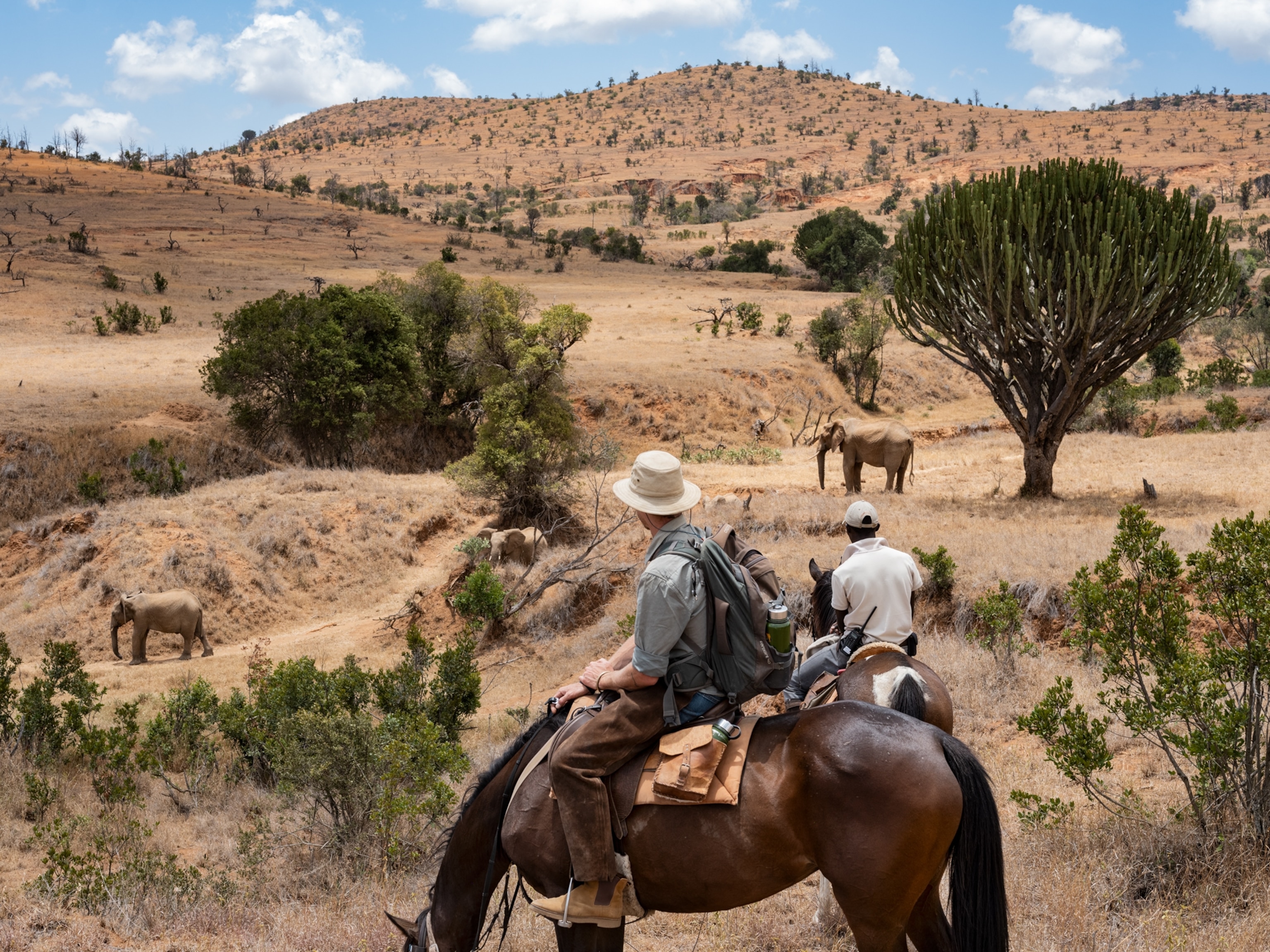
See Kenya’s wildlife in a different light: on horseback

9 new cruise itineraries for 2024
- Environment
- Paid Content
History & Culture
- History & Culture
- Terms of Use
- Privacy Policy
- Your US State Privacy Rights
- Children's Online Privacy Policy
- Interest-Based Ads
- About Nielsen Measurement
- Do Not Sell or Share My Personal Information
- Nat Geo Home
- Attend a Live Event
- Book a Trip
- Inspire Your Kids
- Shop Nat Geo
- Visit the D.C. Museum
- Learn About Our Impact
- Support Our Mission
- Advertise With Us
- Customer Service
- Renew Subscription
- Manage Your Subscription
- Work at Nat Geo
- Sign Up for Our Newsletters
- Contribute to Protect the Planet
Copyright © 1996-2015 National Geographic Society Copyright © 2015-2024 National Geographic Partners, LLC. All rights reserved
- Accessible Itineraries
Subscribe to our mailing list
Please select all the ways you would like to hear from Travel Breathe Repeat:
You can unsubscribe at any time by clicking the link in the footer of our emails. For information about our privacy practices, please visit our website.
We use Mailchimp as our marketing platform. By clicking below to subscribe, you acknowledge that your information will be transferred to Mailchimp for processing. Learn more about Mailchimp's privacy practices here.

- Living with LAM
- Destinations
- Accessible travel
Trip planning
Planning a world trip itinerary.
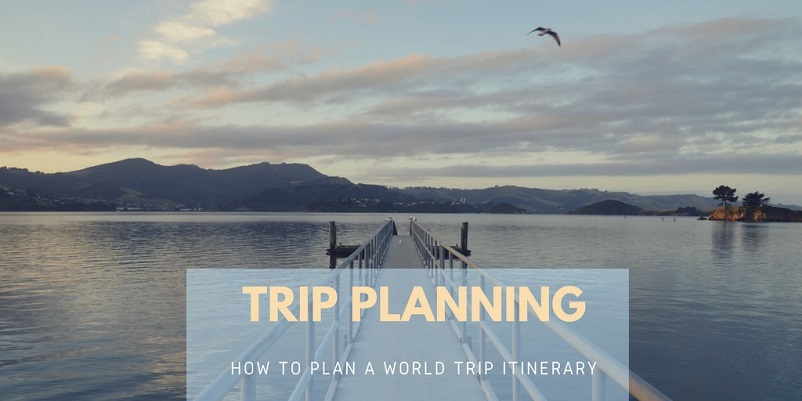
Last Updated on 12th November 2019 by Sarah and Justin
So you’ve decided you want to quit your job and travel the world. But thinking about where to go and when and for how long is completely overwhelming. Planning a world trip itinerary can indeed be daunting. It’s easy to get completely confused and overloaded by the vast number of choices you have. But with some organization and tips, it can be done, and more importantly, it can be fun!
We spent 13 months traveling to 27 countries in Europe, Asia, and Oceania. Figuring out where we wanted to go and in what order took quite a bit of planning. In fact, we started planning about 9 months before we left. But once we established some ground rules, we really enjoyed it. So based on our experience, we’re offering tips to help you get organized, get inspired, and have fun planning your trip around the world.
What type of traveler are you?
The first question to ask yourself is how you like to travel. And there are many different components to this question.
Planning style
Are you a super planner or are you a fly-by-the-seat-of-your-pants traveler? If you like everything all figured before you get somewhere, this whole post is for you. If you like to wing it, you may find some of these recommendations a bit much, but the general principles should help guide you. We definitely fall more into the planner category. Due to our own accommodation preferences, budget restrictions, and Sarah’s chronic disease , we needed to plan where we were going and when before we got there. We couldn’t easily just hop a plane from one country to another without notice (Sarah must get advanced approval to fly with her medical device). And to get the most options and the best deals, we always booked accommodations in advance. It worked out that for most of our trip, we had things planned around two months in advance.
Pace of travel
Do you like to spend time really digging deep in a place, or do you like to see lots of different destinations? We started out as the latter type of travelers, and would try to hit as many cities as possible in one vacation. However, as time passed on this trip, we definitely turned into slower travelers. First and foremost, long-term travel is tiring, so it’s nice to give yourself time to rest. Second, jetting from one place to another (between cities, countries, and continents) can give you some sensory overload and confusion. It will take you longer to adjust to a destination. Based on all of this, we tried to mix up how long we spent in places.
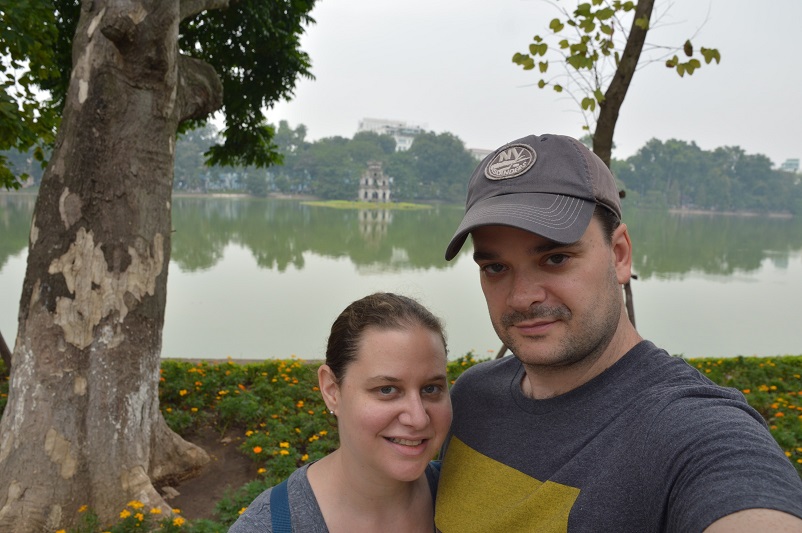
What do you like?
Spend some time thinking about what you actually enjoy doing and seeing in travel and in life. Try not to feel like you have to do something just because it’s trendy or because you’ve heard it’s a must-do on a round the world trip. This is your trip. It’s your time, energy, and money so you should go where you want to not where you think you should.
Itinerary planning tools
Before you even start thinking about specific destinations, get organized. To give you some ideas, here are the things we used to help plan our trip.
Microsoft Word calendar template
We used a calendar to map out every day of our trip. In every square, we wrote the city we would be visiting. We started more generally, week by week. But then adjusted it to be specific to the day. It was a helpful way to visualize how long we would be places. And it was also useful to see days of the week in addition to dates. For example, if we were going to be somewhere a bit off the tourist track, we considered not leaving or arriving on a Sunday. Or if a place was known for its party scene, we’d try to be there mid-week. We also used this to track our Schengen Zone days (more on this in the visa section below).
Excel spreadsheet
We’re both big dorks who love spreadsheets. So we made a massive one to track absolutely everything related to our trip including all of our finances (and kept it updated throughout our whole trip). But since post this is about itinerary planning, we’ll focus on that. Before we left home, we pre-booked the first two months of the trip. We used the spreadsheet to track what we had booked (and whether we had pre-paid or not) so we knew what gaps we had to fill in once we got on the road. And of course, we color coded everything so that at a glance we could easily see what we had booked, how much we had spent, and what was left to do.
Google Maps
If you’re a traveler, Google Maps is your best friend. We used Google Maps for both logistics and inspiration. For many parts of the world it will tell you how to get from A to B, but also, once you figure out that it actually takes 27 hours to get from A to B, it can help you find places to stop and explore on the way… places you’ve never even thought of! As an example, several years ago, we were planning a trip and wanted to drive from Gdańsk, Poland to Kaunas, Lithuania. Since Justin is the sole driver on our trips, we knew we’d need to stop for the night somewhere in the middle. We jumped on Google Maps and searched for somewhere centrally located that might also be pretty. We saw a very small lake on the map, zoomed in, and found Gizycko, Poland. After some additional research, we learned there was also a forest, some castle ruins, and a great hotel complete with a bowling alley. Of course it ended up being one of our favorite spots and we never would have found it without doing some serious map investigation.
Google Flights
Sure, Google Flights is great to use to find great deals on flights, but even before you’re ready to do that, it’s a fantastic itinerary planning tool. If we knew we would be in location A and were trying to figure out the best place to go next, you just plug in location A and Google Flights will tell you everywhere you can fly to. And you can filter for direct flights. It’s helpful if you have a list of potential destinations in mind or to get inspiration to new destinations you may have never consdered. Note, we recommend using it on a good old fashioned computer not a mobile device.
Itinerary planning considerations
Once you’re organized, it’s time to do the fun stuff – finding all those amazing places in the world to visit. A combination of dreamy wanderlust and detail-oriented logistics is required. Here is everything we considered when planning our 13-month trip around the world.
Determine your must-see destinations
For most people, a trip like this is a once-in-a-lifetime thing. So make the most of it! Start with your bucket list – what’s a place or experience you’ve always dreamed about? Our #1 bucket list destination was New Zealand, so we knew we absolutely had to get there on this trip. And seeing the temples at Angkor in Cambodia was pretty high on the list too.
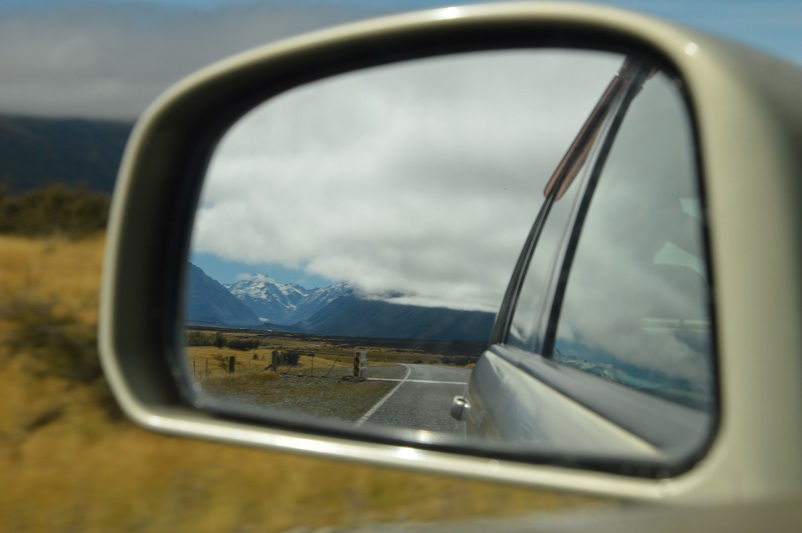
After the bucket list, you can move onto the rest of your wish list. This might include countries you’ve never visited or places you know you must return to. In our case, we had never been to Southeast Asia so knew we wanted to spend time in that region. And we loved our first visit to Tokyo, so wanted to get back there again and explore more of Japan (and eat more ramen and sushi).
Where to look for inspiration
Chances are you’ll need some inspiration to decide on places to visit. Good thing there are gazillion places these days to do that. When we were planning, we focused mainly on established travel websites like Rough Guides and Wikitravel, and region-specific websites like Travelfish (for Southeast Asia), Japan Guide, and New Zealand’s tourism website. We also devoured travel blogs of people who had done similar trips. Now, just a few years later, there are blogs for pretty much every destination out there, so it’s easy to quickly get some key information and see some pretty pictures to decide if it’s for you or not. Plus using Instagram and Pinterest to get travel inspiration is now quite common and easy. But we would recommend not just using pictures to guide your journey. Read up on the places that pique your interest so you know what there is to do, how long to spend there, and what a place is really like.
Cross destinations off your list
There will be places that, no matter how much you’d love to visit them, just won’t be feasible to see on this trip. It could be due to budget or geography or logistical complications. Take the time to figure out what they are and remove them from consideration. It might be sad, but it’s a must-do in this process.
Make note of major life events and necessities
Is your sister having a baby? Is your best friend getting married? Do you want to be home for the holidays? These are all questions you should ask yourself and answer before you get into the nitty gritty of planning so if there’s somewhere you really want or need to be at a specific time you can work that into your itinerary. Similarly, if you are like Sarah and have a medical condition that you must manage in a specific way, think about that as well. We returned home for a number of reasons, but the most important one was to see Sarah’s LAM specialist for her bi-annual check-up.
Decide if you want to do a round-the-world ticket
A round-the-world ticket is a great option if you can continue moving in one direction throughout your journey. It doesn’t allow for backtracking (on that ticket). We knew we’d be returning home two times during our trip, which pretty much ruled out the round-the-world ticket for us. But if you don’t have any reasons to backtrack, it’s a good option to consider. If you decide you want to do it, you’ll have some constraints about where you can go and in what order. All companies and airlines offering round-the-world tickets have different rules, so do your research to understand the ramifications before you decide.
Research any visa restrictions
As American citizens and US passport-holders, we were lucky that the only visa requirement that significantly impacted what we wanted to do was the Shengen visa. We could only remain in Shengen Zone countries for 90 days within a 180 day period. We tracked these days carefully during our planning and used our handy dandy calendar template by adding a number in a different color to every day we would be in the Schengen Zone. A few other countries we visited had restrictions. For example, Australia, Japan, New Zealand, and Thailand all restrict the number of days you can stay consecutively, but this didn’t impact our itinerary. Additionally, there were several countries for which we had to buy visas. For Vietnam and Australia, we had to buy visas in advance. For Laos and Cambodia, we could buy visas upon arrival at the airport. These costs and processes may or may not impact your itinerary, but it’s good to be aware of them. The visa for Vietnam was quite expensive, and in retrospect, we should have stayed in the country longer to make the most of it. Last, certain countries require that you have booked a way out when you arrive. We were asked to prove our onward travel plans in South Korea and New Zealand but have heard this can be the case in Thailand as well. This is worth researching and deciding if you want to do some advance planning or take the risk of having to buy a plane ticket while standing at the immigration desk.
Consider your budget
Setting a budget is definitely the first thing you should do in the planning process. Because unless you have unlimited funds, your budget will impact every aspect of your world trip, including your itinerary.
When considering how our budget would impact our itinerary, we broke things down into three categories: transportation, lodging, and living expenses. We started with transportation and figured out the biggest ticket items – our longest flights. We also looked at the places we could travel overland or take budget airlines and came up with a general number. Next, we moved onto lodging. We established a per night average we wanted to stick to across the entire trip. We did a lot of research on hotel booking sites and Airbnb and came up with estimates for each of the major destinations we knew we wanted to visit. And last, we read up on cost of living in those destinations too.
All of that helped us decide how long we would spend where. To state the obvious, certain places in the world are more costly to visit than others. We would have spent much more time in New Zealand and Australia and the Faroe Islands if money were no object. But planning a trip like this, you’ll have to make compromises. Having a lodging average was helpful because if we knew certain places would be higher than that number, we would work to compensate for it in places with more affordable options.
It’s a lot of work, but if you do your research, you’ll feel more comfortable with your decisions and you (hopefully) won’t be blindsided by expenses that have negative consequences for your journey.

Get a good handle on your loyalty program points and airline miles
This step also falls into budget planning, but it can be very helpful when you’re itinerary planning too. We had a lot of miles and points, and we wanted to use as many of them as possible to save money on our trip. But we also actually got some great ideas for our itinerary by looking into all the options associated with our programs. For example, we knew we were going to be in Southeast Asia in December and that we wanted to go home for the holidays prior to further exploring that region. We also love German Christmas Markets. By looking into reward flight options we (okay, it was Justin – he is a master at all this) found an amazing way to accomplish this on miles. All on one reward ticket, we flew from Bangkok to Frankfurt, spent three weeks in Germany, then flew from Frankfurt to New York, spent three weeks there, and then flew back from New York to Bangkok.
Oh and yes, we used a spreadsheet to track all of our points and miles.
Consider the weather
Think about what climates you prefer to travel in, as well as what different places are like during specific times of year. The seasons are flipped in South America, Australia, and New Zealand. There are different rainy seasons in certain countries in Southeast Asia. In Northern Thailand, there is a burning season which we wanted to avoid since we knew would be particularly bad for Sarah’s lungs. Traveling in and among all the seasons means you’ll have to pack more (or buy local supplies). All of these things helped us figure out where we wanted to go when. We found Weather Underground very helpful, especially their monthly averages and historic temperatures.
Planning your world trip itinerary
Finally, after all that, you’re ready to actually start planning your trip. Using all of the above considerations, start big and general. Think about when you want to depart and the regions of the world you want to visit. Using Google Maps and a calendar, see what makes sense. And then, create a skeleton itinerary. Our first skeleton itinerary looked like this:
Leg 1: 3 months in Europe (then return home) Leg 2: 3 months in Asia (then return home) Leg 3: 6 months in Asia, Australia, New Zealand, South America
It might be scary to write something like this down, but don’t panic – this is just an outline, and of course you can change it! In the end, we actually didn’t end up going to South America.
Next, start looking at the logistics of traveling from point to point and between the specific countries and cities you want to visit. Use Google Maps and Google Flights to understand the best ways to travel between destinations and the distances and times involved.
And then it’s time to get detailed. Country by country, city by city, write down where you want to go. Then look at accommodation options in those cities. That will help plan specifically how long you want to be in certain places too. For example, we found really great Airbnb options in Krakow and Warsaw, and they were even cheaper if you stayed a week, so we decided to keep our time in Poland to those two cities instead of adding a third city in the middle. Conversely, when we were in Auckland, NZ our accommodation of choice was only available for three nights, so we kept our stay there brief.

Finally, start booking. Yes, in the beginning this can be quite nerve wracking! We nervously hit that first “confirm” button together and then celebrated with a stiff drink. But after a few times, it’ll be just like booking any other vacation. Just consider how you want to book things. Most often you can save money if you make non-refundable bookings, but if you’re not 100% set on your itinerary, you might have to spend a little more to give yourself some flexibility. If you’re using Airbnb, be sure to read the specific cancellation policies because they have a whole bunch of different ones. And of course, keep a detailed account of everything you’ve booked, if you’ve prepaid, and any cancellation deadlines. We also found it helpful to keep track of how we booked things. We used pretty much all the different hotel booking websites out there, so it made it easier for us to pull up confirmations when we needed them.
Before we left Brooklyn, we booked all the flights, long, international trains, and car rentals for our first leg, plus about two months of accommodations. We followed a similar planning system until our third leg, when we landed in Bangkok without a plan. Eek! Based on how we like to travel, we honestly found that lack of structure a bit stressful. Sometimes we felt like we were spending too much time figuring out our next step instead of enjoying where we were. But it all worked out and there wasn’t anywhere we felt we missed out on because of this.
So that’s it! We hope you feel more comfortable planning your own trip now. It might be a lot of work, but it’s definitely worth it.
We’d love to help with your planning. Ask us any questions in the comments!
Like this post pin it.

Sarah and Justin
11 thoughts on “ planning a world trip itinerary ”.
I love that you guys “celebrated” your bookings with a stiff drink! LOL! We could totally hang! 😉 Great tips on getting started with trip planning – I started with SE Asia, but ended up falling in love with the region, I never left! Someday when I save more money I hope to make it to other parts of the world…
Haha we’ll meet you for a drink anytime! Especially in SE Asia – we’re dying to get back and spend more time there.
Love this. It can be so overwhelming to even start to think about planning a long break. Love how you have given really practical tips and information.
Thank you! We’re glad you found it helpful and agree with our recommendations!
Hi Sarah & Justin, You’ve done an excellent job in showing people what to consider when planning a world trip. Undertaking such an adventure can be very daunting. Without a doubt, weather considerations, family events & medical needs are very important. Well done in compiling such a comprehensive post.
Thank you for such positive feedback. Some of these things are basic trip planning things but it can all seem overwhelming when trying to do it on such a grand scale! Just important to keep organized.
Great info and tips here Sarah. I really like that you tell folks to cross things off the list as we all try to do too much and travels are more enjoyable when you slow down a bit (or a lot!)
Thanks! We have a hard time slowing down and editing ourselves but once we do we are always rewarded with richer travel experiences.
Pingback: How to Travel Around the World and Plan an RTW Trip - 52 Perfect Days
Pingback: "It's in My Blood": Sarah Poitras - Round the World with a Lung Disease
Thank you for this great and profound information. I’m so happy you were brave and courageous to live life
Leave a Reply Cancel reply
Your email address will not be published. Required fields are marked *
This site uses Akismet to reduce spam. Learn how your comment data is processed .

Ultimate Around the World Itinerary | 1 Year Around the World
By: Author Charles
Posted on August 25, 2023
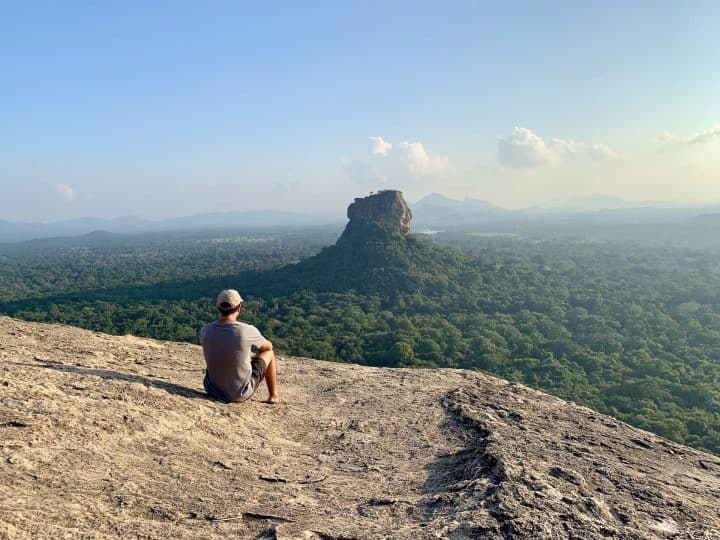
In March of 2019, I quit my job, packed a couple of carry-on bags, and took a one-way flight to Auckland, New Zealand to begin my around the world itinerary.
Over the course of the next 375 days, I traveled to 20 countries and countless cities in 6 continents. I put together this post to walk you through the exact route, and how it all came together the way it did.
Whether, you are just interested in reading along, or you would like to put together an around the world itinerary for yourself, I hope this can inspire you!
* Affiliate Disclosure : This post may contain affiliate links, which means I may receive a commission if you make a purchase through the links provided, at no additional cost to you. Thanks for supporting the work I put into TripTins!

1) Around the World Itinerary Overview
I knew from early on in my career that travel was a very important aspect of my life. I didn’t know at the time though, that I would have it in me to quit my safe corporate job of 6 years and travel for an extended period of time.
Instead of taking those few 10-day vacations and always looking forward to just taking that next trip, I thought a full year of solo travel would be the right move for me. I could visit places that would have taken years for me to get to, and challenge myself consistently along the way.
So, on March 13 2019, I hopped on a flight from JFK to LAX and then onwards to Auckland, New Zealand (essentially as far as one can get!). Over the course of the next 12 months, I got to experience some of the best travel moments of my life.
Whether it was meeting locals, exploring cities, hiking high into the mountains, trying new foods, engraining myself in new cultures, or hanging out with like-minded travelers. The one year of travel ended up being the best decision of my life, and one of the reasons, this site came to be .
Around the World Stats Days: 375 Countries: 20 Cities: ~100
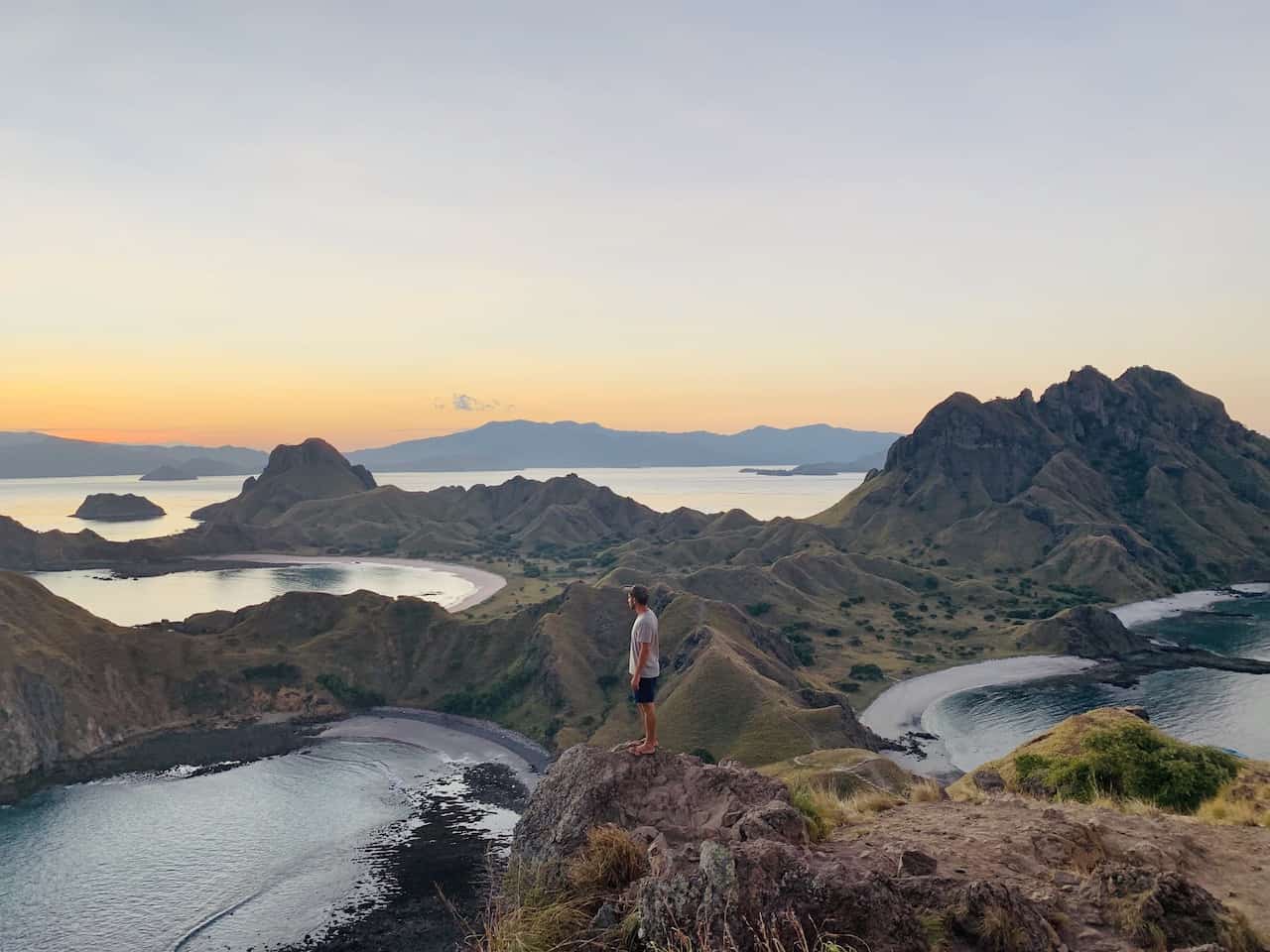
2) Travel Considerations
As I planned the trip, there were a few “main” aspects that I was sure to plan the trip around. These included – weather, local holidays for & peak seasons, logistics, among a few other considerations.
Probably the most important aspect of the around the world itinerary, was making sure I was visiting countries during the best time of year from a weather standpoint .
I did not want to go through all of this, just to visit countries when it was rainy season or when I couldn’t take part of certain activities.
For example, I made sure to visit Nepal during November when the weather was at its clearest (but quite cold) and there was little risk of rain and clouds ruining the trekking views. I made my way to the Philippines at the tail end of the dry season and Costa Rica at the beginning of their dry season.
At the end of the day, it was all about being able to fully enjoy my time in each place on a day to day basis and not have constant days where the weather wouldn’t allow me to do anything.
With that said, the weather is unpredictable and you never know what it can bring (no matter how much you plan). There were certainly days I was completely rained out of doing anything, and times where I had to move things around last minute to circumvent the weather.
But by initially planning the trip to avoid poorer weather conditions, I feel as I was really able to get the most out of the journey.
Local Holidays & Seasons
Another thing that I considered is to avoid traveling to countries during the local’s national holidays . While dealing with tourists is one thing, dealing with a whole country traveling at the same time is another.
This isn’t across every country out there of course, but for some countries during these holiday times, many locals decide to travel for themselves.
This results in less availability for hotels and more expensive prices altogether . A couple that come to mind are Golden Week in Japan and Holy Week in the Philippines.
I will caveat that with saying, sometimes it can be a great experience to take part of certain local celebrations if that is what is of interest to you.
In addition to holidays, I also tried to avoid peak season when most tourists are traveling to a certain destination .
Now, this is certainly not avoidable if traveling for a year, but it can help to steer clear of some places during those peak seasons.
Instead, I tried to visit places during shoulder seasons, as the weather is great but just less people are traveling to these places. At the end of the day it is just picking and choosing what works best.
The last main consideration when planning the trip was the logistics side of things. I just wanted to be sure that there was an easy way to get between city A and city B .
Whether that be a plane, boat, train or bus, I just didn’t want to put myself in the position where I would have to go drastically out of my way to continue on with the next city or country.
To the best of my abilities, I attempted to book direct flights when possible . I remember in the Philippines for example, there were not direct flights between certain islands or they were not operating every day of the week. I had to put the itinerary together so I was not wasting full days just to get between two islands.
If I was renting a car, and I was taking a one way route through a country (such as Austria), I had to be certain that I could pick up and drop off the car in two separate locations without a hefty fee.
With that said though, there were certainly times where I had to compromise with logistics. If I really wanted to travel somewhere but it would take days of traveling, I had to be fine with that. It all becomes a balance between everything .
Other Considerations
Also considered in the travel planning was the flexibility and having time to just unwind without anything planned. While I put together a list of countries and things I wanted to do in each country, I never had it written out to a tee.
I consistently moved things around as I went and sometimes did not even have a set date to leave a country I was in. Having that flexibility helped big time when things didn’t go 100% according to plan .
I also wanted to be sure that I had time to just rest and recover . For the majority of the trip I was out and about from morning until night. All of that traveling can take a toll on the body.
So, you will see times in the itinerary where I may have stayed longer than one may expect just to have time to do nothing and all.
When I combined the weather, holidays, and logistics, an itinerary began to form that I continuously worked on for months leading up to the trip.
→ Learn more: check out the planning a trip around the world and around the world cost guides for many more considerations when putting together an itinerary, as well as my around the world packing list
With that said though, there were some things that I had to plan around, making this around the world trip a bit more difficult to plan out than initially expected. See the next section for more on that…

3) What I Planned Around
Now, the around the world itinerary didn’t come without any hitches. There were a few things that came up which altered my initial travel planning.
Timing is never perfect to take a full year off from your friends and family. And there were certain events that I just had to come back for. Due to this, you will see a bit of interesting travel plans that the trip goes through.
» I spent October of 2019 back in the US as I had weddings to attend of close friends. Due to this I ended up staying the month back in the US before heading out again (and did get to visit NYC, Philadelphia and Chicago during my time back). Then again in December 2019, I came back again, but this time just for a quick weekend.
» On top of that, my trip was originally going to be closer to 15 months of travel. As we all know though, Covid started to ramp up in March of 2020. The end of my trip was a bit hectic trying to figure out where to go and what to do. But on March 20, 2020 I ended up taking one of the final flights out of South Africa before the world went into lockdown.
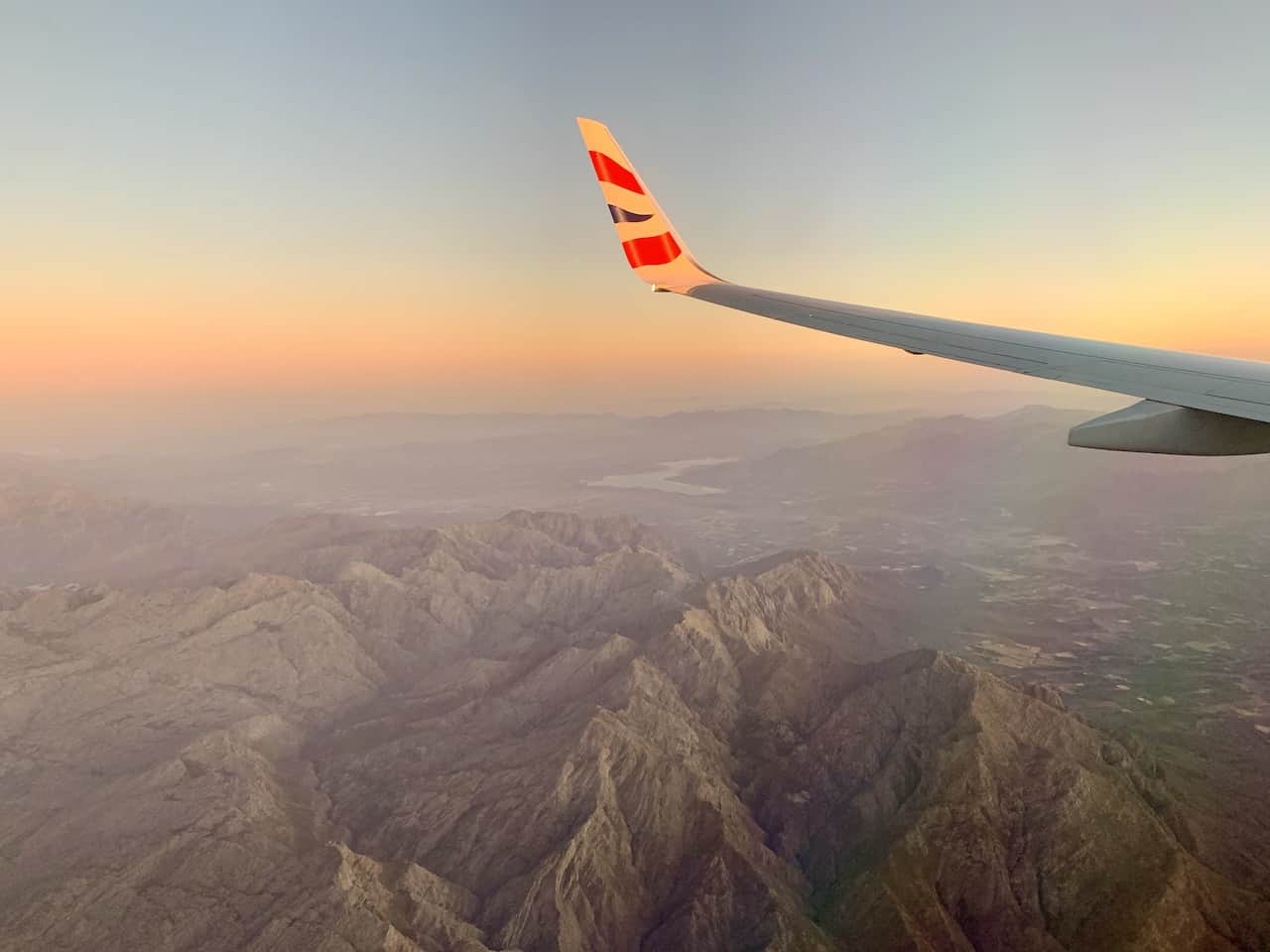
4) Around the World Itinerary Details
From start to finish the trip lasted 375 days with 329 days outside of the country. Over the course of those 375 days I visited 6 continents, 20 countries, and upwards of 100 cities. I ended up splitting out my trip in five phases:
Phase 1 : NZ/AU/Asia Phase 2 : Middle East / Europe Phase 3* : Nepal Phase 4 : Central and South America Phase 5 : Asia/Africa -> cut short
→ *I returned home before/after I traveled to Nepal
Below is the country by country route I took along with the number of days (including days to travel to them). Throughout the remainder of the post I will go into detail about where I decided to travel to in each country.
Country #1: New Zealand (29 days) Country #2: Japan (12 days) Country #3: South Korea (11 days) Country #4: Philippines (20 days) Country #5: Indonesia (30 days) Country #6: Australia (21 days) Country #7: Singapore (4 days) Country #8: Israel (17 days) Country #9: Jordan (4 days) Country #10: Austria (10 days) Country #11: Germany (6 days) Country #12: Slovenia (11 days) Country #13: Croatia (15 days) Country #14: Montenegro (10 days) Country #15: Nepal (26 days) Country #16: Belize (17 days) Country #17: Costa Rica (24 days) Country #18: Argentina (21 days) Country #19: Chile (11 days) Country #20: Sri Lanka (24 days)
Bonus : South Africa for 5 days until I had to take an emergency flight back home on my final day
Some of my travel plans would not necessarily look efficient on paper (Chile to Sri Lanka for example). However, given I did need to make some stops back in the US as I spoke about earlier, and with Covid ending the trip early, the trip doesn’t always make perfect sense without knowing the details.
You can see that I did spend quite a bit of time in many of these countries (24 days in Costa Rica). Like I said, when planning the trip, I did not want to rush myself in a country.
I wanted to truly enjoy all different aspects of where I was . I also wanted to be sure to have enough “rest” days, to just spend time to regroup and reset before continuing on.
You may find many itineraries out there that visit double the amount of countries in the same time period. But at the end of the day, each person has their own travel style and what they want to accomplish on a trip like this.
For me, it was seeing the world at my pace and really engraining myself in each country I visited.

5) Around the World Itinerary Map
Below is a map of each and every place I visited all along the year long journey. You not only can see the cities I visited, but you can also see nearly every attraction I got to visit along the way.
Feel free to zoom in for more details!
6) 1 Year Around the World Itinerary
With that all said, below is a breakdown of each country along with the main cities/attractions I got to enjoy along the way.
New Zealand (March 13 – April 10)
I started off the around the world itinerary by taking a one-way flight to Auckland, New Zealand and from there got to explore both the North Island and South Island of the country.
After spending a night in Auckland, I grabbed a rental car, and then began the journey from north to south. Along the way I was able to visit the following places:
• Auckland • Waitakere Ranges • Rotorua • Taupo • Tongariro Alpine Crossing • Wellington • Abel Tasman National Park • Punakaiki* • Wanaka • Te Anau • Queenstown • Mount Cook • Pukaki • Christchurch
* As I was making my way down the western coast of the South Island, a major storm caused mudslides and a collapsed bridge. I ended up missing out on Franz Josef and had to spend a day driving around the island to Wanaka. Always good to have the flexibility to change things on the fly!
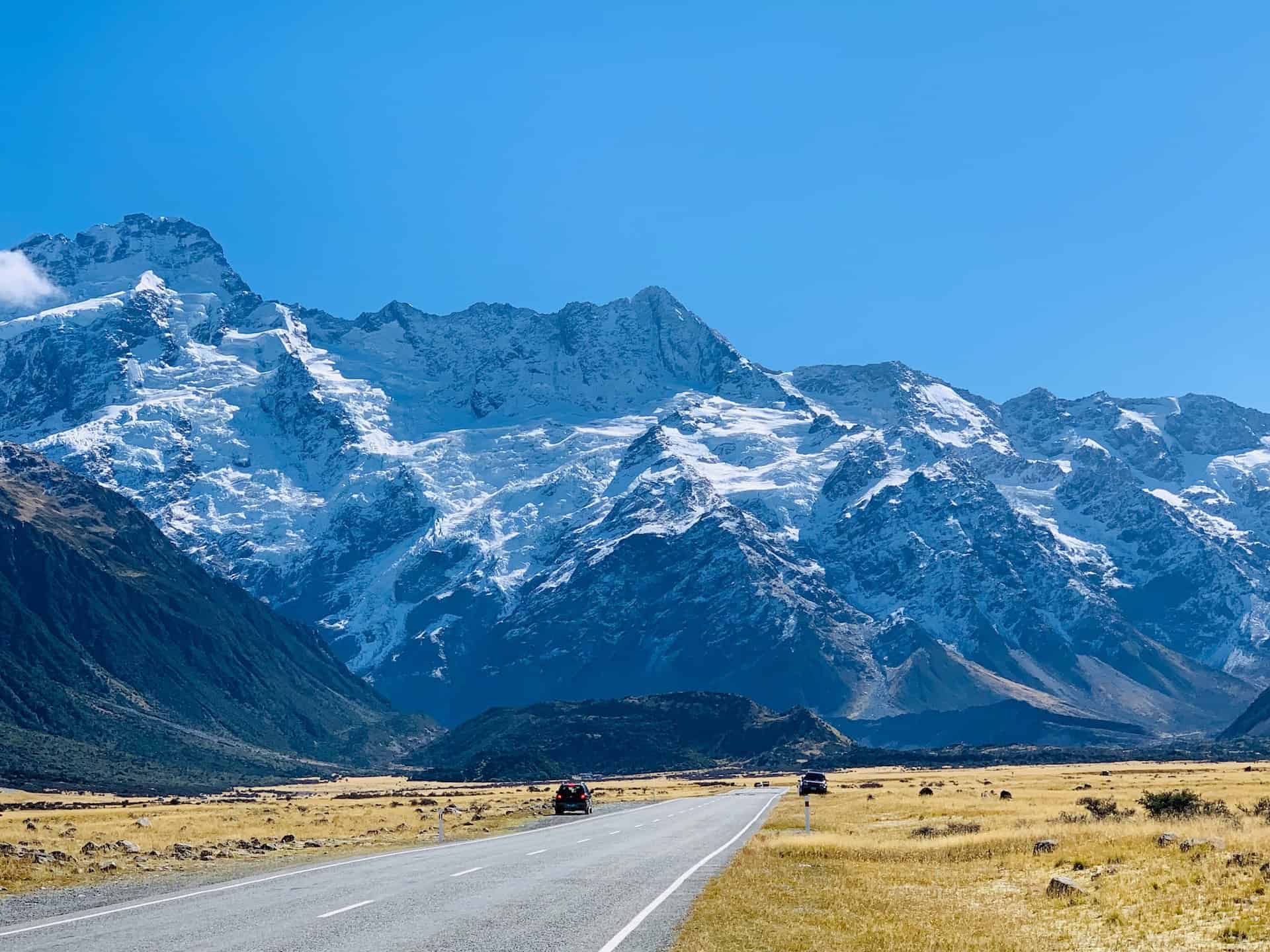
Japan (April 11 – April 22)
From Christchurch, I hopped on a flight to Tokyo via Brisbane. After a full day of travel, I arrived to Tokyo, where started my 12 days through Japan .
Since this was my second time in Japan, I did not spend as long as I might have if it was my first time. While I certainly went to some of the same places from my initial trip, I did not go back to places like Kobe, Hiroshima , Miyajima and Osaka.
However, I did get to visit a bunch of new places as well, and took the following journey through Japan:
• Tokyo • Kamakura • Hakone • Takayama • Shirakawago • Kanazawa • Kyoto • Nara
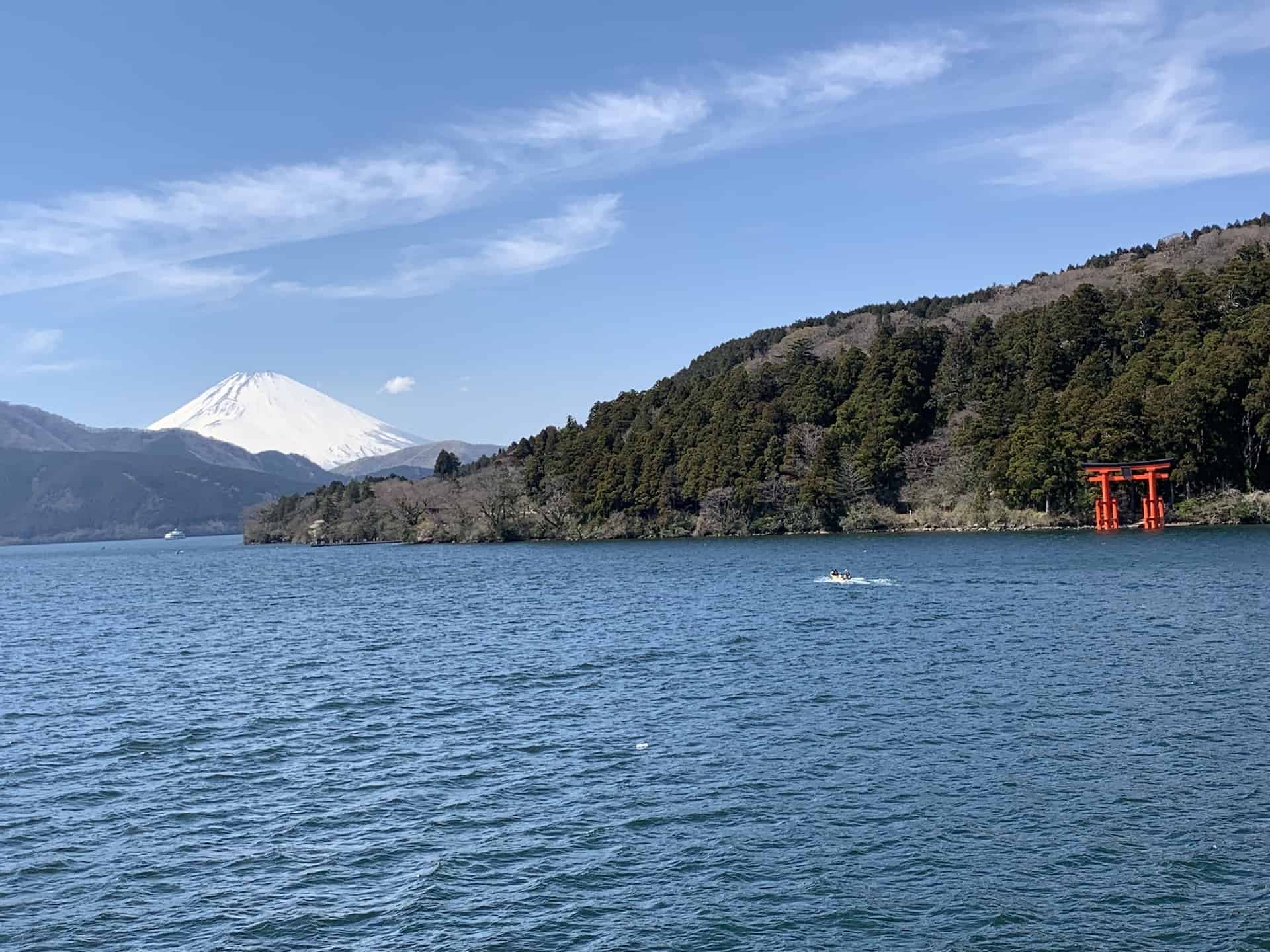
South Korea (April 23 – May 3)
It was then off to South Korea as I flew directly from Osaka to Jeju Island. Over the course of the next 10 days or so, I visited three beautiful places in the country:
• Jeju Island (+ Mount Hallasan hike !) • Gyeongju • Seoul
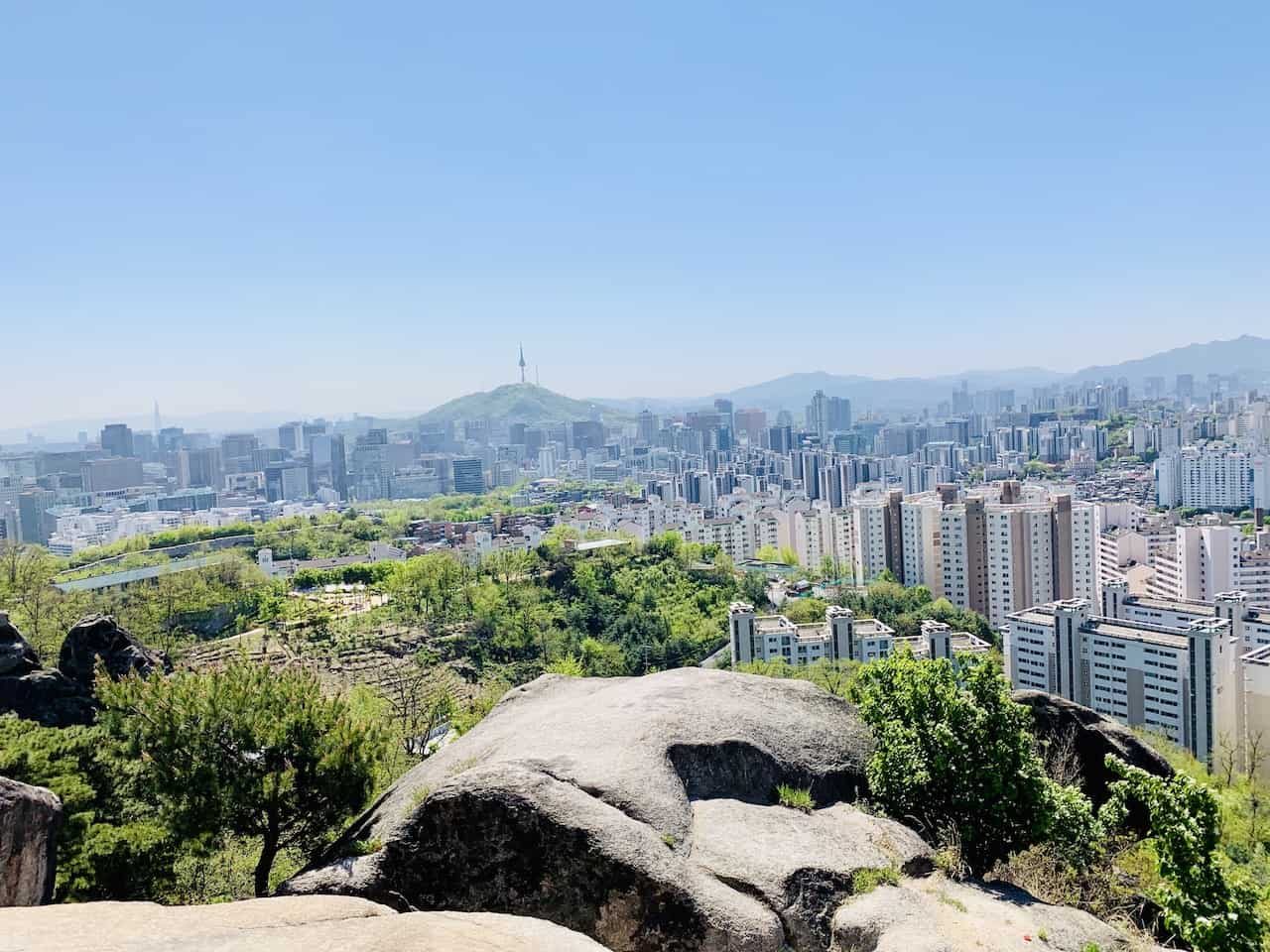
Philippines (May 4 – May 23)
After a successful time around South Korea, it was then onto the Philippines. It was all about the beaches, water, and island life during this portion of the trip.
As the rainy season starts in June, I got there just in time to fully enjoy the experience. Besides a few nighttime rain showers, it was all clear to enjoy some time in the sun. I ended up spending time in 4 different islands for around 4-5 days each.
Logistics were important here as it can get quite tricky to travel around the country. With a combinations of boats and direct flights, I ended up visiting these places:
• Coron • El Nido • Bohol • Siargao

Indonesia (May 24 – June 22)
You are only allowed to visit Indonesia for 30 days without getting a longer term visa, so that is exactly what I decided to do. I spent a full month exploring the country visiting many places along the way .
While 30 days does sound like a long time, Indonesia is a massive country. I can honestly spend a year traveling around the country and still have things to do. But during my month there I started on the island of Java and then got to visit:
• Yogyakarta • Lumajang / East Java Waterfalls • Cemoro Lawang / Mount Bromo • Banyuwangi / Ijen Crater • Munduk • Ubud • Nusa Penida • Gili Trawangan • Mount Rinjani • Komodo National Park
From Komodo, it was then a quick flight back to Bali , where I headed off to Australia for the next portion of my trip.

Australia (June 23 – July 12)
Australia was one country, where it was a bit tougher to pick a time of year that worked weather wise for various cities around the country. I could have gone right after New Zealand but found some of the logistics a bit too difficult to manage.
Either way though, while I did not have the beach weather for Sydney, all else went great in the cities further up north. Below were the places I traveled to during my few weeks in Australia :
• Sydney • Blue Mountains • Whitsundays • Cairns / Great Barrier Reef • Port Douglas • Daintree Rainforest • Uluru / Kata Tjuta • Kings Canyon • Alice Springs / West MacDonnell Ranges

Singapore (July 13 – July 16)
From Alice Springs I took a flight over to Perth for a quick layover before heading off to Singapore. I decided to split Singapore into two parts.
The first couple days I would spend sightseeing all around the city. For the second two days, I opted for a bit of relaxing and treated myself to two nights at the Marina Bay Sands hotel.
Overall, the four days in Singapore ended up great and got me ready for the next leg of my trip as I traveled all the way to Israel.
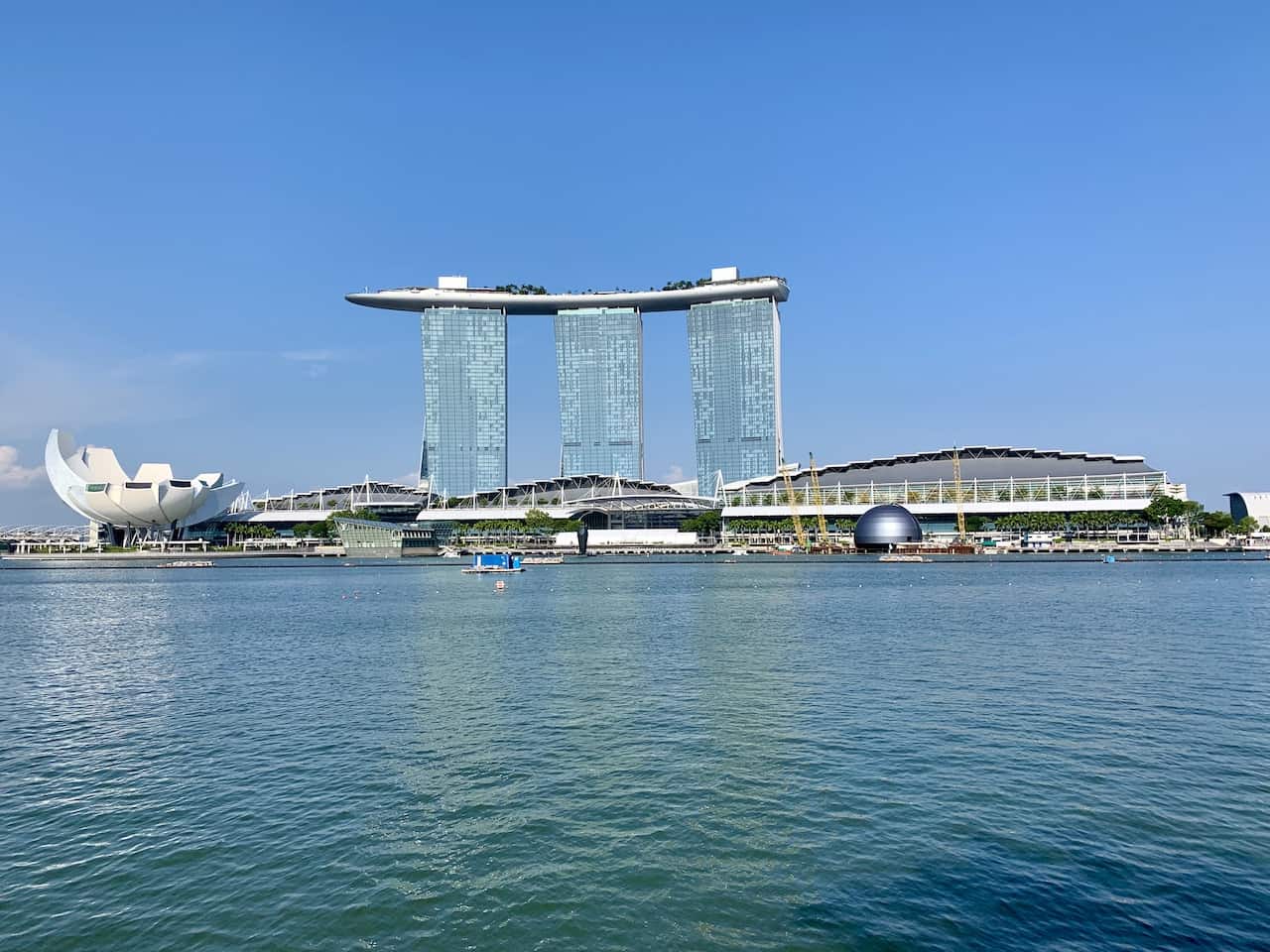
Israel & Jordan (July 17 – August 2)
When visiting Israel, I knew that I wanted to spend a few days in Jordan visiting a couple of the top sites.
So, I ended up traveling around Israel for 10 days, and then ended up in Eilat. From Eilat, I traveled into Jordan for 4 days and then re-entered Israel, where I spent another week.
While I could have figured out the logistics to be a bit more favorable, the three weeks between Israel and Jordan ended up something like this:
• Jerusalem • Ein Gedi / Masada • Dead Sea • Mitzpe Ramon • Eilat • Petra • Wadi Rum • Haifa* • Tel Aviv
* After visiting Jordan, I crossed back into Eilat, rented a car and drove all the way north to Haifa. I spent a few days exploring the northern coast and ended the trip in Tel Aviv for a few days of beach time.
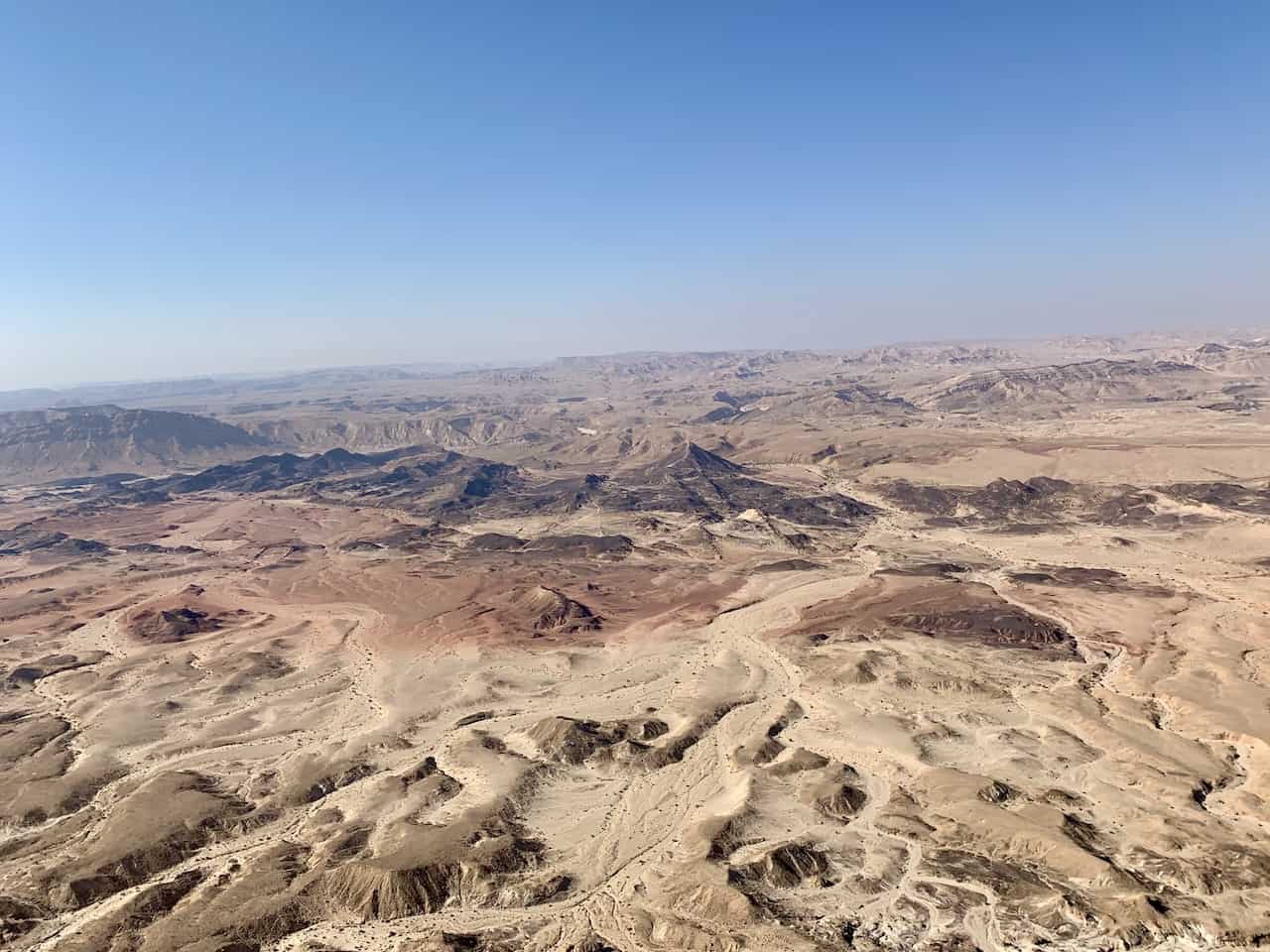
Austria & Germany (August 8 – August 23)
After taking a flight from Tel Aviv to Vienna, I spent the next 2+ weeks driving my way through Austria and the Bavaria region of Germany. I spent time in cities and out in the mountains, while visiting several places along the way:
• Vienna • Hallstatt • Berchtesgaden • Garmisch Partenkirchen • Mayrhofen
This is also a time where the weather did not always go according to plan. It was nice to have some extra days here in order to wait out the couple days of poor weather and then get up into the mountains.
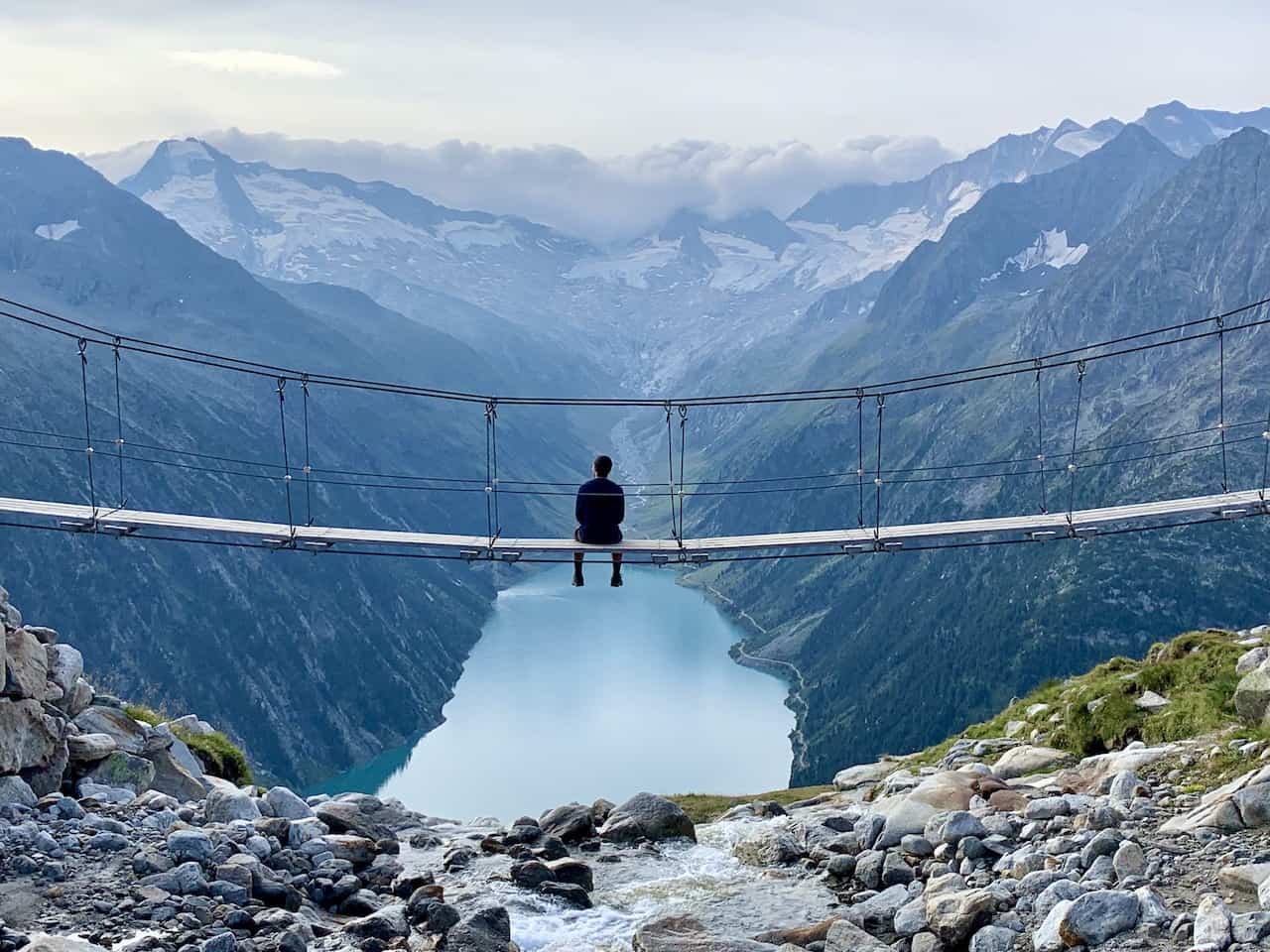
Slovenia (August 24 – September 3)
From Mayrhofen, I took the quick drive to Innsbruck, dropped off my rental car and then took a train over to Ljubljana. I spent the next 10+ days driving around Slovenia and enjoying all different aspects of the country including:
• Ljubljana • Lake Bled • Bohinj • Bovec • Piran
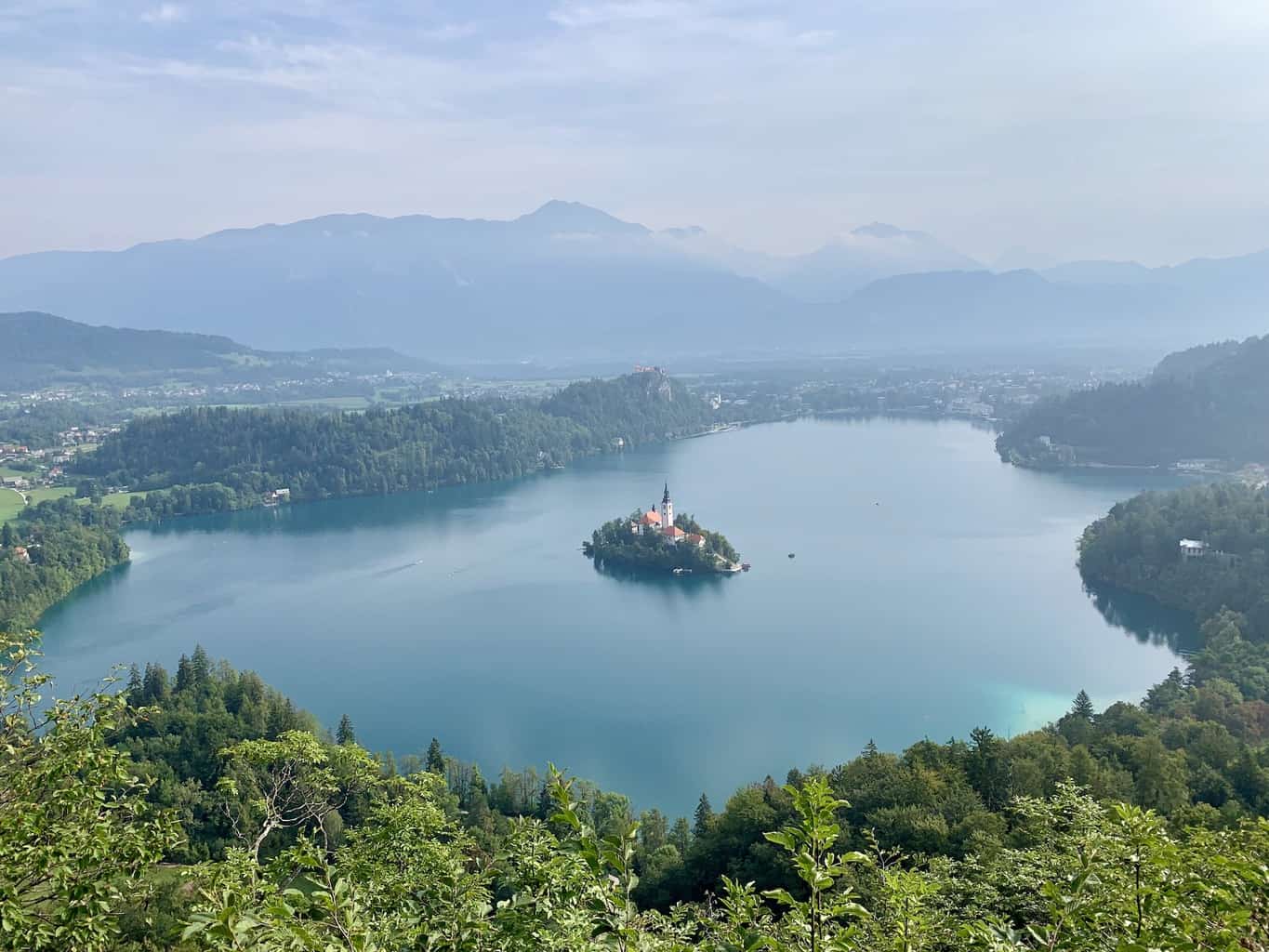
Croatia (September 4 – September 18)
A quick train from Ljubljana to Zagreb and it was then time to explore Croatia for two weeks . I opted against renting a car here and just made my way around the country using busses and ferries. Along the way I got to visit:
• Zagreb • Plitvice National Park • Zadar • Krka National Park • Split • Hvar • Korcula • Mljet • Dubrovnik
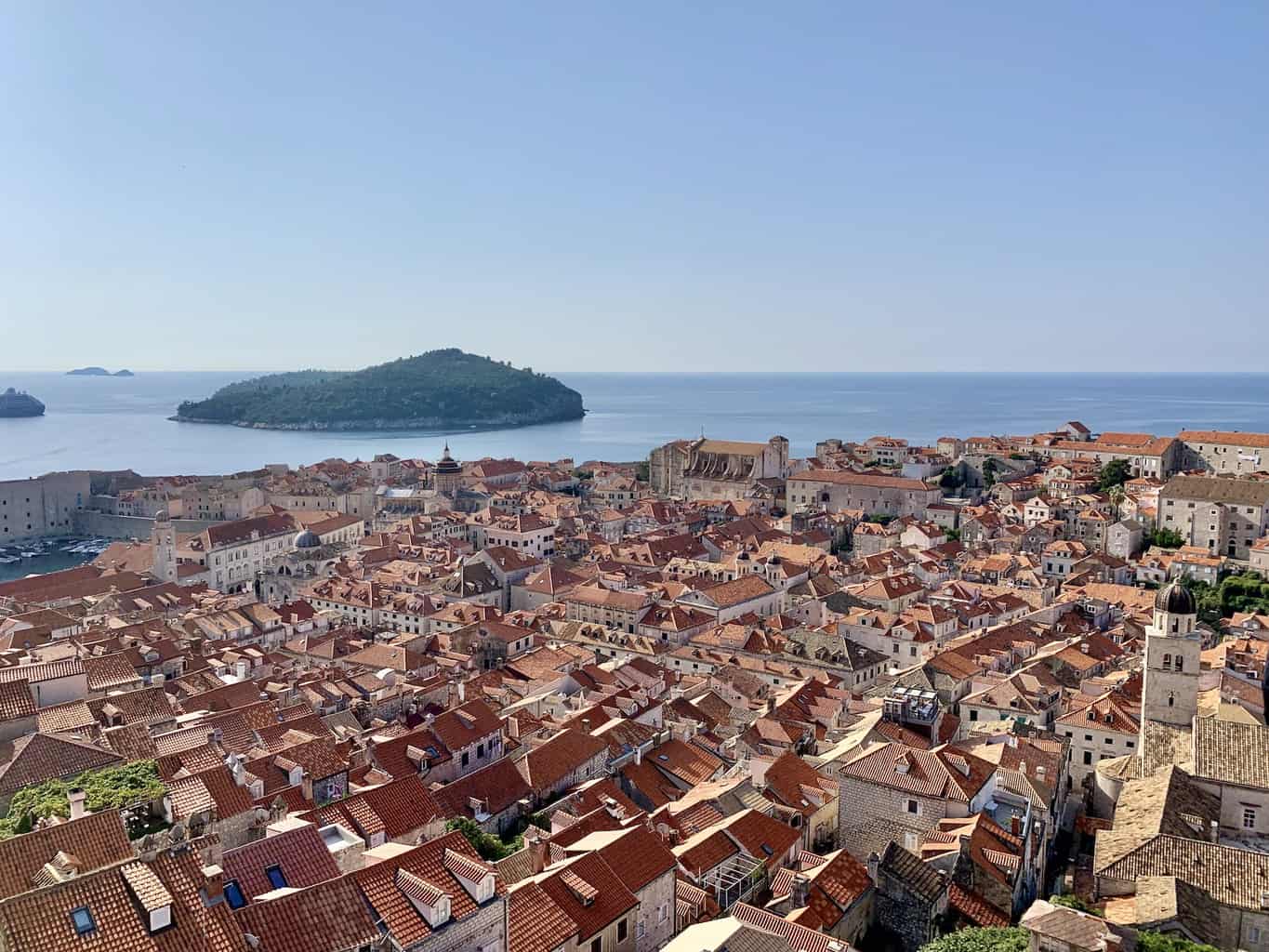
Montenegro (September 19 – September 28)
Montenegro was the last country on the first portion of my trip around the world . I took a bus from Dubrovnik to Kotor and then rented a car for the next 10 days. During those days I made my way to a few different places:
• Kotor • Durmitor National Park • Lake Skadar • Sveti Stefan
My last night of the 200 th day of my trip was spent in the small coastal town of Sveti Stefan, where I got to enjoy one last sunset before making my way back to the US for the next month.
After heading to a couple of weddings and traveling to cities like NYC, Philadelphia and Chicago, I then made the round trip journey to Nepal. Here is where I took part of the Three Passes Trek + Everest Base Camp.
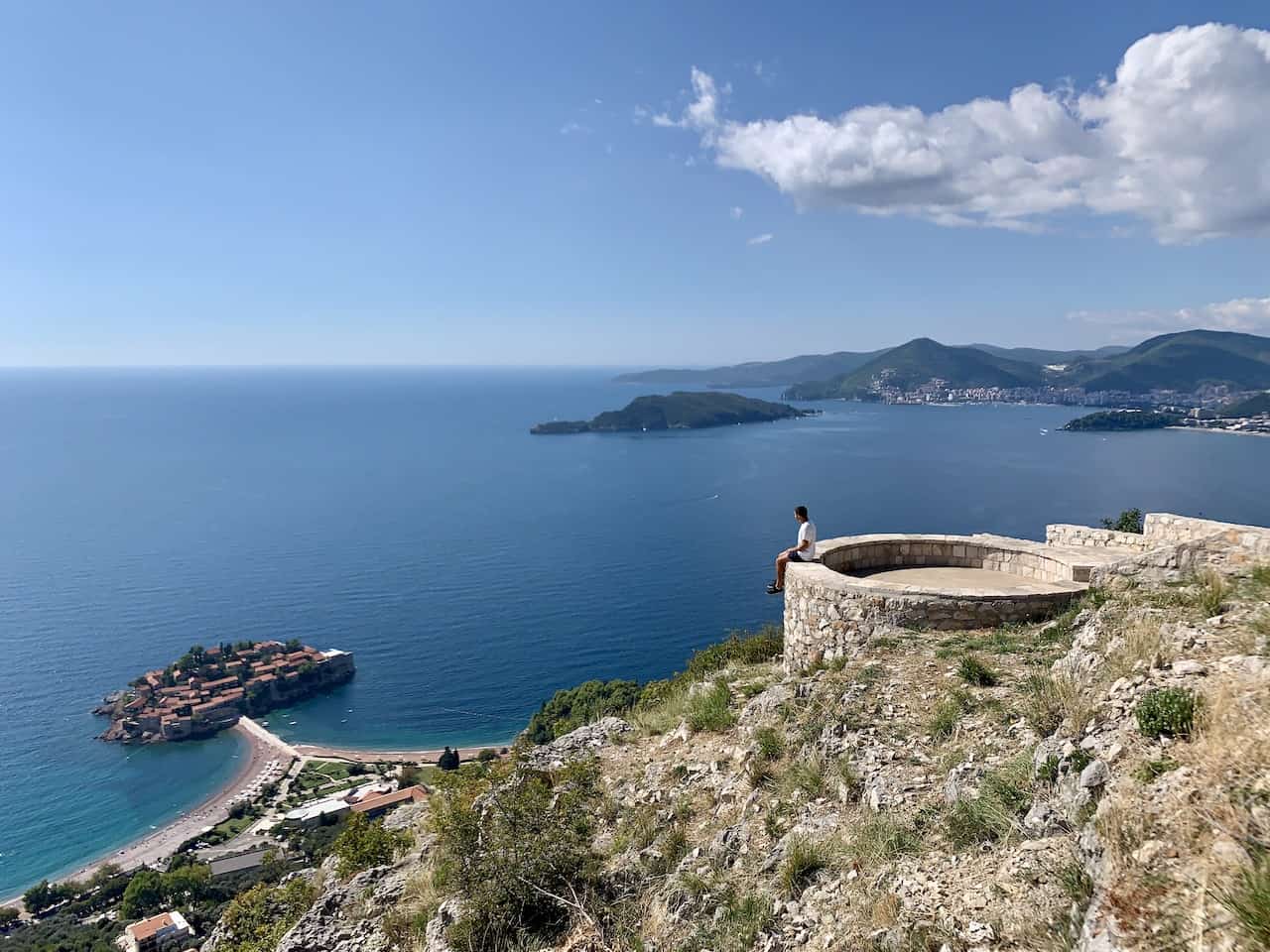
Nepal (November 11 – December 6)
Visiting the Himalayas had been a life dream of mine, and during this around the world trip, I finally got to experience some time there. I decided to go for the Three Passes Trek , which is essentially a longer version of the standard Everest Base Camp trek .
In addition to EBC, I got to head over the Kongma La , Cho La , and Renjo La passes, visit the Gokyo Lakes , and trek up peaks like Chukhung Ri and Gokyo Ri .
After three weeks of trekking, I had a few days of relaxing in Kathmandu before heading back for a quick weekend in NYC .
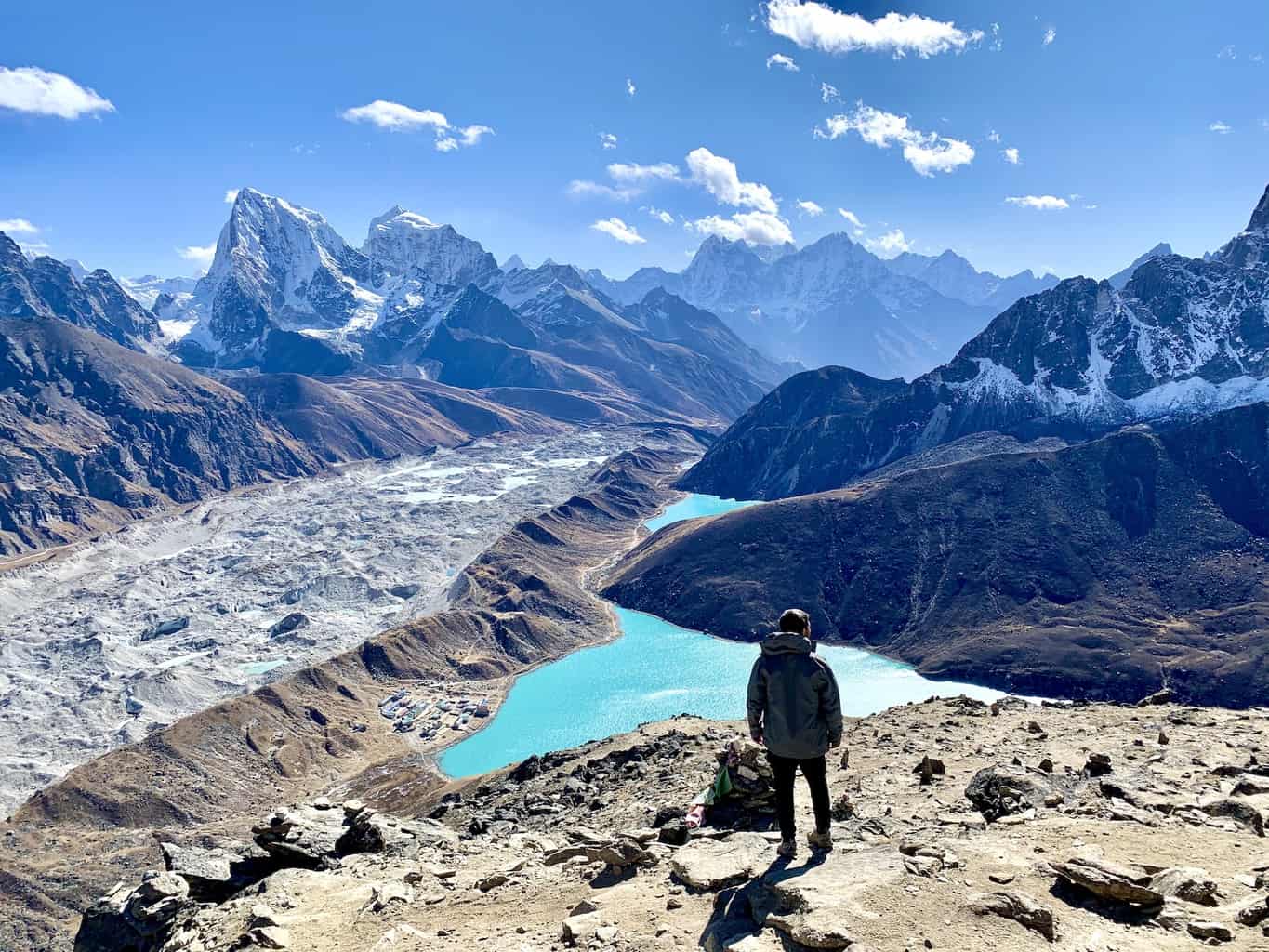
Belize (December 10 – 27)
It was then time to explore some of Central and South America, as I headed from New York down to Belize. During my time in Belize I spent several days scuba diving, visiting the inland of the country, and finishing up at the beach .
Technically I actually went to another country during the trip as I also did make the quick one night journey to Tikal in Guatemala. Overall, the trip to Belize (and Guatemala) looked like this:
• Ambergris Caye • Caye Caulker • San Ignacio • Tikal • Cockscomb Basin • Placencia

Costa Rica (December 28 – January 19)
It was then off to Costa Rica , where I got to spend 3+ weeks traveling to all different parts of the country.
It was a great mixture between volcanoes, rainforests, wildlife, hiking, and beaches as I visited the following places:
• Poas / La Paz Waterfall Gardens • La Fortuna / Arenal • Monteverde • Manuel Antonio • Corcovado National Park • Uvita • Cerro Chirripo • San Jose*
*The plan was to visit the Caribbean coast for the final few days of the trip around Puerto Viejo. However, the weather had different plans. So, I decided to just spend a few days in San Jose, rest and recover there before heading off to Patagonia for the next month of hiking.
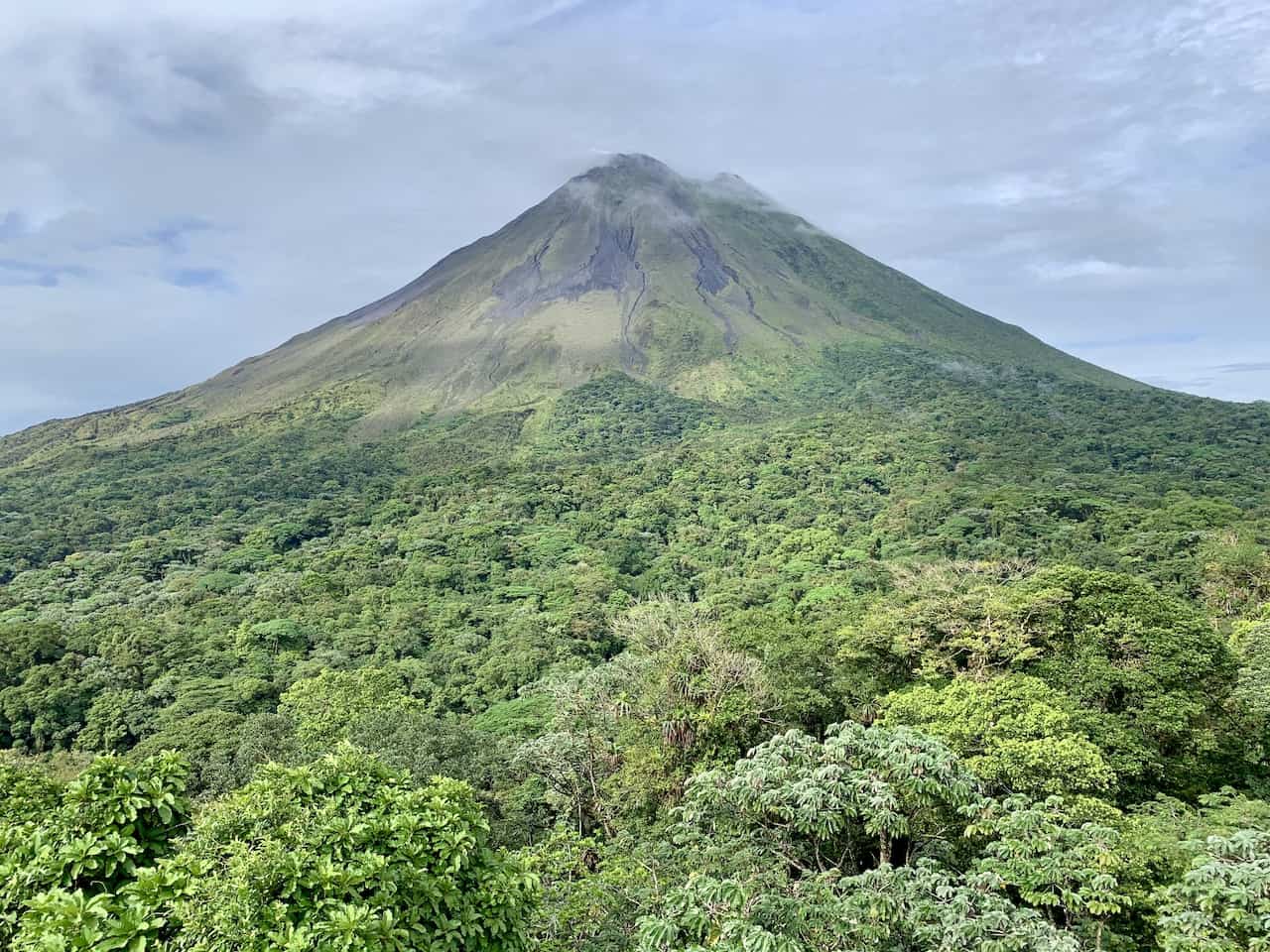
Argentina (January 20 – February 9)
While I did spend a day in Buenos Aires, the main aspect of this portion of the trip was to hike my way through Patagonia . While, I did visit during what is considered one of the best times of year to go from a weather perspective, I still knew the risk of the Patagonian weather.
One day can be nice and sunny, while the next day could be a complete snowstorm (yes even in their summer months!). I mean, I even had a day when it was sunny and snowing at the same time .
Knowing the unpredictability of the weather, I decided to always give myself extra days in each one of the places I visited . This way if the weather did not cooperate for a day or two, I still would be able to enjoy my time there.
And for the most part, that is exactly what happened. Half the time I was in El Chalten, the weather made hiking impossible. A couple days in El Calafate by the Perito Merino Glacier were completely clouded over. But since I planned to have more days than necessary, it all worked out pretty well in the end as I visited these regions:
• Ushuaia • El Calafate • El Chalten • Huemul Circuit
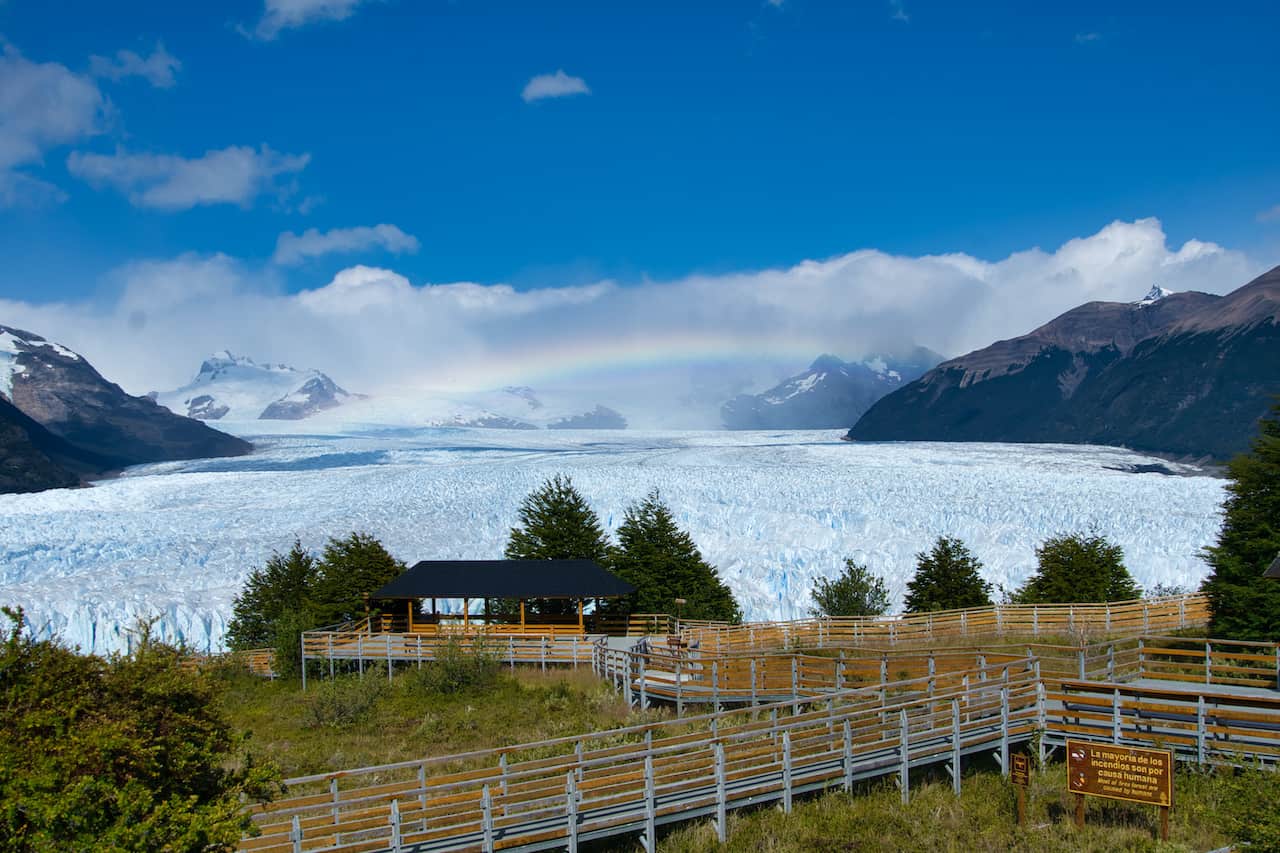
Chile (February 10 – February 20)
From El Chalten, I bussed back to El Calafate, and then took a bus ride over to Puerto Natales in Chile. From there began the O Circuit Trek in Torres Del Paine National Park (an extended version of the famous W Trek ) .
This was actually one portion of Patagonia, where I could not just add on more days for a weather buffer. Since I needed to book the accommodation in the park well in advance, I was locked into my days.
Although the weather was not perfect for some of the days on the trail, it was more than suitable for some trekking. Some top highlights included the Grey Glacier , French Valley , and Mirador Las Torres .
After 8 days of hiking the “O”, I made my way back to Puerto Natales and flew to Santiago to end my time in Chile.
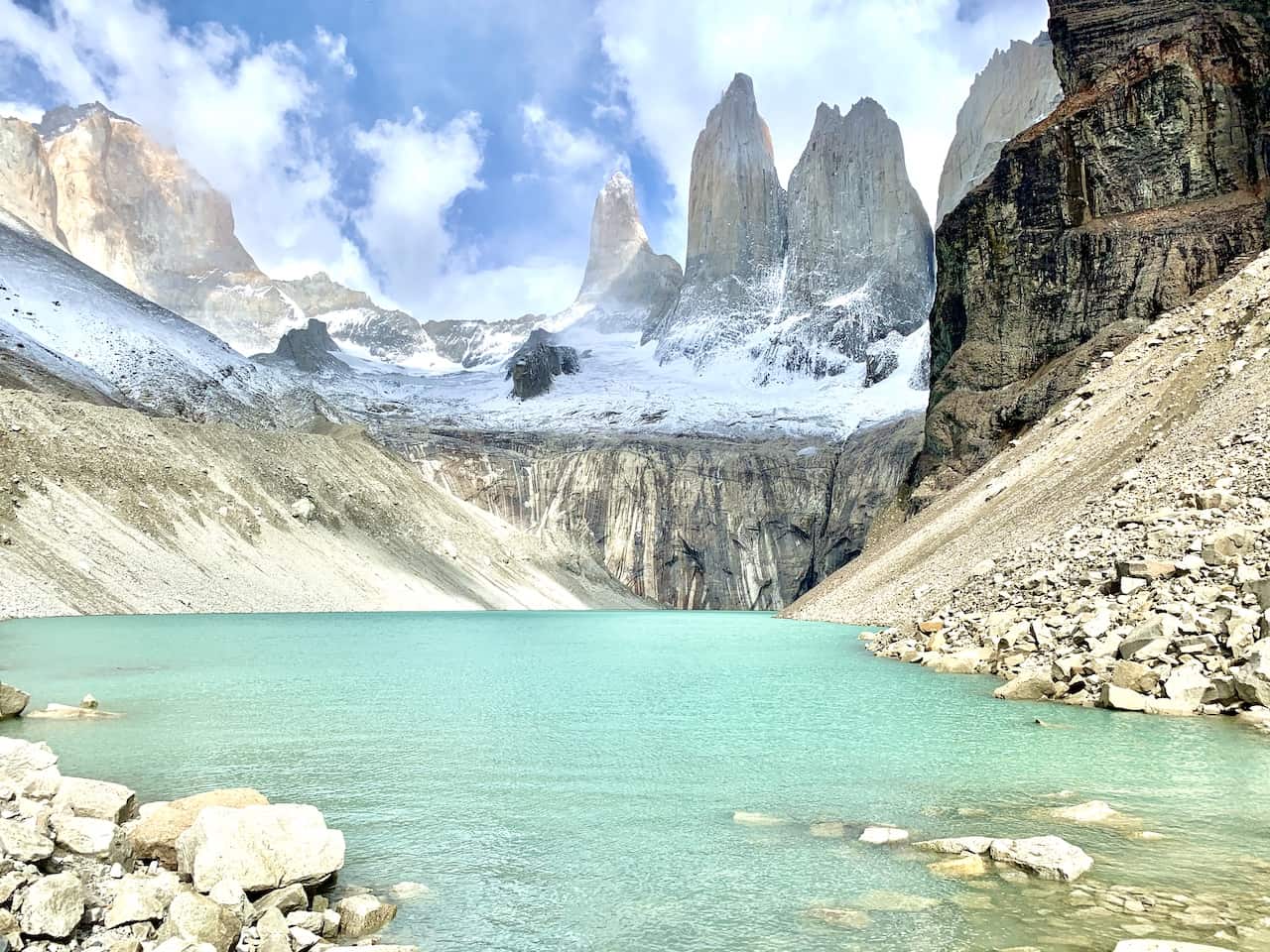
Sri Lanka (February 21 – March 15)
It was then across the world to Sri Lanka , where I got to see the ins and outs of the country for the next three weeks. Yes, I know not the best flight plan, but I planned to spend the next several months in Asia/Africa. Along the way I got to experience a little bit of everything including:
• Colombo • Habarana • Polonnaruwa • Kandy • Dalhousie / Adam’s Peak • Nuwara Eliya • Ella • Yala & Udawalawe Safaris • Mirissa

And here is where things just started to get a bit crazy. We are talking March of 2020 as the world began to turn upside down. The remainder of my trip I was supposed to go to China (quickly got nixed), India, South Africa and Namibia.
I soon realized though, that traveling was no longer an option. After deciding to go to South Africa, I just lasted a few days in Cape Town, before taking one of the last flights out of the country back to the US. It wasn’t the way I wanted to end it, but I still did get to travel around the world for a year.
But now I have written a ton about the countries I visited before, during and after the trip around the world. I hope you find the itineraries and travel guides up on the site helpful!
If you have any questions or comments about any of it, just feel free to comment down below. Also be sure to check out some travel tips & tricks to help you better plan your next trip.
Have fun out there and safe travels!

Related posts:

Sharing is caring!
Monday 13th of November 2023
This is very helpful!, thanks so much for taking the time to put it together. Can you expand more on why you didn't go to Australia after NZ? Also, so it was fall when you went to NZ and winter for Australia, any regrets going when you did? thoughts? I've read travelling west, is the best way to do a RTW trip, so it's a given to start in NZ, but when to go to get less tourists but decent weather.
Sunday 6th of August 2023
This is all very inspiring and informative, as I’m considering doing the same. Question, how much did you spend your your entire trip?
Monday 7th of August 2023
Hi Mai - feel free to check out this overview I put together about the costs of traveling the world. Good luck with trip planning!
Monday 26th of June 2023
Hi, love your travel story. Have u visited china ever since u miss the last round? Do you plan to round china? I am looking for a company to go round china. I am 60 years old woman.
Hi Janet - I traveled a long while ago just to Shanghai and Beijing. I have yet to go back but would love to travel more around the country one day!
Friday 23rd of June 2023
Hi, this trip sounds amazing! myself and my husband would love to do this type of trip! How did you manage to sort all this out with transport etc? And how did you budget doing all the travel? How much would you need? Thanks. Katie
Saturday 24th of June 2023
Hi Katie - I just took everything one step at a time. The entire trip was not planned out from day one. While I knew of the overall route for the most part, I did not want to corner myself into making decisions too early. I would recommend writing out the countries that are most interested to you and then doing some research on what an overall route would look like. You can see what is possible and what may be too difficult or expensive to fit in.
As for budget, check out this around the world cost overview up on the site that will walk through it all.
Hope you have an amazing time!
Saturday 10th of June 2023
What was it like coming back to the US and finding work? I want to travel the world for a year or two but it would take me leaving my very stable/promising career.... Which scares me to death! My worry is that I would come home to the US and not be able to get the same type of job.
I also worry that a gap year (0r two) may look bad on a resume. Thoughts?
@hailey, from someone who used to work in Human Resources, the time you spend travelling is an education. Learning language, culture, customs, weather, geography, etc. As a candidate, you bring a lot to the table with this type of experience. It would be a completely different story, if you were just unemployed and laying on the couch for a year. Travel....you won't regret it at all!!!
Tuesday 20th of June 2023
@hailey, The current unemployment rate in the U.S is 3.7%. Anybody who wants a job can find one. As long as the gaps in your resume were doing something interesting and intellectually stimulating (like travelling) and were not spent doing something stupid (like in prison or in re-hab), you'll be fine.
Monday 12th of June 2023
Hi Hailey - everyone is different and I can't say for certain how hard/easy it will be able to come back and find work. I was able to do so within a few months but there are many factors at play such as industry, the economy, demand/supply, etc. I am an advocate of traveling as you can tell, and would recommend doing so if it is something very important to you. There are ways to fill up the gap in the resume - for me it was this site, for others it may volunteering, remote work, etc. It is certainly a tough decision, but hope you make the right one for yourself!! Good Luck!
Winter is here! Check out the winter wonderlands at these 5 amazing winter destinations in Montana
- Travel Guide
How To Plan A World Trip
Published: December 6, 2023
Modified: December 28, 2023
by Tessy Shah
- Plan Your Trip
- Travel Tips
Introduction
Embarking on a world trip is a dream for many adventure seekers and travel enthusiasts. It’s an opportunity to explore new cultures, witness breathtaking landscapes, and create unforgettable memories. However, planning such a grand adventure can be overwhelming without the right guidance. This comprehensive guide will walk you through the essential steps to plan your dream world trip, ensuring a smooth and enjoyable journey.
Whether you’re a seasoned traveler or venturing into the realm of long-term travel for the first time, proper planning is key to ensuring a successful trip. From researching destinations to managing your finances and preparing for unforeseen circumstances, each step plays a crucial role in shaping your travel experience.
By following this step-by-step guide, you’ll be equipped with the knowledge and resources necessary to plan your world trip effectively. From selecting the perfect destinations to creating a realistic budget, organizing travel logistics, and taking care of your health and safety, we’ll cover everything you need to know to make your dream journey a reality.
Take a deep breath, envision the incredible adventures that await you, and let’s dive into the process of planning your world trip.
Step 1: Research and Destination Selection
The first step in planning your world trip is conducting thorough research and selecting the destinations you want to visit. This is the exciting part where you get to explore different countries, cultures, and landscapes that pique your interest.
Start by making a list of countries or regions that you’ve always wanted to visit. Consider your personal preferences, such as whether you prefer urban or rural areas, beaches or mountains, historical sites or natural wonders. Think about the activities you enjoy, whether it’s hiking, surfing, or immersing yourself in local cuisine and traditions.
Research each destination to gather information about its attractions, climate, safety, local customs, visa requirements, and any travel advisories. Look for travel blogs, guidebooks, and online forums for insights and recommendations from fellow travelers. Take the time to read about the experiences of others who have visited the places you’re interested in; this will help you narrow down your choices.
Consider creating a priority list or a rough itinerary based on your interests and the feasibility of visiting each destination. Keep in mind factors such as peak tourist seasons, weather conditions, and the overall cost of living in each location.
Once you have a list of potential destinations, it’s time to delve deeper into the details. Research transportation options, such as flights, buses, or trains, and consider the proximity of each location to make your travel arrangements more efficient.
While it’s tempting to pack your itinerary with as many destinations as possible, remember to allow yourself enough time to truly experience and enjoy each place. Prioritize quality over quantity to fully immerse yourself in the local culture and make meaningful connections.
Researching and selecting your destinations might take some time and effort, but the process itself can be exciting as you uncover hidden gems and learn about different cultures around the world. Take advantage of the abundance of resources available online to make informed decisions and craft an unforgettable world trip itinerary.
Step 2: Budgeting and Financial Planning
One of the most crucial steps in planning a world trip is creating a realistic budget and establishing a financial plan to support your travels. Travel expenses can add up quickly, so it’s essential to have a clear understanding of your financial situation and how much you’re willing to spend.
Start by assessing your current financial standing. Determine how much money you have available for your trip and how much you can comfortably allocate to travel expenses. Consider factors such as your savings, income from work or other sources, and any ongoing financial commitments you may have.
Research the cost of living and travel expenses in the countries you plan to visit. Take into account accommodation prices, transportation costs, meals, activities, and any additional expenses such as visas or travel insurance.
Create a detailed budget spreadsheet or use a budgeting app to keep track of your expenses. Divide your budget into categories such as transportation, accommodation, food, attractions, and miscellaneous costs. Be sure to include a contingency fund for unforeseen circumstances.
As you establish your budget, remember to be realistic and flexible. Keep in mind that prices can vary depending on the season, location, and your personal preferences. Consider opting for a mix of budget-friendly and splurge experiences to balance your spending.
Research ways to save money on your travels, such as using travel rewards credit cards, booking accommodation through platforms that offer discounts, or utilizing public transportation instead of taxis or private transfers.
Additionally, consider alternative accommodation options like hostels, guesthouses, or homestays, which can be more budget-friendly compared to hotels.
It’s also important to consider how you will manage your finances while on the road. Research banking options that offer low or no international transaction fees and ATM withdrawal fees. Notify your bank of your travel plans to avoid any disruptions in accessing your funds.
Lastly, make sure to account for any long-term financial commitments you may have, such as student loans or rent. Set up automatic bill payments or arrange for someone to take care of your financial responsibilities while you’re away.
By creating a well-planned budget and implementing smart financial strategies, you can ensure that your world trip remains within your means and enjoy your adventure without any financial stress.
Step 3: Applying for Visas and Travel Documents
Before embarking on your world trip, it’s crucial to understand the visa requirements and travel documents necessary for each country you plan to visit. Visa regulations can vary widely depending on your nationality and the destination, so it’s important to research and prepare well in advance.
Start by checking the visa requirements for each country on your itinerary. Visit the official websites of the embassies or consulates of the countries you plan to visit to gather accurate and up-to-date information. Some countries may offer visa-free entry for certain nationalities or provide visa-on-arrival options.
Identify the type of visa you need, whether it’s a tourist visa, business visa, or any other specific category. Determine the validity period and the allowed duration of stay for each visa.
Plan your itinerary accordingly, taking into account the maximum time you’re allowed to spend in each country. If needed, adjust your travel plans or consider applying for an extended visa or visa extensions to ensure compliance with the visa regulations.
Check the required documents for the visa application process. This can include a valid passport, passport-sized photographs, proof of travel itinerary or accommodation bookings, travel insurance, and financial documents showing sufficient funds to support your stay.
Some countries may also require additional documentation, such as a letter of invitation, proof of employment or education, or a return or onward ticket. Ensure that you have all the necessary documents prepared in advance to avoid any last-minute complications.
Submit your visa application well in advance to allow ample time for processing. Some countries may have longer processing times, so it’s important to plan accordingly.
If you’re visiting multiple countries on your world trip, consider the order in which you will visit them to ensure a smooth transition between visa requirements. Some countries may require proof of onward travel or visa for a subsequent destination, so plan your itinerary accordingly.
Additionally, make copies of all your important travel documents, including your passport, visas, and travel insurance. Store these copies in separate locations, along with digital copies in your email or cloud storage, for easy access in case of loss or theft.
By familiarizing yourself with the visa requirements and preparing the necessary documents in advance, you can avoid any last-minute visa issues and ensure a hassle-free start to your world trip.
Step 4: Booking Accommodation
Booking suitable accommodation for your world trip is an important aspect of planning your adventure. It’s essential to find comfortable and safe accommodations that fit your budget and cater to your specific needs and preferences.
Start by considering the type of accommodation that suits your travel style. Options range from budget-friendly hostels and guesthouses to luxurious hotels, vacation rentals, or even camping sites. Think about factors such as privacy, amenities, location, and the type of experience you want to have during your stay.
Research different accommodation booking platforms, such as Booking.com, Airbnb, or Hostelworld, and read reviews from other travelers to ensure reliable and reputable options. These platforms provide a wide range of choices, from shared dormitories for budget travelers to private rooms or entire apartments for more privacy and comfort.
Consider the location of your accommodations in relation to the attractions or activities you plan to partake in. Look for accommodations that are centrally located or easily accessible to public transportation, making it convenient to explore your chosen destinations.
When booking accommodation, take into account your budget and the length of your stay in each place. If you’re planning a longer-term trip, you might consider alternatives to traditional accommodations, such as house-sitting, couchsurfing, or volunteer programs that provide accommodation in exchange for work.
Be sure to check the cancellation policies and any additional fees associated with your bookings. Flexibility is key, especially when unexpected changes occur in your travel plans or you discover new destinations you want to explore.
Communication is vital when booking accommodations. If you have specific requirements or preferences, such as dietary restrictions, accessibility needs, or specific amenities, be sure to communicate these details with the accommodation provider to ensure a comfortable and enjoyable stay.
Consider reaching out to local tourism boards or visitor centers for recommendations on unique or off-the-beaten-path accommodations. They may have insights into charming guesthouses, family-run bed and breakfasts, or eco-friendly lodgings that offer a different experience from mainstream options.
Remember to keep track of your accommodation bookings and ensure that you have confirmation details readily available. Having a centralized system, such as a digital itinerary or travel app, can be helpful in organizing your bookings.
By carefully selecting and booking your accommodations, you can have a comfortable and enjoyable stay during your world trip, creating a home away from home as you explore new destinations.
Step 5: Transportation Planning
Planning your transportation is a crucial step in organizing your world trip. Determining the most efficient and cost-effective ways to get from one destination to another will help maximize your time and budget.
Start by researching the transportation options available in each country or region you plan to visit. Consider whether it’s feasible to travel by air, train, bus, ferry, or a combination of these methods.
For longer distances, compare flight prices and look for deals or discounts that can help you save money. Utilize search engines and travel websites to find the best flight options and consider being flexible with your travel dates to take advantage of lower fares.
If you prefer a slower-paced journey or want to experience the local landscape, consider traveling by train or bus. Many countries have efficient and affordable public transportation systems that connect major cities and towns.
For shorter distances within a city or between nearby attractions, explore local transportation options such as metro systems, trams, taxis, or even walking. Research the local transportation network, including schedules, fares, and any transportation passes or cards that offer discounts.
Consider purchasing transportation passes or cards that provide unlimited access to public transportation within a specific timeframe. These can be a cost-effective option, especially if you plan to use public transportation frequently during your stay.
When planning your transportation, factor in the time it takes to travel between destinations. Take into account any layovers, waiting times, or potential delays that may occur. Be realistic about the time you’ll need to explore each destination and consider adding buffer days in case of unexpected changes in your plans.
Research the local driving regulations and road conditions if you plan to rent a car or use a car-sharing service. Ensure that you have an international driving permit if required and familiarize yourself with the local traffic rules and signs.
If you’re an adventurous traveler, consider alternative forms of transportation such as cycling, motorcycling, or even hitchhiking, keeping in mind the safety considerations and legal requirements of each country.
Lastly, make sure to have a backup plan in case of transportation disruptions or cancellations. Know the alternative routes or modes of transportation available in case your original plans encounter any unexpected obstacles.
By carefully planning your transportation options and being well-prepared, you can save time, money, and avoid unnecessary stress during your world trip. Remember to stay flexible and open to new experiences, embracing the journey as much as the destinations you’ll visit.
Step 6: Creating an Itinerary
Creating a well-thought-out itinerary is essential for maximizing your time and ensuring a smooth and organized world trip. An itinerary provides structure to your travels, allowing you to make the most of each destination while maintaining flexibility.
Start by reviewing your list of selected destinations and the duration of your trip. Consider the time you have available and balance it with the number of places you want to visit. Remember, it’s better to spend more time in fewer locations than to rush through multiple destinations.
Research the attractions, landmarks, and activities available in each destination. Prioritize the ones that align with your interests and preferences. Take into account any must-see sights, local festivals, or unique experiences that you don’t want to miss.
Create a rough outline of your itinerary, allocating a specific number of days or timeframes for each destination. Consider the travel time required between locations and factor in rest days or buffer days to account for any unexpected delays or changes.
Be open to alternative routes or additional stops along the way that may enhance your journey. Sometimes the unplanned detours lead to the most memorable experiences.
Consider whether you prefer a more relaxed pace or if you’re comfortable with a faster-paced itinerary. Find a balance that allows you to fully immerse yourself in each location while also making progress towards your overall travel goals.
While it’s important to have a structured plan, be flexible and open to adjustments. Leave room for spontaneous activities or opportunities that may arise during your trip. Remember that some of the most memorable moments can happen when you embrace the unexpected.
When creating your itinerary, also take into account local customs, traditions, and schedules. Some attractions or businesses may have specific hours of operation, while others may close on certain days of the week. Research the local culture to ensure that your plans align with the local customs and norms.
Communicate your itinerary to family or friends back home, as well as any trusted contacts you may have in the destinations you plan to visit. Having a general idea of your whereabouts can provide an added layer of safety and allow others to reach you if needed.
Review and refine your itinerary periodically as you gather more information or receive recommendations from fellow travelers. Stay updated on any travel advisories or changes in the local conditions that may affect your plans.
Remember that while having an itinerary is important, it’s equally crucial to remain flexible and open to new experiences. Embrace the unexpected, veer off the beaten path, and allow yourself to fully immerse in the beauty of your world trip.
Step 7: Packing Essentials
Packing for your world trip can be both exciting and overwhelming. It’s important to pack efficiently, ensuring that you have all the essentials while keeping your luggage light and manageable. Here are some tips to help you pack smart for your adventure:
Start by creating a packing list. Consider the climate and weather conditions of the destinations you’ll be visiting and pack accordingly. Research the average temperatures, rainfall, and any specific clothing or gear requirements for each location.
Opt for versatile clothing that can be mixed and matched to create different outfits. Pack lightweight, quick-drying fabrics that are easy to wash and dry on the go. Choose clothes that are suitable for layering, allowing you to adapt to changing weather conditions.
Invest in a good quality, lightweight travel backpack or suitcase that meets airline size restrictions. Consider the durability, convenience, and functionality of your luggage. Choose a carry-on size if possible, as it allows for easier mobility and eliminates the risk of lost baggage.
Pack essential toiletries and personal care items in travel-sized containers to save space. Consider any specific medications or first aid supplies you may need and carry them in your carry-on to ensure easy access.
Consider the electronics you’ll need for your trip, such as a smartphone, camera, laptop, or e-reader. Pack the necessary chargers, power adapters, and any additional accessories needed for your devices. Remember to have a backup power bank for emergencies.
Research the voltage requirements and socket types of the countries you’ll be visiting and purchase appropriate travel adapters.
Don’t forget to pack important travel documents such as your passport, visas, driver’s license, and travel insurance information. Make digital copies of these documents and store them securely in your email or cloud storage.
Include a small daypack or a foldable tote bag that can be used for day trips or as an additional carry-on bag, allowing you to have your essentials within reach while exploring.
Bring a travel-sized laundry kit or detergent that allows you to wash your clothes on the go, saving you from having to pack excessive amounts of clothing.
Consider packing a few lightweight, multi-purpose items such as a microfiber towel, a universal sink stopper, a reusable water bottle, and a travel-sized umbrella or rain jacket. These can come in handy in various situations and save you from unnecessary expenses.
Limit the number of pairs of shoes you pack. Choose comfortable walking shoes for daily use and pack a pair of flip-flops or sandals for the beach or shower. Remember to pack a pair of socks and a few pairs of underwear that can be easily washed and dried.
When it comes to packing, remember that less is often more. Pack what you truly need, and be prepared to purchase or borrow items locally if necessary. Traveling light will make your journey more enjoyable and allow for greater flexibility in your adventures.
Step 8: Health and Safety Preparations
Ensuring your health and safety is a top priority when planning a world trip. Taking the necessary precautions and preparing ahead of time can help you stay healthy and safe throughout your travels. Here are some important steps to consider:
Research the health risks and any necessary vaccinations for the countries you plan to visit. Consult with a healthcare professional or travel clinic to determine which vaccinations are recommended or required.
Obtain travel insurance that covers medical expenses, emergency evacuation, and trip cancellation. Read the policy carefully to understand the coverage and exclusions. Carry a copy of your insurance policy details and emergency contact numbers with you at all times.
Make sure you have an adequate supply of any prescription medications you require, and carry them in their original packaging with a copy of the prescription. Research the availability of medications in the countries you’ll be visiting, and if needed, obtain a letter from your healthcare provider explaining your condition and the necessity of your medications.
Research the quality of healthcare facilities and medical services available in your destinations. Identify the location of hospitals, clinics, and pharmacies in each location. Consider carrying a basic first aid kit with items such as bandages, antiseptic wipes, over-the-counter pain relievers, and any specialized medical supplies you may need.
Ensure that you have adequate travel vaccinations and protection against mosquito-borne illnesses such as malaria or dengue fever. Pack insect repellent, long-sleeved clothing, and mosquito nets if necessary.
Stay informed about any potential health risks or outbreaks in the areas you plan to visit. Check the websites of reputable health organizations and government travel advisories for up-to-date information and recommendations.
Take precautions to minimize the risk of foodborne illnesses. Avoid consuming tap water or drinks with ice in countries where water quality is a concern. Be mindful of eating at reputable establishments, choose freshly cooked food, and wash your hands regularly or use hand sanitizers.
Practice good hygiene habits such as proper handwashing, especially before eating or preparing food. Carry hand sanitizers or antibacterial wipes for times when access to soap and water is limited.
Take steps to ensure your personal safety while traveling. Research the safety situation in each destination and stay informed about any travel advisories or warnings. Avoid high-risk areas and practice common sense precautions such as using reputable transportation, securing your belongings, and being aware of your surroundings.
Register your travel plans with your country’s embassy or consulate in each destination. This allows them to contact you and provide assistance in case of an emergency or natural disaster.
Learn a few basic phrases in the local language, including emergency numbers and phrases related to health or safety. This can help you communicate your needs effectively if the need arises.
By taking the necessary health and safety precautions and staying informed, you can enjoy a worry-free world trip while prioritizing your well-being.
Step 9: Communication and Connectivity
Staying connected and maintaining effective communication while traveling is essential for a smooth and enjoyable world trip. Here are some steps to help you navigate communication and stay connected during your travels:
Research the local communication infrastructure and options available in each destination. Understand the local mobile network providers and their coverage. Determine whether it’s more cost-effective to purchase a local SIM card or to activate an international data plan with your current mobile provider.
Unlock your phone before your trip to ensure compatibility with different SIM cards. Check with your mobile provider about the unlocking process and any associated fees or requirements.
Consider purchasing a pocket Wi-Fi device or mobile hotspot, especially if you need multiple devices connected to the internet simultaneously. These devices offer flexibility and can be a reliable source of internet connectivity during your travels.
Explore alternatives to traditional mobile plans, such as using messaging apps or Voice over Internet Protocol (VoIP) services to make calls and send messages over the internet. Apps like WhatsApp, Skype, or Viber can help you stay connected with friends and family without incurring expensive roaming charges.
Research the availability of Wi-Fi hotspots in your destinations. Many accommodations, cafes, restaurants, and public areas offer free or paid Wi-Fi access. Make use of these opportunities to stay connected and minimize data usage.
Consider downloading offline maps or navigation apps to your mobile device. These apps allow you to access maps and directions without an internet connection, making it easier to navigate unfamiliar places.
Invest in a portable power bank to keep your devices charged, especially when you’re on the go and may not have access to power outlets. Ensure that the power bank has sufficient capacity to meet your needs.
If you need to make international calls, research the most cost-effective options. Calling cards or VoIP services can help you save on international calling rates.
Register for international roaming with your mobile provider if needed. Understand the rates and charges associated with using your phone abroad, and set usage limits or alerts to avoid unexpected costs.
For important or emergency contacts, write down the phone numbers and addresses on a physical copy in case you lose your phone or don’t have access to your digital contacts.
Stay mindful of your online security and use secure networks when accessing sensitive information such as online banking or personal accounts. Avoid using public Wi-Fi networks for such purposes, or use a reliable virtual private network (VPN) to encrypt your internet connection.
By planning ahead and considering your communication and connectivity needs, you can stay connected with loved ones and access important information throughout your world trip.
Step 10: Managing Finances on the Road
Managing your finances while on a world trip is crucial to ensure you stay on budget and have peace of mind throughout your travels. Here are some steps to help you effectively manage your finances on the road:
Create a daily or weekly budget to track your expenses. Consider all aspects of your trip, including accommodation, transportation, meals, activities, and miscellaneous costs. Be realistic about your spending habits and adjust your budget as needed.
Keep track of your expenses using a budgeting app, spreadsheet, or a dedicated travel finance tool. Regularly update your records to have an accurate overview of your spending and identify any areas where you may need to cut back.
Monitor exchange rates and familiarize yourself with the local currency of the countries you’ll be visiting. Research reputable currency exchange options to get the best rates and minimize fees.
Carry a mix of payment options, including cash, debit or credit cards, and a travel card. Having multiple options provides flexibility and ensures you have access to funds in case of any issues with one method.
Notify your bank and credit card companies about your travel plans to avoid any potential card blocks due to suspicious activities. Make a note of any emergency contact numbers for your financial institutions.
Use ATMs located in secure and reputable locations to withdraw cash. Be mindful of any additional fees associated with ATM withdrawals and set daily withdrawal limits to avoid carrying excessive amounts of cash.
Avoid exchanging currency at airports or tourist areas, as they often offer less favorable rates. Research local banks or currency exchange offices in the city for better rates.
Consider using a prepaid travel card that allows you to load funds in multiple currencies and offers competitive exchange rates. These cards can help you control your spending and avoid currency conversion fees.
Keep important financial documents, such as copies of your passport, bank cards, and travel insurance information, in a secure location or encrypted digital storage. Carry a backup card in case of loss or theft, separate from your primary cards.
Regularly check your bank and credit card statements to monitor for any unauthorized transactions. Report any suspicious activity immediately to your financial institutions.
Be cautious when using public Wi-Fi networks for financial transactions or accessing sensitive information. Use secure networks or a virtual private network (VPN) to ensure your data is protected.
Save receipts and make copies of important financial transactions. These records will be helpful for budget tracking, expense reimbursement, or any potential insurance claims.
At the end of your trip, review your overall expenses and reflect on your spending habits. This will provide insights for future trips and help you make better financial decisions.
By following these financial management tips, you can stay within your budget and have better control of your finances, allowing you to fully enjoy your world trip without unnecessary stress.
Step 11: Travel Insurance
Travel insurance is an essential aspect of planning a world trip. It provides financial protection and peace of mind in case of unexpected events or emergencies during your travels. Here’s why travel insurance should be a priority:
Research and compare different travel insurance providers to find a policy that suits your needs. Look for coverage options that include medical expenses, emergency medical evacuation, trip cancellation or interruption, lost or stolen baggage, and personal liability.
Read the policy details carefully to understand the coverage limits, exclusions, and any required documentation or procedures in case of a claim. Consider additional coverage for specific activities such as adventure sports or high-risk activities if you plan to participate in them during your trip.
Understand the pre-existing medical condition policy of your travel insurance provider. Declare any pre-existing conditions and ensure that they are covered under the insurance policy. Failure to disclose pre-existing conditions may invalidate your coverage.
Evaluate the medical coverage limits to ensure they are sufficient for the countries you plan to visit. Medical expenses can be exorbitant in some destinations, and having adequate coverage is crucial for your financial protection.
Consider the duration of your trip and whether the travel insurance policy allows for extensions or renewal. If you plan to engage in long-term or indefinite travel, ensure that your policy covers the entire duration of your trip.
Review the policy’s terms for trip cancellation or interruption coverage. Understand the covered reasons and the reimbursement process if you need to cancel or cut short your trip due to unforeseen events.
Carry a copy of your travel insurance policy details, including the contact information for the insurer and the emergency assistance hotline. Keep a digital copy as well, in case of loss or theft.
Follow the necessary procedures and provide all required documentation if you need to make a claim. Take photos or make a list of any lost or stolen belongings, and report incidents to local authorities or the relevant authorities as soon as possible.
Keep all receipts, medical reports, police reports, and any other documentation related to your claim. Having organized records will make the claims process smoother and help support your case.
Before purchasing any additional travel coverage, review the benefits and coverage provided by your existing health insurance, credit card, or homeowner’s insurance policies. Some of these policies may offer limited travel coverage.
Remember that travel insurance is not just for medical emergencies. It also provides coverage for trip cancellations, lost baggage, travel delays, and other unforeseen events that may disrupt your plans.
While travel insurance adds to your overall trip expenses, it offers valuable financial protection and can save you from significant out-of-pocket costs in case of emergencies or unexpected circumstances.
Prioritize travel insurance as an essential part of your world trip planning to ensure a worry-free and financially secure adventure.
Step 12: Cultural Etiquette and Social Norms
When embarking on a world trip, understanding and respecting the cultural etiquette and social norms of the countries you visit is crucial. Here are some important considerations to help you navigate cultural differences with sensitivity:
Conduct research about the customs, traditions, and social norms of each destination before you arrive. Understand the local etiquette regarding greetings, dress codes, body language, and appropriate behavior in public spaces.
Respect local traditions and customs, even if they may differ from your own cultural norms. Be open-minded and embrace the opportunity to learn about and experience new ways of living.
Dress modestly and appropriately, especially when visiting religious sites or conservative areas. In some countries, it is customary to cover up your shoulders, legs, or hair. Understand and follow the local dress code to show respect for the culture.
Practice appropriate behavior when visiting religious or sacred sites. Follow any guidelines or rules set by the religious institution, such as removing your shoes, covering your head, or refraining from taking photos.
Be mindful of your gestures, as some may have different meanings in different cultures. Research and familiarize yourself with common gestures to avoid unintentionally offending or misunderstanding others.
Observe and follow local customs regarding greetings. For example, in some cultures, a handshake is appropriate, while others may prefer a bow, a kiss on the cheek, or no contact at all. Pay attention to the cues of the locals and follow their lead.
Learn a few basic phrases in the local language, such as greetings, thank you, and please. Making an effort to communicate in the local language is appreciated and shows respect to the local community.
Respect personal space and boundaries. Different cultures have different standards of personal space, and it’s important to be mindful of physical proximity to others to avoid making anyone uncomfortable.
Refrain from making negative comments or criticisms about the local culture, customs, or traditions. Instead, approach cultural differences with curiosity and a willingness to learn and understand.
Be cautious when discussing sensitive topics such as politics, religion, or cultural taboos. Avoid making assumptions or generalizations about a culture or religion. Listen attentively and ask questions respectfully if you want to learn more.
Respect local wildlife, natural resources, and protected areas. Follow guidelines for responsible tourism and avoid behaviors that harm the environment or wildlife. Leave nature as you found it and strive to minimize your ecological footprint.
Be aware of local laws and regulations and abide by them. Familiarize yourself with any specific rules or cultural practices that may apply to activities such as photography, public displays of affection, or alcohol consumption.
By educating yourself about cultural etiquette and social norms, you show respect for the local community and enhance your cultural immersion during your world trip. Embrace the diversity and richness of each destination, and approach interactions with an open and empathetic mindset.
Step 13: Solo Travel Tips
Solo travel can be an incredibly rewarding and transformative experience. Whether you’re embarking on a world trip alone or exploring individual destinations, here are some valuable tips to enhance your solo travel adventure:
Prioritize safety by researching the safety situation of your chosen destinations. Stay informed about any travel advisories or warnings and take necessary precautions. Trust your instincts and avoid risky situations or unsafe areas.
Stay connected with family or friends back home. Share your travel itinerary and keep them updated on your whereabouts. Check in regularly to provide peace of mind for your loved ones.
Make copies of your important documents such as passport, visas, and travel insurance. Keep digital copies in your email or cloud storage, and carry physical copies in a separate location from the originals.
Stay in accommodation that offers a safe and welcoming environment for solo travelers. Consider hostels or guesthouses with shared common areas, where you can meet fellow travelers and potentially find companions for activities.
Be mindful of your belongings and keep them secure. Use a lock for your luggage, consider carrying a money belt or a hidden pouch to store your valuables, and be aware of your surroundings to prevent theft or loss.
Learn basic self-defense techniques or take a self-defense class before your trip. Knowing how to protect yourself in potentially dangerous situations can boost your confidence and give you a sense of security.
Build connections with locals and fellow travelers. Engage in conversations, join group activities or tours, and be open to meeting new people. However, trust your instincts and be cautious when interacting with strangers.
Practice self-care and listen to your body. Take time for yourself when needed, whether it’s to recharge, reflect, or simply enjoy your own company. Pace yourself and find a balance between exploration and relaxation.
Embrace the freedom of solo travel by being flexible with your plans. Don’t feel pressured to stick to a rigid itinerary; allow yourself the spontaneity to discover new places or change your plans as you see fit.
Be open to stepping out of your comfort zone and trying new experiences. Solo travel provides an excellent opportunity for personal growth and self-discovery. Challenge yourself to try activities you may have never considered before.
Practice good communication and assertiveness. Learn key phrases in the local language, such as asking for help or directions. Set clear boundaries and trust your intuition when engaging with others.
Stay informed about local customs and cultural norms. Respect and adapt to the traditions and practices of the places you visit. Being culturally sensitive enhances your travel experience and helps you connect with locals.
Stay positive and maintain a sense of humor, even when faced with challenges. Solo travel can come with its ups and downs, but embracing the journey with a positive mindset will contribute to a more enjoyable experience.
Solo travel allows you to embrace freedom, self-discovery, and personal growth. By following these tips, you’ll be better prepared to navigate the world on your own and create unforgettable memories along the way.
Congratulations on reaching the end of this comprehensive guide to planning your dream world trip! By following the steps outlined in this guide, you’re well-equipped to embark on an adventure of a lifetime. Remember, planning a world trip requires careful research, organization, and flexibility.
From conducting thorough destination research to budgeting, applying for visas, booking accommodations, and managing your finances, each step is essential in ensuring a smooth and enjoyable journey. Additionally, understanding cultural etiquette, prioritizing safety, and embracing the freedom of solo travel will enhance your experience even further.
Throughout your world trip, stay open-minded, embrace new experiences, and immerse yourself in the diverse cultures and breathtaking landscapes you encounter. Cherish the connections you make with locals and fellow travelers, and let each destination leave its mark on you.
Remember, travel is not just about the destinations you tick off your list, but also about personal growth, self-discovery, and creating lifelong memories. Embrace the challenges, celebrate the triumphs, and embrace the transformative power of travel.
So, embark on your world trip with confidence, curiosity, and a sense of adventure. Open yourself up to the wonders of the world, and let the journey unfold. Bon voyage!

- Privacy Overview
- Strictly Necessary Cookies
This website uses cookies so that we can provide you with the best user experience possible. Cookie information is stored in your browser and performs functions such as recognising you when you return to our website and helping our team to understand which sections of the website you find most interesting and useful.
Strictly Necessary Cookie should be enabled at all times so that we can save your preferences for cookie settings.
If you disable this cookie, we will not be able to save your preferences. This means that every time you visit this website you will need to enable or disable cookies again.
World Trip Planner
Plan your next round-the-world trip.
Use PlanYourTrip to prepare for you next Adventure. With this page you can try out this application to find out about it's advantages. After registration your Trip can be saved. Have fun planning your next World Trip with the PlanYourTrip Planner.
You still need some inspiration for your personal travel planning? Just take a look at our sample trips!
- Skip to primary navigation
- Skip to main content
- Skip to primary sidebar

Destinations
Experiences.
- Photography
Plan Your Trip
Plan your rtw trip.
Finding the right round the world trip planner can be difficult. This is first and foremost because many such tools on the internet are only for planning (and, in some cases, booking) RTW flights. The truly difficult part of planning a trip around the world is deciding where to go, how long to stay and how to arrange your trip, so the content deficit (let alone how rare it is to find a quality world trip planner) is frustrating for many travelers.
The good news? Whether you want to travel all around the world, or simply want to visit multiple continents during a single trip, this guide covers all the bases you’ll need to hit as you plan your trip.
Of course, I’ll also touch on the particulars of buying a RTW ticket, including a somewhat contentious recommendation on my part. I’m about to share a great deal of information with you, but I promise: Planning a RTW trip is much, much easier than it looks.
Booking Round the World Flights
Many a round the world trip planner (which to say, any airline alliance website create for the purpose of selling flights) will tell you that booking a single RTW ticket is essential for a round the world trip. However, I don’t agree with this. In addition to the fact that having a single travel the world for a year itinerary (even a flexible one) can lock you in on a trip that will be anything but predictable, it’s often more cost effective to book individual segments, particularly if you have some miles or points to play with.

Let’s say, for example, that you live in the United States and want to fly around the world westward. After taking advantage of a rock-bottom one-way flight from the US to Japan or China , you can take advantage of low-cost flights as you explore Southeast Asia and Australia , then gradually make your way to Europe (and from there, Africa ), flying to South America before returning home, often for only a few hundred dollars per segment. A round-the-world ticket, on the other hand, which often only includes long-distance flights, can easily cost between $2,000-3,000. And that’s without the fees you’ll certainly have to pay to change it as your plans evolve.
How Long Does a Round the World Trip Take?
Whether or not you work with an around the world trip planner, you should keep in mind that as you plan a round the world trip, the issue of timing can be surprisingly far in the back of your mind, particularly if you’ll be traveling to regions of the world you’ve never visited. While two weeks traveling through Japan or Western Europe can allow you to cover a lot of ground, it’s woefully insufficient in places like India , Africa or even much of South America. In general, it’s safe to assume you’re probably underestimating how long you’ll need to devote to your trip.
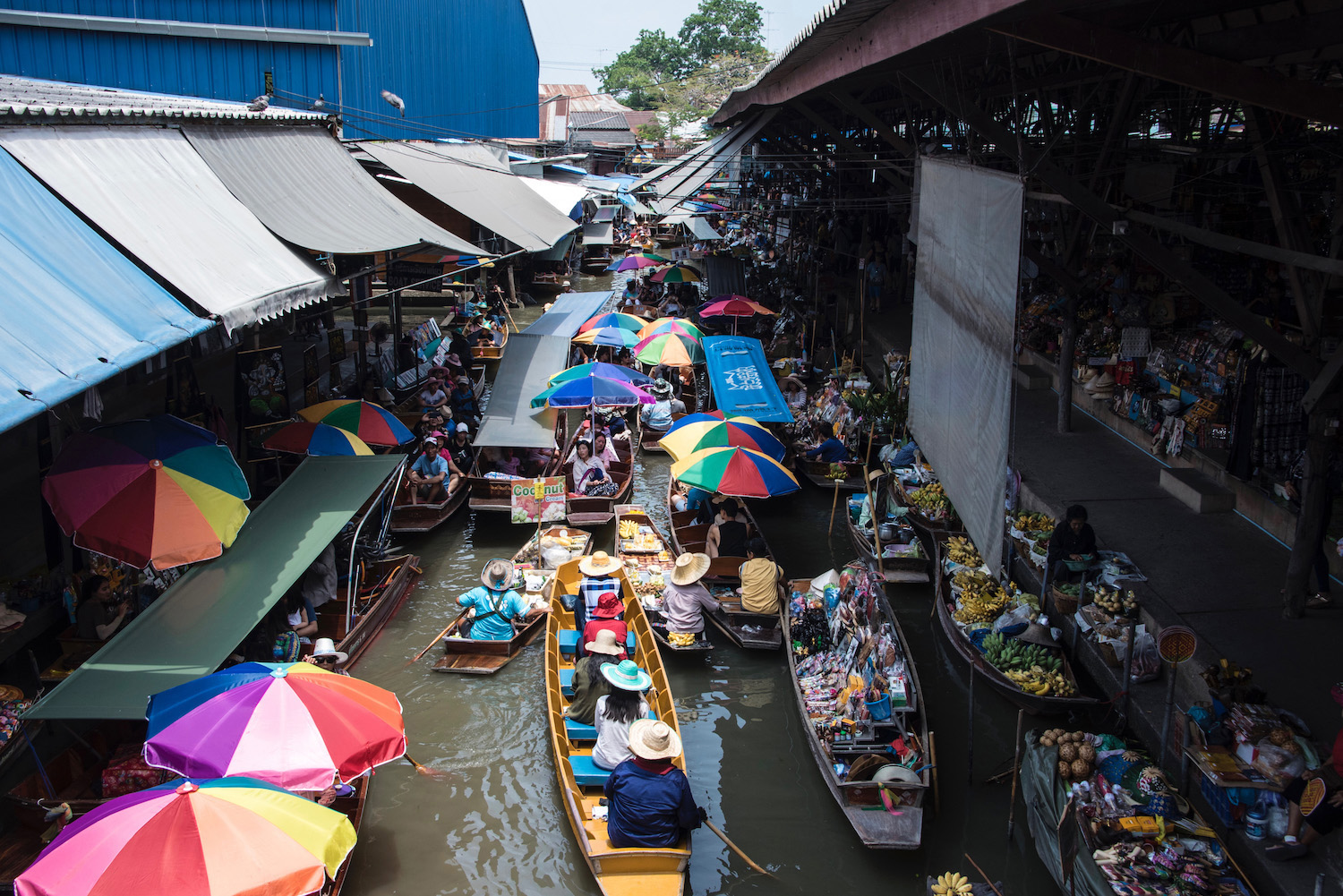
Broadly speaking, I’d say the best round the world holidays last a minimum of six months, though I have personally taken epic trips in a shorter amount of time than that. On the other hand, I’d caution against traveling for longer than a year at a time, as being away from your “real life” for such a period can have other impacts on your well-being, ones you might not be able to anticipate right now.
How Much Does a Round the World Trip Cost?
Another deficiency of many a round the world trip planner (which is once again to say a flight booking tool) is that it provides only a piece of the cost puzzle—your round the world trip isn’t only going to cost a few thousand dollars. Generally speaking, the average cost of traveling anywhere in the world is between 50-150 USD per person, per day, which means that a conservative estimate for the cost of the ultimate around the world itinerary for a six-month trip (without your “big” flights) is between $9,000-27,000. Not cheap!
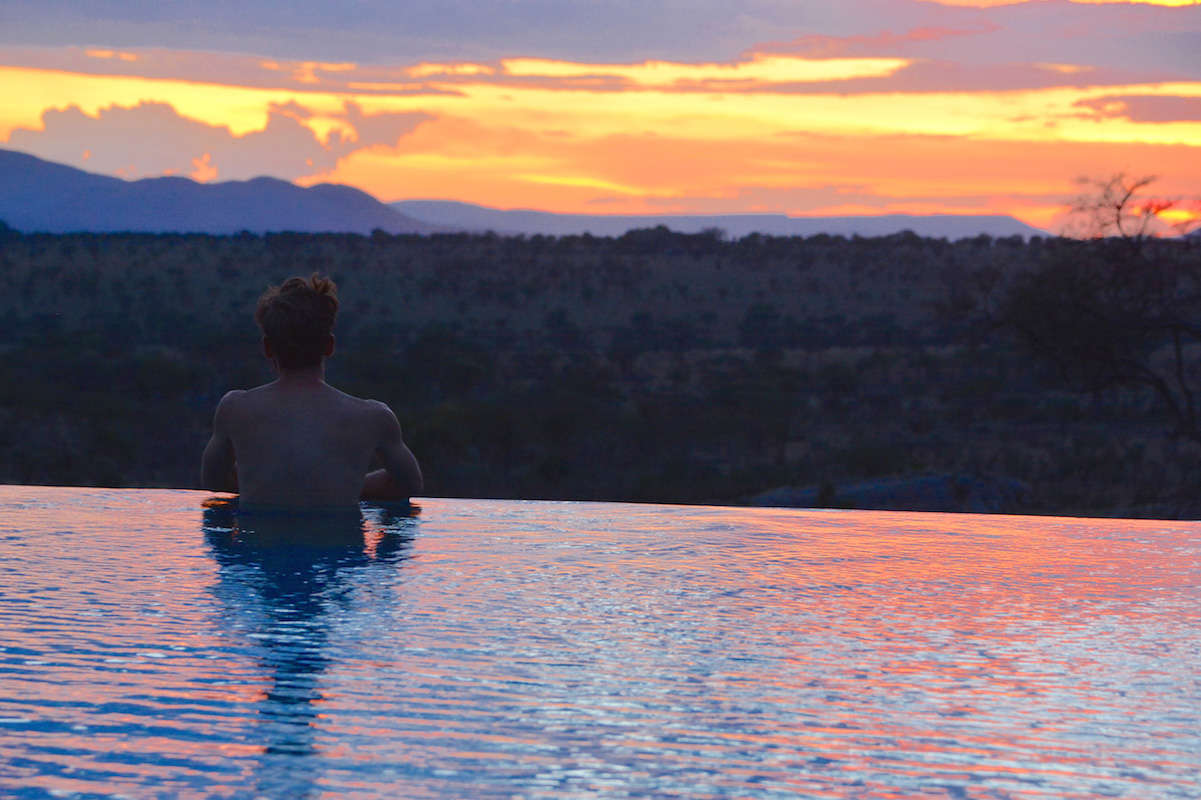
Of course, there are ways to decrease the cost of a travel around the world itinerary, whether you manage to find the cheapest round the world ticket, take advantage of opportunities for free or discounted stays (whether you couch surf or do some sort of volunteer program) or simply keep your dining out and shopping to a minimum. In general, however, I’d recommend over-estimating your budget than under-estimating it, if only so you don’t end up as a “begpacker.”
When to Take a Round the World Trip
When you travel around the world will depend upon where you want to go. While most of the sample round the world routes I’ll recommend in the next section are fairly evergreen, some destinations are better during certain months than others, and planning according to this can influence the rest of your travel trajectory.
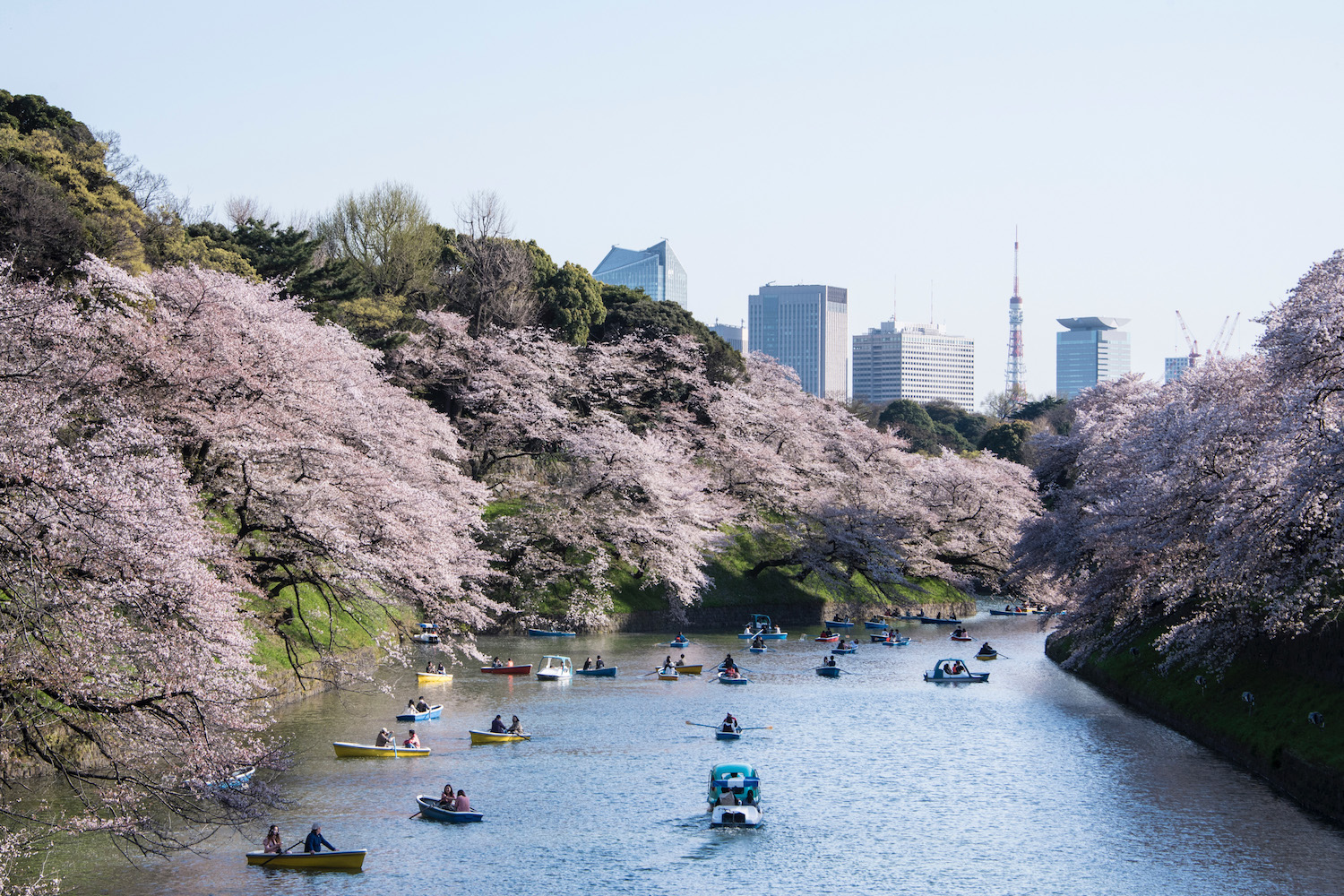
For example, let’s assume you want to see the cherry blossoms in Japan , probably the world’s most famous seasonal spectacle. Whether you choose from my round the world trip ideas below or commission a custom 6 month travel itinerary, you’ll want to arrange the rest of your RTW trip to optimize the weather in all your destinations. You might head to Nepal after Japan, for instance, to trek when the country’s famous rhododendrons are blooming, or visit Australia and New Zealand before Japan to catch the tail end of warm weather Down Under.
Round the World Trip Ideas
The best of six continents.
Most round the world trip planners will want to see the “whole world” on their trips—all six inhabited continents, and potentially even Antarctica. Regardless of where your RTW travel originates, the general path you will follow is North America-Asia (Australia/New Zealand)-(Middle East/India) Europe (Africa)-South America-North America, or maybe in reverse depending upon where you start and what time of year you’re traveling.

In terms of a general flight path, this might look something like the following: Los Angeles-Vancouver- Tokyo – Bangkok – Sydney – Dubai – Paris -Cairo-Cape Town-London-Buenos Aires- Bogota -Houston. Needless to say there are countless variations, from a 6 month round the world trip to ones much longer!
Wonders of the World
Rather than taking a comprehensive approach (which can lead to a year or even longer on the road—again, not an option for the majority of travelers), you can start your world travel planner based on a finite list of world wonders, be it classic ones you find on an Asia trip planner like the Great Wall or ones you designate yourself, such as Barcelona ‘s Sagrada Familia church or Ethiopia’s “Door to Hell.”
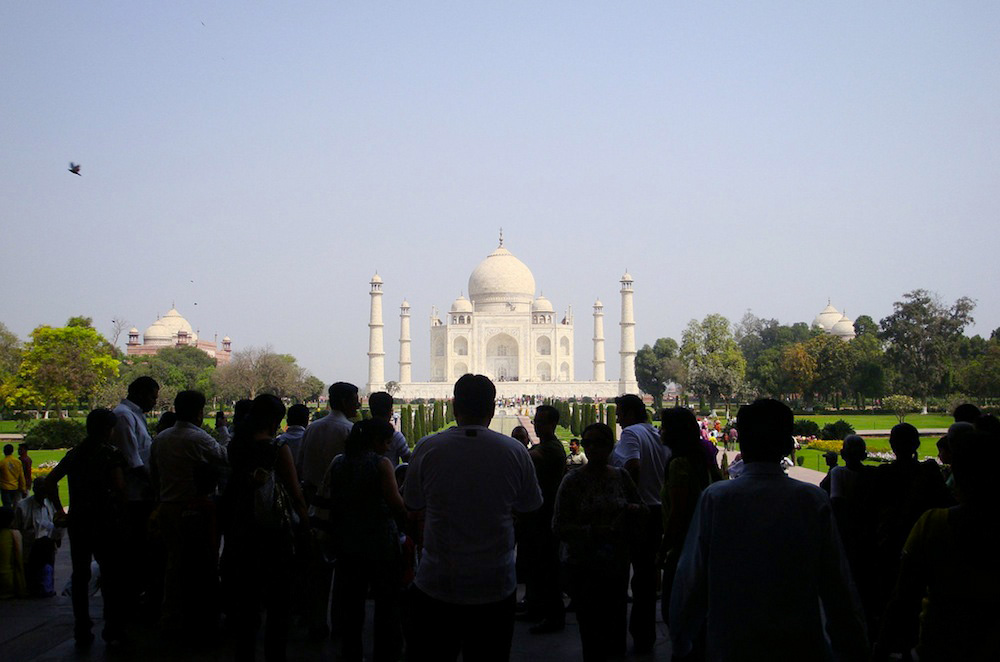
Assuming you take a more classic route for your around the world itinerary, you might go about planning a round the world trip between wonders as follows. From Chicago to Beijing (for the Great Wall), then to Delhi (for the Taj Mahal), to Cairo (for the Pyramids ), to Athens (for the Acropolis), to London (for Stonehenge), to Rio de Janeiro (for Christ the Redeemer) to New York (for the Statue of Liberty). Again, this is highly customizable!
The Backpacker’s Trail
I’ve taken great pains within this round the world trip planner to be honest and sober about the cost of traveling around the world, but this is still a sort of trip that people on the backpacking spectrum can take. Specifically if you decide to string together affordable destinations like Southeast Asia, India, Eastern Europe, Andean South America and Central America.

For instance, if you’re seeking a cheap around the world itinerary, you might fly from Denver to Kuala Lumpur (via China, as Chinese airlines are the cheapest), then fly to Mumbai or Delhi for a month or two there. From there, head to Ukraine or Poland to begin a month or so backpacking Eastern Europe (I particularly like the Balkans ), before taking a flight (probably a multi-leg one) to Lima (where Peru and Bolivia await) or Cancun, from which can you head south to affordable Honduras, El Salvador and Nicaragua.
Five-Star Frolic
On the other end up to the spectrum for a world trip itinerary, travelers without a set budget can enjoy a round the world business class (or even first class) romp that pulls out all the stops. Rather than focusing on a set range of destinations, you can plan your trip based on luxurious hotels and experiences, be it a Tanzania safari from the opulent Four Seasons Serengeti , sampling award-winning in-flight products and services from airlines like Qatar Airways and Singapore Airlines or dining in foodie capitals like Tokyo and Paris.

If you’re planning a luxury round the world trip, it makes sense to enlist the help of a professional (me or someone else), since the price of such assistance (usually between $100-200 per week of travel) is minimal compared to the overall cost of such a RTW trip.
Other FAQ About RTW Travel
How many stops do you get on a round the world ticket.
Whether you’re planning a 6 month round the world trip or plan to stay on the road for years, I am a proponent of piecemeal booking of air travel, rather than committing yourself to a RTW ticket. Therefore, I consider the number of “stops” permitted on such a ticket to be superfluous.
How do I plan a trip around the world?
Unless you are a very experienced global traveler, I recommend against trying to plan a trip on your trip. Rather, work with a professional (such as Yours Truly) to arrange a travel the world for a year itinerary. Or for longer than a year, or shorter—you get the idea.
Are round the world tickets worth it?
No! As I’ve expressed many times during this round the world itinerary, I am not a fan of RTW plane tickets. They rarely cost less; booking and changing them requires a pedantic phone call—or rather phone calls, since you’ll have to call in every time you want to make a modification.
Round the World Trip Planning
The best round the world trips are the ones where you get out on the road and go where the wind takes you, but that’s not realistic for most people. Whether because of finite funds or a “real life” you need to get back to, round the world trips require more planning than you’d probably like, even if you’re generally an adventurous and spontaneous traveler.
“So,” you might be asking, “can you plan my round the world trip for me?” The answer is yes, though there are a couple caveats. Because of the length and breadth of most RTW trips, many travelers want a more skeletal version of my typical “Travel Coaching” itinerary, which is typical extremely detailed and includes day-by-day recommendations. As a result, my pricing for planning RTW itineraries differs from what I’ve published on my Travel Coaching page , so I’d advise emailing me directly with any inquiries.
The Bottom Line
No matter how extensive a round the world trip planner you’ve been seeking, I’m confident that mine has met your needs. For most travelers, it’s simply a matter of learning your RTW flight booking options, assessing the cost of your RTW trip and deciding upon destinations and routing. However, others might want to hire a world trip planner (or a least a skeleton of it, which puts in place a broad trajectory) on their behalf.

Subscribe to email updates!
Words, images and design ©2009-2024 Robert Schrader, All rights reserved. Read Privacy Policy or view sitemap .

A travel planner for everyone
Organize flights & hotels and map your trips in a free travel app designed for vacation planning & road trips, powered by ai and google maps..

Your itinerary and your map in one view
No more switching between different apps, tabs, and tools to keep track of your travel plans.
What travelers are raving about
Features to replace all your other tools, add places from guides with 1 click, collaborate with friends in real time, import flight and hotel reservations, expense tracking and splitting, checklists for anything, get personalized suggestions, plan like a pro.
Unlock premium features like offline access, unlimited attachments, flight deals, export to Google maps, and much more
Offline access
Unlimited attachments, optimize your route.
4.9 on App Store, 4.7 on Google Play
Discover your next favorite destination
Get inspired from guides around the world — with expert tips and recommendations from the Wanderlog community. See all Wanderlog travel guides.
Have tips of your own? Write a guide to share with other travelers like you!
Ready to plan your trip in half the time?
For every kind of trip and every destination, the best road trip planner, the best vacation planner, the best group itinerary planner.
Travel By Carla Vianna
Travel and Adventure Inspiration
How to Plan a Trip Around the World
April 16, 2020 · In: RTW Travel
Wondering how to plan an around the world trip ? Learn from someone who’s already done it! Here is everything you need to know before tackling around-the-world travel. In this post, I break down the round-the-world trip planning process into 7 actionable steps.

Soon after graduating college, I realized there were little pleasures to be found in the traditional 9-to-5 lifestyle. I felt swallowed whole into the bottomless pit of Corporate America, despite not having a very “corporate” job. I found that working in a newsroom doing what I loved — reporting local news and writing articles I was proud of —came with a few strings attached. Namely, little to no vacation time.
You get three sick days … but don’t you dare use them up.
Ten paid vacation days, but don’t take them all at once.
Six company holidays, if you’re lucky.
—Corporate America
I loved the industry I was in, but having no more than 10 days of vacation, at least for the next five years, didn’t sit well with me. How would I manage to travel to the countries on my bucket list; visit my parents in their respective home states; and also see my family in Brazil with only a few days off?
It was impossible.
I realized that working for a company in the U.S. meant little to no travel time overall. If I wanted to see the world in longer than five- to 10-day increments, I had to make something drastic happen. That’s when I started plotting my escape, which eventually led to my around-the-world trip .
In 2017, my boyfriend and I quit our jobs to travel around the world for 10 months, visiting countless cities across 22 countries. I know that planning an around-the-world trip can be incredibly exciting, but also super overwhelming. That’s why I’m sharing the exact process I used to plan my round-the-world trip.
Plan Your Dream Round-the-World Trip in 7 Steps

It’s not easy to plan a trip around the world, but I promise you it’s worth it. When I first thought of quitting my job to travel, I had no idea where to start.
After some online research, I found a small but thriving community of full-time travelers who were living a life that appealed to me far more than that tied me behind a desk.
Many of these travelers had started their journeys with an around-the-world trip. There was even a term for it, “round-the-world travel” or “RTW” for short.
I didn’t need any more convincing. I told myself that if they could do it, I could too. So I started planning my dream around-the-world trip.
Around The World Trip Planning Process, At a Glance :
- Decide where to go
- Create a backpacking route
- Determine how long the trip will last
- Identify a trip budget
- Create a savings plan
- Let go of current commitments
- Buy that one-way ticket!
Step 1: Choose Your Destinations
This was probably the most fun part of planning a trip around the world, as the opportunities are endless!
The very first step was to write down every single city or country I’ve ever dreamt of visiting. Aside from obvious dream destinations like Paris and Machu Picchu, I read a ton of travel blogs to come up with incredible ideas like the Uyuni Salt Flat in Bolivia and Koh Tao in Thailand .
Since I was traveling with my boyfriend, he did the same.
We later compared our lists and circled all the destinations we had in common. Then we went over the differences on each and debated whether or not the other person would like to go there, too. After all was said and done, we had one giant list of cities. From this list, we’d create our around-the-world trip itinerary .

Step 2: Create Your Around The World Trip Route
Aside from saving enough money to make this trip happen, creating a feasible round-the-world trip route was the second most difficult task.
There are a few factors to consider when creating the smartest, most cost effective around-the-world travel route:
- The number of transcontinental flights you’ll need to purchase
- Following one global direction
- The weather in each destination
Transcontinental Flights
The first is to determine how many transcontinental flights will be needed during your around-the-world trip. In other words, how many continents do you plan on visiting? Flying from continent to continent will eat up a big chunk of your budget. The more continents you visit, the more expensive your trip will be.
WHAT I DID: My boyfriend and I settled on three regions of the world for our trip: Europe, South America and Southeast Asia. Then we looked at that list of dream destinations and narrowed it down to places that were located in these three regions.
The Global Direction
The second factor is to plan an around-the-world travel route that follows one global direction: East or West. For example, since I’m based in the U.S., I decided to start in Europe. From there I’d continue onto Southeast Asia and then to South America and back — literally circumnavigating the globe.
One of the most common rules for around-the-world travel is to avoid backtracking . Backtracking leads to spending more money on transportation. Use this rule to choose your entry and departure point in each city, country and continent. Your route should always be moving toward your exit point.
WHAT I DID: Although I had originally planned to travel east around the world, my route took several unexpected turns. Guil and I started our trip later than we had hoped due to a delay in his citizenship process. We started in Europe as we had originally intended, but a promise to spend Christmas with our families in Brazil took us to South America after. From there we returned to the U.S. for an opportunity to work a two-week gig and make more money to fuel another three months in Southeast Asia. Crazy route, I know!
The third factor you’ll want to consider is weather. Lightweight summer clothes are the easiest to pack for an around-the-world trip , which is why so many people choose to chase summer around the globe. Stuffing a big winter jacket in your backpack is not ideal. Check the weather of each region you’re visiting to see how that may affect the direction of your route.
WHAT I DID: I visited Europe in the fall, South America in the summer, and Southeast Asia during the “hot/wet season.”

Step 3: Determine The Duration of Your Round-The-World Trip
How long do you want to travel for? The duration of your around-the-world trip will depend on how many places you want to visit, the pace at which you’re traveling through them and your travel budget.
Once you’ve created a general route, the next thing you need to consider is how much time you want to spend in each desination. The pace at which you move from one place to another depends on what kind of travel experience you’re looking for.
Slow Travel vs. Fast Travel
Slow travel means spending weeks, if not months, in a single city or country.
Slow travel allows travelers to truly get to know a destination and get a sense of what it would be like to live there. This kind of around-the-world travel allows you to interact with locals on a regular basis, find a local cafe to call your own and settle into a slower routine.
Some slow travelers pick a city as a base and explore more of the country from there, while others spend weeks in the same city. This is definitely a more cost-effective way of traveling around the world, as you’re not moving around as much. But you’re also not seeing as much as you could at a quicker pace.
Fast travel is the complete opposite.
These are travelers looking to see as much as they can in a set amount of time — which was me at the time. Fast travel means spending no more than a few days in each city in order to maximize your experiences around the world. It means visiting several countries in one month by hitting the top sites in each. It can mean sensory overload — like visiting Machu Picchu and the Salar de Uyuni within the same month, as I did in 2018.
You can also incorporate a mixture of both: I traveled to Paris, Amsterdam, Berlin, Prague and Budapest in one month and then spent a few weeks exploring just Italy.
It’ll Also Depend on Your Budget…
The duration of your trip will also depend on how long you can make your money last. While I initially planned to travel abroad for six months, I was able to stretch my budget to make it 10.
I knew that I eventually wanted to return to the U.S. and continue working in journalism — so traveling around the world indefinitely wasn’t the plan. As my trip grew longer, though, I was able to add more destinations to my itinerary or travel a bit slower in places like Italy and Peru.
| TRIP PLANNING TIP: Make a spreadsheet of all the cities you want to visit in the order of your desired around-the-world trip route. Write down the number of days you want to spend in each city, ensuring to calculate transportation time between each. Then start putting in some actual dates to give yourself a general idea of the itinerary you’ll be following. The sum of the number of days is the duration of your trip, and the last date on that spreadsheet is the day you’ll fly back home.

Step 4: Identify Your Around-The-World Trip Budget
Coming up with a budget for an around-the-world trip can be overwhelming.
To make things simpler for you, the first thing you should do is figure out your average daily cost. This figure will depend on your traveling style: Are you a budget backpacker, luxury traveler or somewhere in the middle?
On average, most around-the-world travel guides suggest a baseline budget of $50 per day .
To put things in perspective, Guil and I spent an average of $62 per day per person . This includes every single expense such as transportation, food, accommodation and daily purchases averaged out over the entirety of our 10-month trip.
We’d fall under the budget backpacker category, though we did splurge on nice hotels and meals every now and then. We typically kept our accommodation at $30 per night or lower, so $15 each. We often traveled by land to save on transportation costs, including a lot of overnight journeys to save on hotel nights.
Your personal daily budget will depend on what you’re willing to sacrifice in order to afford more travel experiences.
| READ MORE: For a detailed cost breakdown of my around-the-world trip, head over to this post: True Cost of Backpacking Around the World .

Step 5: Create a Savings Plan
Now that you have a budget in mind, it’s time to create a savings plan . Your financial plan will depend on how much money you already have saved and when you’d ideally like to leave for your round-the-world trip.
My initial trip budget was $15,000. I knew I wanted to leave within 1 1/2 to 2 years from when I began planning. So I set a goal to put away $1,000 per month so that in one year, I’d have $12,000 saved.
I had to considerably change my lifestyle to achieve that. I stopped spending money on clothes, restaurants and gym memberships. I also cut back on social activities unless they were free, like a friendly gathering at someone’s house. Still, cutting down my monthly expenses wasn’t enough. I began working odd jobs like brand ambassador gigs to make up the rest.
One point I cannot stress enough is the importance of having a return fund. Your return fund is the money you’ll use to settle back into “normal” life after returning home. This fund should cover the costs of finding a new apartment and keep you afloat while looking for a new job. In addition to the $15,000 I wanted to save for my trip, I wanted to have $10,000 set aside for my return fund.
I know this all may still sound overwhelming — and that’s completely fine! It’s normal to feel overwhelmed when planning such a big trip. But all your sacrifices will be well worth it when you’re traveling the world .

Step 6: Relieve Yourself of Current Commitments
Leaving for an around-the-world trip means pressing “pause” on life as you know it.
Consider all your current life commitments, such as your job, your home, your car lease or your pet. Traveling long-term means leaving all of the above behind, albeit temporarily.
As you approach your departure date, start thinking about when to put in your two-week notice at your job. If you have a pet, this would be the time to begin making arrangements to leave it behind with someone you trust. Apartment and car leases will have to either be terminated, or you can plan your departure date around their end dates.
Unless you own your home, you’ll most likely have to move out and store your belongings somewhere. Guil and I rented a storage unit for our furniture and clothes. Whatever we didn’t need anymore, we sold. More money for the trip!
This is when things start to feel real .
It can be scary to load your life away into the back of a U-Haul truck without knowing when you’ll see your belongings again. In a few months, though, I promise you that you won’t remember half of what’s in that storage unit. And you certainly won’t be thinking about what you left back home when you’re experiencing the greatest freedom you’ve ever felt. Around-the-world travel has a way of making you forget about the less important material things and focus on the beautiful present.

Step 7: Buy That One-Way Ticket!
The last and final step is to buy your first one-way ticket. This is probably the most exciting moment in all the round-the-world trip planning process.
This is when everything you’ve been working toward becomes reality.
Based on my personal experience, I find it best to purchase plane tickets as you go. This gives you the liberty to make changes in your itinerary, as well as extend your trip if you’re able to. Air travel in places like Europe and Southeast Asia can be incredibly affordable, even if you buy a ticket the week of.
As for traveling between cities, most of that will be done by land anyway. Bus and train tickets are also easily purchased the day of, and you’ll find that many times it’s best to book them in person rather than online. Same goes for accommodation; we booked most of our stays the week of.
I hope this guide on how to plan an around-the-world trip has inspired you to hit the ground running! As always, feel free to reach out to me with any questions.
If you found this post helpful, you may also enjoy:
- The True Cost of Backpacking Around The World
- The Ultimate Around The World Itinerary
- What to Pack For An Around The World Trip
LIKE THIS POST? SAVE IT FOR LATER!

You’ll Also Love

April 18, 2020 at 1:41 pm
OMG your quote about corporate America and vacation days is SO spot on! Sadly, I think that is also the case for many people in America who aren’t even in corporate America. Your post is inspiring!
May 13, 2020 at 7:23 pm
Ahh I know. The vacation policy in the U.S. is really a bummer.
April 18, 2020 at 5:47 pm
Oh my goodness, this has given me MAJOR itchy feet – haha. Great blog though! Very encouraging to what could be an overwhelming task.
April 19, 2020 at 2:02 pm
Thank you! So glad you enjoyed it!!
April 18, 2020 at 6:30 pm
I just quit my job in Dec 2019 and took this year of 2020 off to travel the world and work on my blog 🙁 … so go figure how frustrated and sad I am with all the changes on the world. I am saving your post, as I may need to take another better year off to travel the world. Thanks for your inspiration
April 19, 2020 at 2:06 pm
Oh wow—no way! Guil and I have often asked each other what we would do if our trip was planned for 2020. I’m so sorry to hear that. I’m sure that you will be able to reschedule your trip. You’ve come this far already!!!
May 1, 2020 at 2:19 pm
Such a great post Carla! Your pictures are always impeccable. Congrats! I cannot wait to be able to travel again, and I’d love to consider buying that one-way ticket.
May 1, 2020 at 2:23 pm
Thank you May!!!
Leave a Reply Cancel reply
Your email address will not be published. Required fields are marked *
Notify me of follow-up comments by email.
Notify me of new posts by email.

How Much Does an Around The World Backpacking Trip Cost?
Follow Along On Instagram
Let’s Work Together
- Collaborations
- Freelance Services
Top Posts & Pages
- 25 Must-Do Hikes in Upstate New York
- 2 Weeks In Bali: Magical Two-Week Itinerary For First-Timers
- The Best Thailand Backpacking Routes for 2 to 4 Weeks
- RTW Trip Planning
- Blogging Tips
- Disclosures & Privacy Policy
Copyright © 2024 Travel By Carla Vianna · Theme by 17th Avenue
- Skip to primary navigation
- Skip to main content
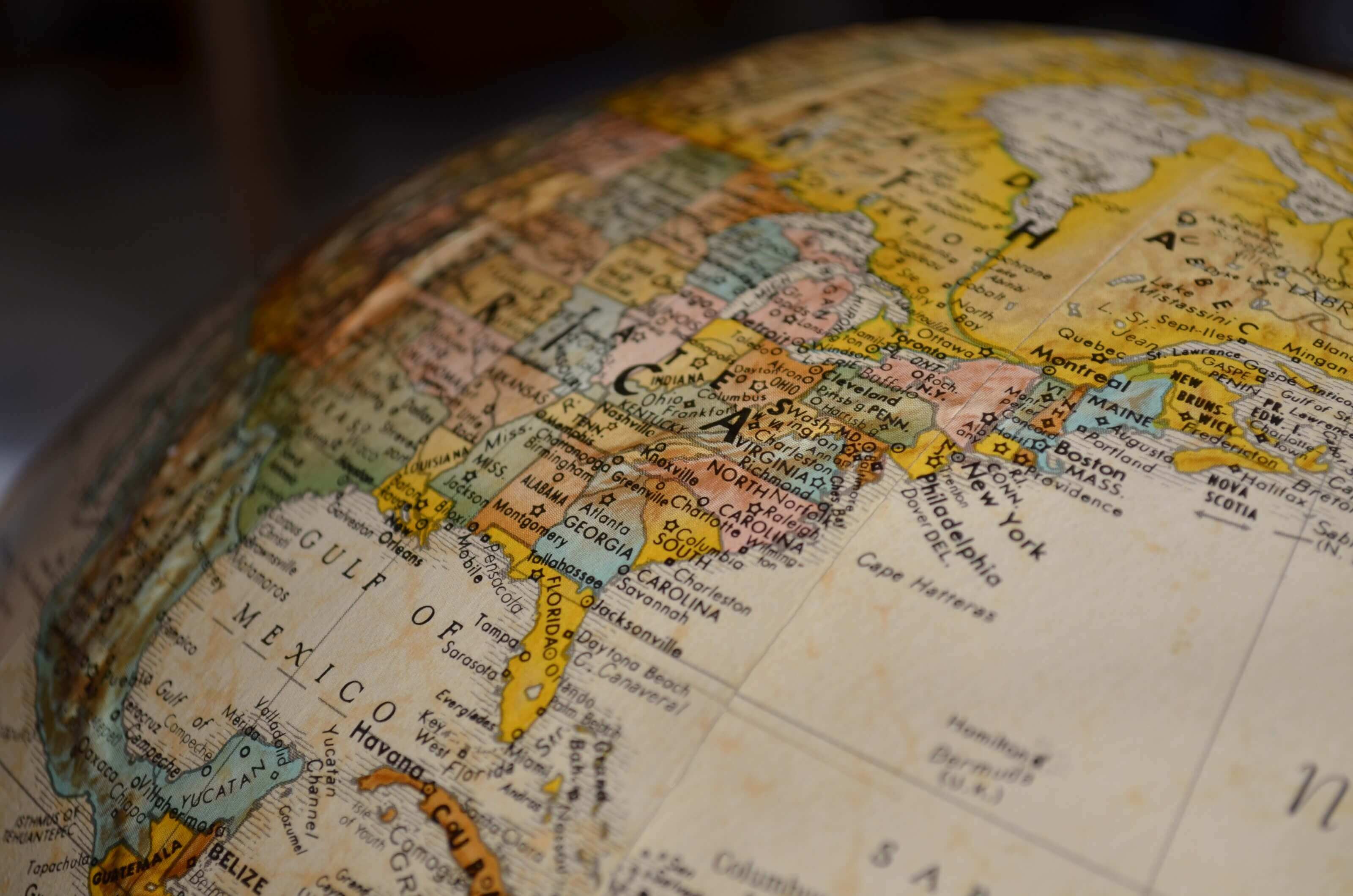
How to travel around the world: our complete guide
Last Update: 08/04/2024 5 COMMENTS
Planning a round-the-world trip (or long-distance trip) is not necessarily a small task! It can even be scary at first! You certainly ask yourself tons of questions like:
- Is it really a good decision?
- How much does it cost to travel around the world?
- Where to start between paperwork, vaccinations, insurance, and equipment?
- What about my résumé ?
- What to do with my apartment, my stuff, my furniture?
- It all seems very complicated to me…
- Aren't there dangerous places in South America?
Does this sound familiar to you? We reassure you right away, we asked ourselves these questions before leaving for our trip around the world ! To tell you the truth, we were a little bit lost when this project emerged… But after spending a lot of time on travel blogs and forums, we managed to gather a maximum of information to stop making excuses and to start without any worries .
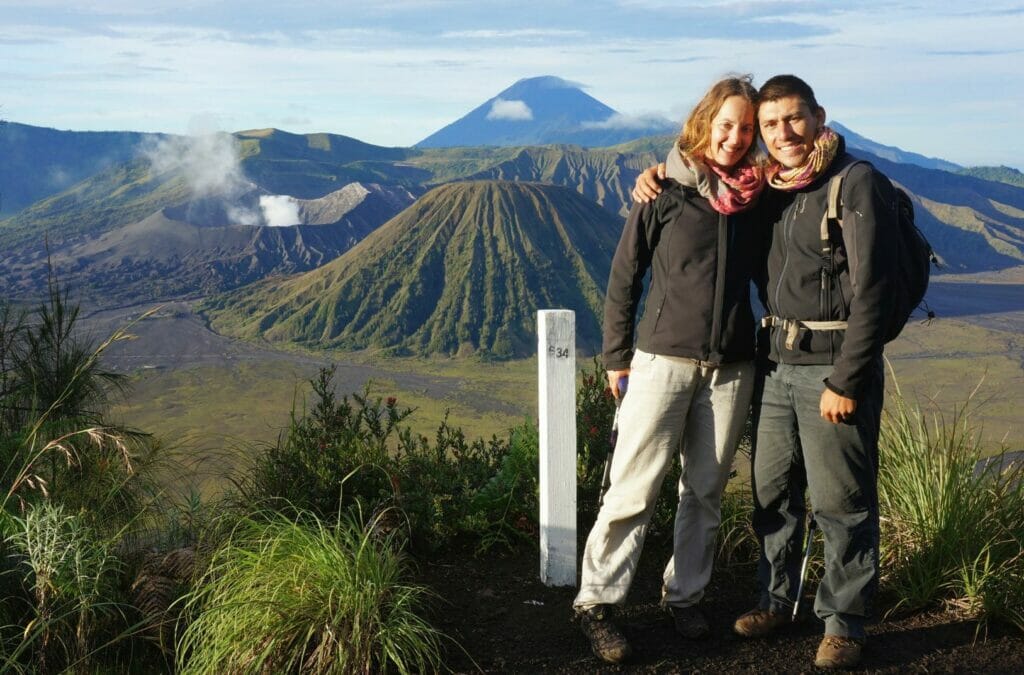
With the experience of this first long-distance trip (and the others that followed 😉), we can now share with you what we would have done differently, the mistakes not to make, the equipment that we think is essential, the useful tips, etc.
So, you want to start your round-the-world trip adventure? Follow the guide!
So we have created a complete ebook that details all the important steps to plan a round-the-world trip . This ebook is a project in which we put all our heart, it is now part of " our babies ". We hope it will help you to take the plunge and organize your world tour to make the most of this wonderful experience!
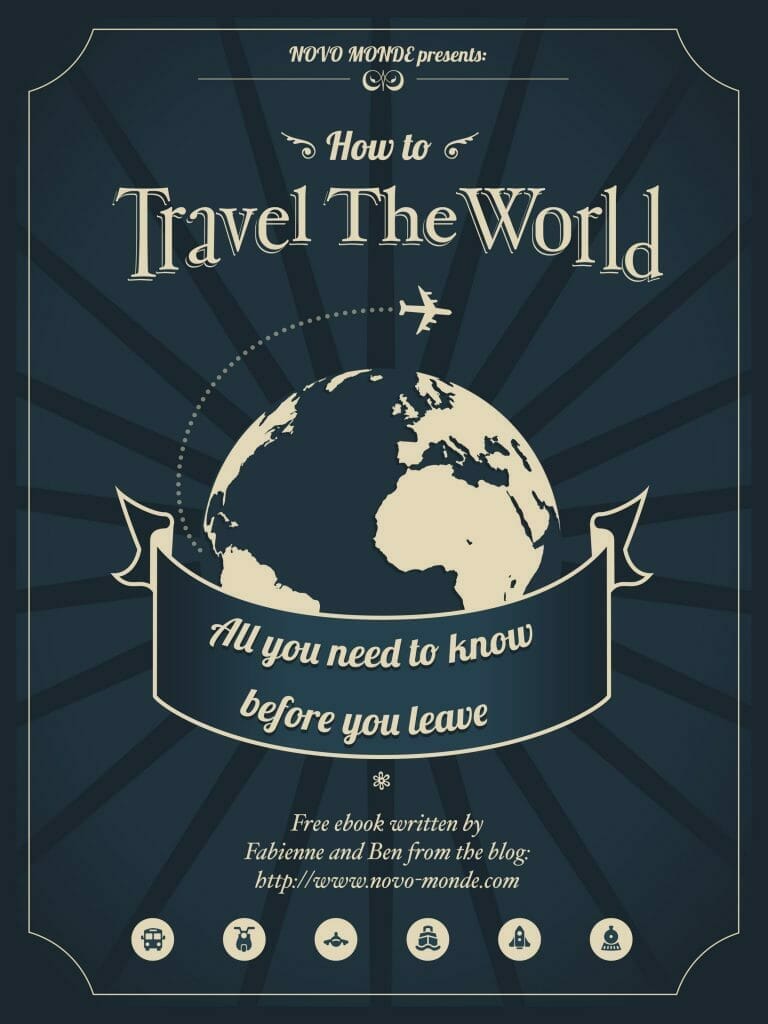
To consult the ebook, you have the choice between browsing the different pages created for each chapter (we give you the summary below) on the blog or downloading it directly in PDF format to read it quietly on your computer, smartphone, tablet, or even print it if you want!
Here is the summary of the festivities:
- Leave everything and travel
- The Itinerary
- Round-the-world Tickets
- Health and travel insurance
- Travel gear
- Checklist and schedule
Chapter 1: How to leave everything behind and travel
In this first chapter, we come back to all the reasons that push you to travel but also to the excuses that are still holding you back from quitting your job and leaving everything behind to travel around the world ! We will break down each excuse and give you solutions to solve these problems. We also discuss an important question: should you travel alone or with someone?
Chapter 2: How much does a trip around the world cost?
It's all very well to travel, but how much does a round-the-world trip cost ? In this chapter, we detail all the expenses related to a long-distance trip. Daily budget, accommodation, insurance, vaccines, equipment, transportation, visas, bank fees, budget for the return trip… Everything is covered! So you will find all our tips to save without sacrificing everything. Yes, a round-the-world trip is within your reach!

Chapter 3: How to plan your round-the-world trip itinerary?
Now that you have the budget, you will have to plan the itinerary of your travel around the world … or not! There are two different ways of doing this… We give you all the advice and all the elements to take into account so that you can establish YOUR itinerary for this trip around the world.
Chapter 4: Travel round-the-world ticket
Here again, there are 2 choices: take your plane tickets as you go or buy a travel round-the-world ticket . In this chapter, we review the advantages and disadvantages of these special round-the-world tickets and we give you all the tips to buy your plane tickets cheaper!
Chapter 5: Travelers' health
Health is an important point when you plan a journey around the world because you have to think about it beforehand with insurance and vaccines , but also during the trip with specific treatments (your usual medicine, anti-malaria medication) and the backpacking first aid kit , which is essential for the trip. In this section, you will find all our pieces of advice to be prepared for any eventuality during your round-the-world trip and leave serenely!

Chapter 6: The gear backpacking checklist
What equipment should I take for a world tour? How much clothing should I take? If this is your first long-distance trip, you may be wondering how to carry everything you will need for 6 months, 1 year, or more. It's like your home that you'll be carrying on your back for all that time, so you might as well choose each item carefully. In this chapter, we open our backpacks and give you a backpacking checklist to help you prepare your gear!
Chapter 7: Risks of traveling
Even though it has many benefits, travel still has its share of risks , and knowing about them will help you avoid or overcome them. Whether it's about diseases , security , or encountering all kinds of bugs or ailments (homesickness, motion sickness), we go over all the risks of traveling around the world!
Chapter 8: Planning your round-the-world trip and checklist
OK, you have all the cards in hand to plan your round-the-world trip, all you have to do is to establish a checklist before the big departure ! We have established a summary schedule for you, spreading out all the preparations over 1 year before D-day .
Download our free pdf E-book!
Subscribe to our Newsletter and get a free E-book with more than 100 pages to help you prepare your trip around the world
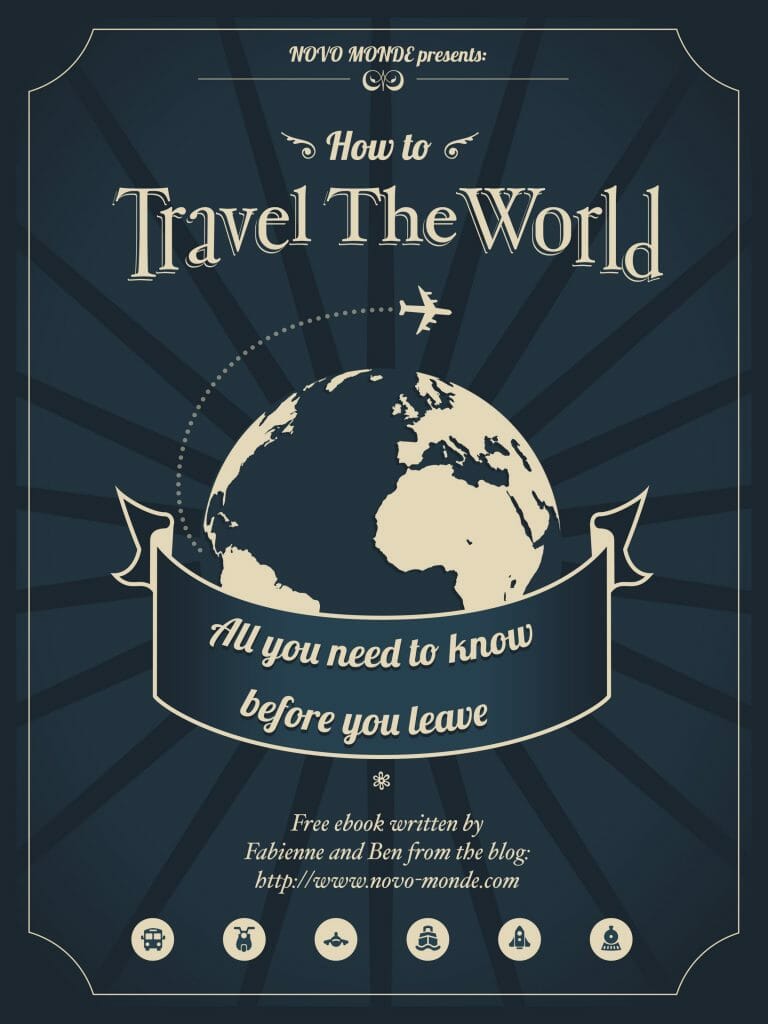
When do you plan to leave on a round the world trip? I don't know yet In the next 3 months In the next 6 months In the next 12 months In more than a year
Select all the topics you are interested in: *
Protected by Cloudflare Turnstile
Pin our ebook
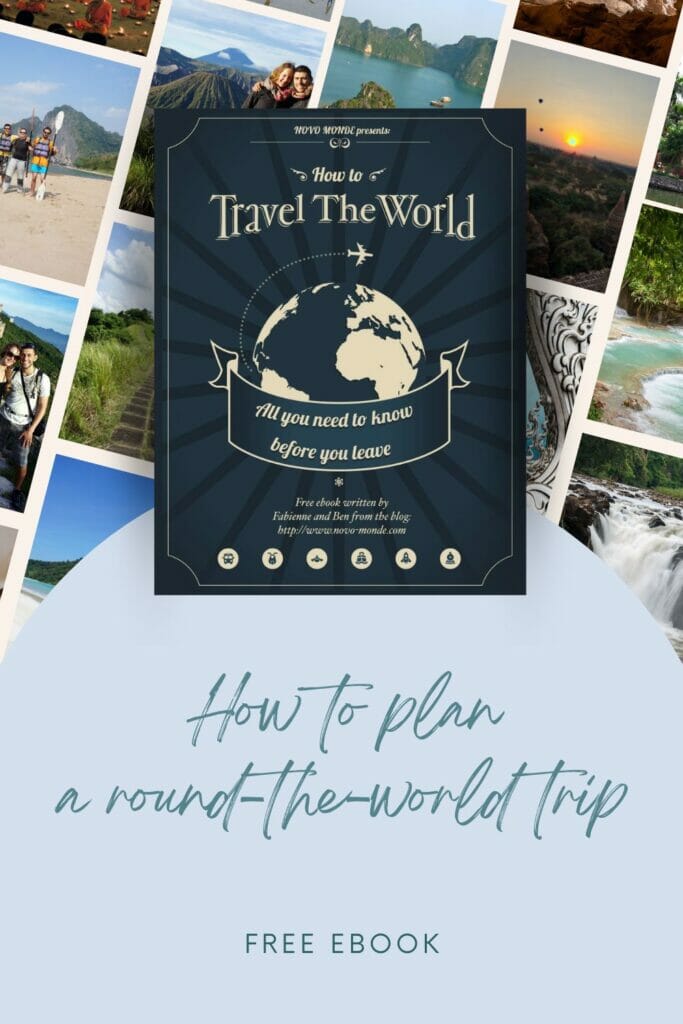
You might also like
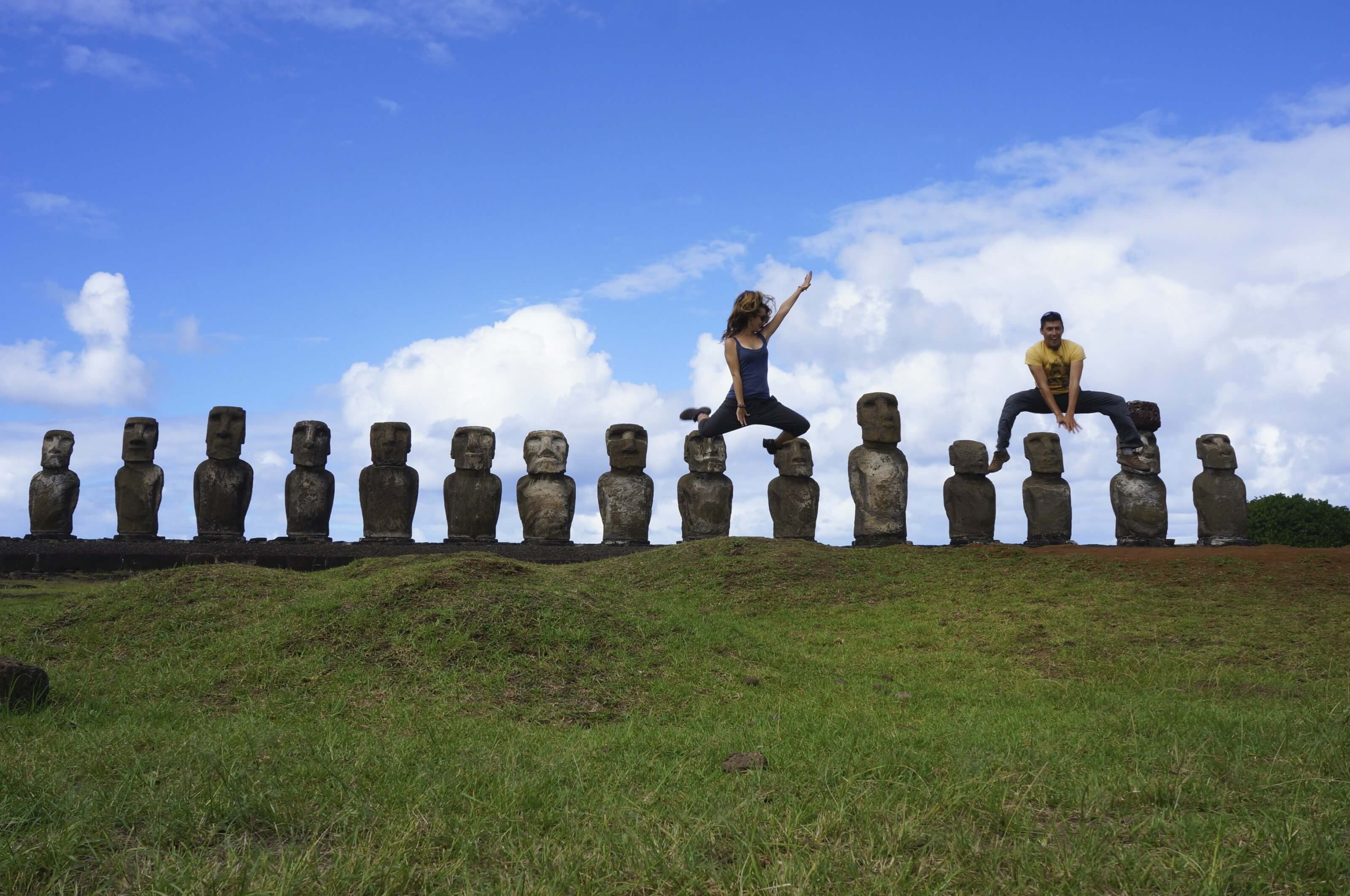
Reader Interactions
5 years ago
I LOVE your site design! You have such a beautiful theme and color scheme. And the dropped anchor on the right side of the page is a nice touch! Keep up the great work and keep living your dream life!
A Word To The Wise Poem
Thanks Wayne! We’ve put a LOT of work into our website so we are glad you like it! You too keep doing your best to chase after your dreams 😉
3 years ago
I am not sure if I’d like to travel around the world, but I’d like so much to spend some months travelling in Asia. Hope to do it soon!
Your presentation is beautiful, fun and very practically insightful. I am right now in Bansko and am able to compare your notes with reality. You have done excellent job reporting and describing many aspects of how things are. You are fresh and inspirational. Thank you.
9 months ago
I’m almost seventy years old And still have that itching in my soul to go places and meet new people, did a lot of traveling in my life (40 countries on 4 continents)my advice to young people, is don’t let life pass you by, you only live once and after thirty, time goes by so fast and never returns
Join the discussion Cancel reply
Reçois un e-mail lors de nouveaux commentaires sur cet article: Don't subscribe All new comments Replies to my comments


16 Easy Steps for Planning Your Next Trip
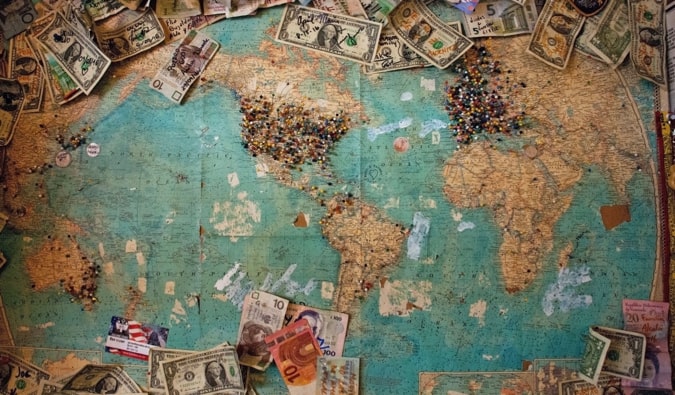
I remember when I started planning my first trip around the world. I had no idea what I was doing.
When I decided to quit my job and travel the world , I walked into a bookstore and bought Lonely Planet’s Southeast Asia on Shoestring . Buying that guidebook was my first step toward long-term travel. It made the trip seem more real, more tangible. It made it all seem possible.
While helpful, the book didn’t exactly prepare me for planning a trip around the world. Back then, there weren’t really travel blogs, sharing economy websites, and apps like there are today. I was excited and determined — but I was lost. I had to figure it out as I went, hoping I didn’t miss anything important.
Trip planning can be a daunting task. Where do you begin? What’s step one? What’s step two? What’s step three?
It’s easy to get overwhelmed, especially when you haven’t done something like this before — and especially considering just how much information there is out there these days. Blogs, social media, and guidebooks have never been more plentiful. There’s a firehose of information out there that can sometimes make the task of planning a trip even more challenging and overwhelming.
After a decade of traveling the world , I’ve planned countless trips and vacations for myself, friends, family, and even group tours. In the beginning, it was trial by fire and I learned a lot of lessons the hard way . However, that helped me develop an efficient checklist that ensures I don’t miss anything important during the trip planning process.
After all, I don’t want to get to my next destination and then realize I forgot something. And neither do you!
There is a lot of information on this website ( and even more information packed into my book ), but one question that comes up frequently is, “Matt, how do I put this all together? How do I plan a trip?”
In a continuing effort to help you get out the door and into the world, I’ve created this step-by-step guide on how to plan a trip. It works for any kind of trip — no matter how long you’re going for! Just follow this checklist and you’ll be off in no time!
Table of Contents
Step 1: Decide Where You Want To Go
Step 2: decide the length of your trip, step 3: research your costs, step 4: start saving money, step 5: get a travels rewards credit card, step 6: switch to no-fee atm cards, step 7: stay focused and inspired, step 8: check for last-minute deals, step 9: book your flight, step 10: book your accommodation, step 11: plan your activities, step 12: sell your stuff, step 13: automate your bills, step 14: pack, step 15: buy travel insurance, step 16: enjoy your trip.
If you want to jump ahead, simply click on any of the links above.

It’s a lot easier to mentally get behind “I am going to Paris in the summer” than “I’m going to Europe” or “I’m going somewhere.” Not only will your trip become more concrete for you and easier to commit to, but it will make planning easier as well…because you know what to work towards. Get specific with your plans. Get detailed. The more focused and concrete your goal, the easier it will be to actually reach it.
Resources for picking your travel destination:
- 200+ In-Depth Destination Guides
- 10 Destinations Under $50 Per Day
- The 10 Best Places to Visit as a Budget Traveler
- The 20 Best Tropical Islands in the World
How much does it cost to travel? That depends!
Without knowing how long you’re going away for, I can’t answer that question. And it’s a question you need to answer so you can start planning!
In order to figure out how much you need to save you’ll need to know how long your trip will be.
Are you going away for a week? A month? A year?
The length of your trip is a huge factor in determining how much money you need. Spend some time mulling that over until you have your answer.
For example, after you say “I’m going to Paris this summer,” add “for X days.” That way you can start to narrow down just how much money you’re going to need to save. “I am going to Paris for 10 days” is a trip that you can plan for. It’s an attainable goal.
So you know where you’re going and how long you’ll be there, but to really nail down how much money you need, your next task is to research the costs in your destination at the style of travel you want.
Do you want to backpack, or would you rather stay in luxury hotels?
How much are hostels, hotels, restaurants, and attractions?
Knowing will allow you to estimate how much money you’ll need for your trip. Here is how to research costs:
- Buy a guidebook.
- Check out my travel guide section .
- Google prices for specific things you want to do, such as scuba diving, bungy jumping, winery tours, etc. ( Get Your Guide is a good place to start for that)
You don’t need to do more than that. There’s so much information on the web that if you go down the rabbit hole of overplanning, you’ll get lost and confused by the firehose of information. Stick to those three things and you’ll be set!
In our example, if you are going to Paris for 10 days and need at least $75 USD a day (not including your flight), you know you need to save $750 USD (though round up to $800-900 USD since it’s good to have extra) for your trip.
If you were to travel around the world for a year, you’d need $50 USD a day .
Here are some other insightful posts that will help you better estimate your costs:
- 5 Ways to Make Your Money Last When You Travel
- How to Know the Travel Info You Find is Legit
- How I Research My Solo Travel Destinations

People bleed a lot of money every day through small purchases: a coffee here, a snack there. All of that adds up. In order to make changes to your spending habits, you first need to understand them. Making a list will do just that. It will also put your financial needs into a better perspective.
For example, if you need $2,000 USD for the trip you’re taking in eight months, that means you only have to save $8.33 USD per day. Couldn’t you find a way to save $8 USD per day? Heck, your daily coffee is most of that!
If you’re struggling to save money, here are 23 ways to cut your expenses and save money for travel . This will help you get started and on the road to saving money in no time!

These days, most cards have welcome offers of up to 100,000 points when you meet their minimum spending requirement. That’s enough miles for a free flight almost anywhere in the world!
If you want a free flight, sign up for the cards that help with that. If you want free hotel rooms, get a hotel card. Either way, sign up for a travel credit card and start earning points today. As long as you can pay off your monthly balance, you’ll get free travel credit.
You don’t need to sign up for very many cards either; pick one or two and focus on those. Do this the moment you decide you want to travel. Don’t wait — waiting equals lost miles, which means less free travel.
Collecting points and miles is what all the experts do to cut their costs and travel longer. It’s what has kept my costs down and me on the road for so many years. While the best cards are only available in the US, there are still plenty of options for Canadians as well as folks from Europe, Australia, and New Zealand.
For more information on travel credit cards and using points and miles, check out these posts:
- Points and Miles 101: A Beginner’s Guide
- How to Pick the Best Travel Credit Card
- The Best Travel Credit Cards
- How to Earn Points by Paying Your Rent
- The Ultimate Guide to Points and Miles
- How to Use Points and Miles in Canada
Once you’re abroad, you’re going to need money. While many countries accept credit cards, in the majority of countries cash is still king. That means you’ll need to use ATMs to withdraw the local currency.
And that also means you’re going to get dinged by ATM fees.
If you’re just away for a week or two, paying a few dollars in ATM fees isn’t the end of the world. But if you’re away for a longer period, those fees add up and chew into your travel budget — a budget you’ve worked hard to grow. Don’t give banks any of your hard-earned money.
How? By using a no-fee ATM card.
I use Charles Schwab , but there are lots of other banks (don’t forget to check your local banks) that don’t charge ATM fees. Additionally, you can join a bank in the Global ATM Alliance .
By using a no-fee ATM card you can avoid those pesky ATM fees, leaving you more money for what it was intended for: travel.
Here’s exactly how you can avoid ATM fees while traveling .
While you get closer to your goal, make sure that you keep feeding your desire to travel. Travel planning can be exhausting and overwhelming — especially if you don’t have support from your friends and family (and especially if your trip is still months away). It can often get discouraging and feel out of reach at times.
Luckily, there are tons of ways to stay focused and keep your spirits high thanks to the amazing community we have on this website. Here are some inspiring travel stories to help keep you inspired to travel:
- Why It’s Never the Perfect Time to Travel
- 13 Travel Books That Will Give You Serious Wanderlust
- How to Change the “I’m Too Poor to Travel” Mindset and Say Yes to Travel
- 8 Ways to Stay Motivated to Travel
Additionally, be sure to join our online travel community The Nomadic Network . Not only will you find support (and tons of tips) online, but we also host regular in-person and virtual events all around the world. These are a great way to get inspired, meet other awesome travelers in your area, and get travel advice.
Okay, you’re inspired, prepared, and on your way to saving money for your trip. But before you go buy that flight or book that hotel, check for deals you might have missed. You may dream of Paris but maybe there are great deals to Berlin right now. Or maybe you can get a seven-day cruise for 70% off, a package deal to Hawaii for the price of your flight to Paris, or 50% off sailing trips around Greece.
These days, there is always a deal to be found — especially if you’re flexible with your dates and/or destinations. Some deal websites worth checking out are:
- Going (Formerly Scott’s Cheap Flights)
- The Flight Deal
- Holiday Pirates
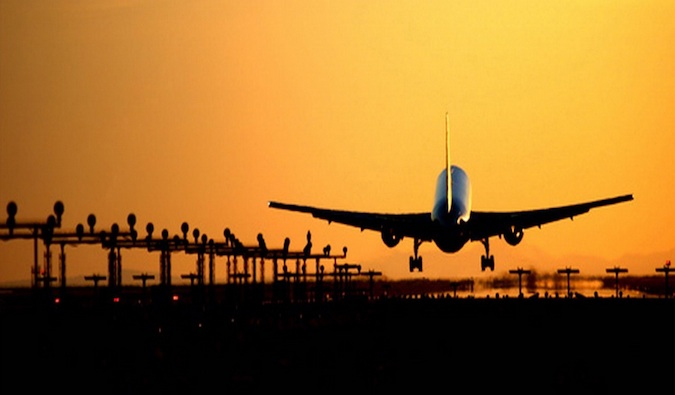
Fortunately, there are still many ways to avoid being the person on the flight who paid the most for their ticket. My two favorite sites for finding cheap airfare are:
- Skyscanner – Skyscanner is the best website for searching multiple destinations at the same time.
For the best deals, book your flight about two-three months in advance. Here are two articles on how to score a cheap flight:
- How to Find Cheap Flights
- Booking Flights: Everything You Need to Know
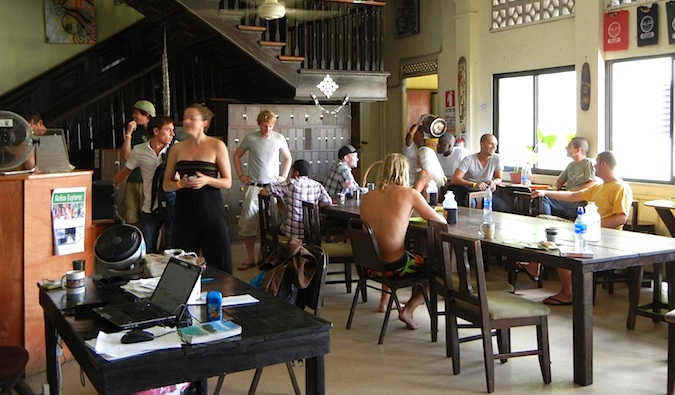
For trips longer than two weeks (or if you are going to be traveling long-term) just book your first few days. That will ensure you have a place to go on arrival. Once there, you can get insider advice from your hotel/hostel staff as well as other travelers. You can then use that info to plan your next steps.
While you can book more than your first few nights, you might end up wanting to change your plans once you land. I prefer having flexibility, which is why I always just book my first few nights and go from there.
Here are my go-to sites when it comes to finding the best deals on accommodation:
- Hostelworld – Hostelworld has the largest selection of hostels and is my go-to site for finding affordable hostels.
- Agoda – Agoda has the best results if you’re heading to Asia (though they sometimes have good US deals too).
- Booking.com – Booking.com is the best overall platform for finding budget hotels and guesthouses.
If you’re on a tight budget or you want to connect with more locals during your travels, consider joining platforms like Couchsurfing or BeWelcome . These communities allow travelers to stay with locals for free as a sort of cultural exchange.
Long-term travelers can also try housesitting or WWOOFing as well as they both offer free accommodation (in exchange for pet sitting or farm work respectively).
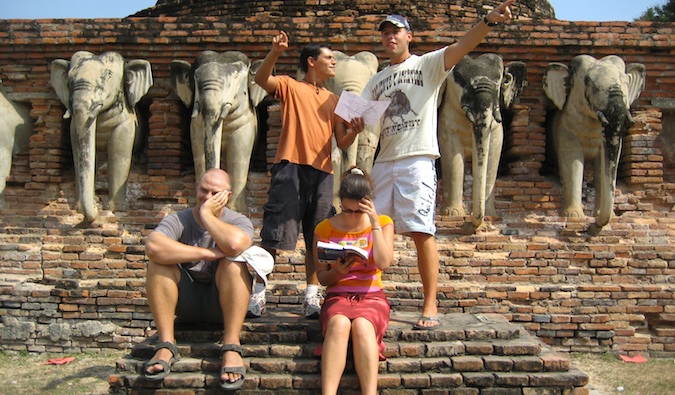
Search online for discounts as well. While some countries offer cheaper prices in person, others give discounts to those who book early/online. Research which is which for your itinerary so you can save money.
For shorter trips, you can also book your activities in advance to ensure you get tickets. For longer trips, book as you go.
Additionally, before you leave home, have a rough idea of what activities are priorities for you. That way, if you run out of time or money, you can focus on your top activities so you don’t miss out. Also, make sure to double-check that there are no holidays or other obstacles that will prevent you from certain activities as well.
If you are going on a long-term trip (six months or more), consider selling your stuff in order to earn extra money for your trip. Start doing this about 60 days before you leave. Some sites to use are:
- Gumtree – An online classified site with a focus in the UK and Australia.
- Amazon – The biggest online store in the world.
- Craigslist – Online global classifieds that have both local and global reach.
- eBay – Another global online classified site.
- Facebook Marketplace – Great for finding people near you (so you don’t need to ship your items).
If you aren’t going to be gone that long, skip this step. If you are going away long-term but want to keep your stuff, move it to a friend’s house or keep it in storage. A good storage company in the US is Public Storage . It’s one of the most affordable options out there.
Get rid of your mail, go paperless, and set up online bill payment for your recurring bills to ensure you won’t miss any while overseas. If you are still going to get paper mail, use a service like Earth Class Mail , which will collect and scan your mail for you. (If you are going on a two-week trip, you don’t really need to worry about this, so you can skip this step, too.)
If you have the option (and don’t want to pay for a mail service), you can also have all your mail sent to a friend or family member.
Additionally, you’ll want to make sure you cancel any phone plans you have or switch your plan to one that is more travel-friendly. T-Mobile is great for travelers going on trips under 3 months. For any trips longer than that, you’ll want to cancel your plan and just buy SIM cards abroad as that will be much cheaper.
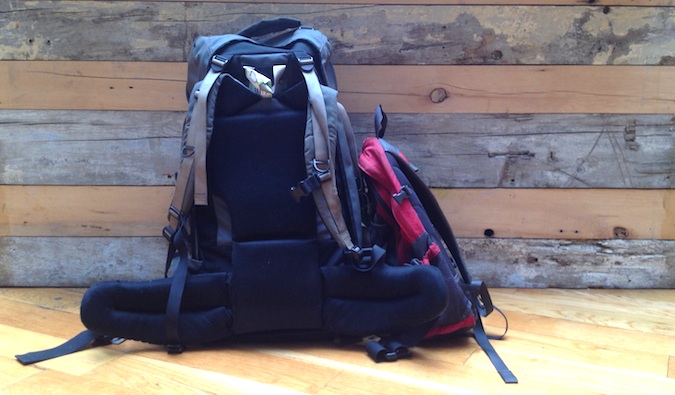
I travel with a 45L REI bag and then a smaller day bag.
Unless you’re heading to multiple climates and need bulky winter gear, you don’t need a massive 70L bag stuffed to the top. Here’s my suggested packing list to help you take just the right amount of stuff and avoid overpacking ( here’s a list for female travelers as well ).
While what you pack will depend on where you are going, remember that you don’t need to pack everything you own. You can buy things you need on the road. You can do laundry overseas. At the end of the day, you have to carry everything you bring. So bring less!
There are a few extra items you might want to pack beyond your everyday clothes, though. Some things I like to bring with me are:
- First aid kit
- LifeStraw bottle with built-in filter
- Packing cubes (to stay organized)
- Travel lock (for hostel lockers)
- Travel adapter
- Quick-dry towel
Additionally, make sure you bring any prescriptions with you so you have enough for the duration of your trip. If that’s not feasible, bring a doctor’s note and prescription with you so you can fill it abroad.
While a lot of people think, “I’m healthy, I don’t need travel insurance . I won’t get sick,” travel insurance is much more than just medical protection. It covers you when your camera breaks, your flight is canceled, a family member dies and you have to come home, or if something gets stolen.
Yes, it’s an added expense. But it’s always better to be safe than sorry. I never leave home without it because I’ve seen first-hand just what can happen on the road.
I never thought I would pop my eardrum while I was scuba diving in Thailand or break my camera in Italy .
I didn’t know I would get knifed in Colombia .
My friend never thought he would break his leg hiking.
Another friend didn’t expect her father would die and she would have to fly back home.
Unfortunately, bad things can happen when you’re traveling. True, these events are few and far between. But they can cost tens of thousands of dollars to handle on your own. If you’re not prepared to pay out of pocket, buy travel insurance.
To help you figure out the best plan for you and your trip, here’s my ultimate guide to picking a good insurance company . It will show you how to pick a good plan that covers you for when you get sick, your flights get canceled, if you get injured, something gets stolen, or your trip is delayed.
Here’s a breakdown of my recommended travel insurance companies so you can see what company offers the best plans for your needs and budget:
- SafetyWing – Super affordable plans for budget travelers.
- Insure My Trip – Best for senior travelers.
- Medjet – Provides additional evacuation coverage to ensure you get home should an emergency occur.
- Insured Nomads – In-depth emergency and non-emergency coverage for long-term travelers and digital nomads.
For more information on travel insurance, you can check out these posts:
- What Does Travel Insurance Actually Cover?
- Is Travel Insurance Worth It?
- Do You Need Medical Evacuation Insurance?
Additionally, make sure you know your rights as an airline passenger. For example, delayed flights to/from Europe often mean you’re entitled to compensation (beyond anything insurance-related).
Learn how to ensure you are compensated if your travels are delayed or your flight is canceled .

If you’re feeling nervous, don’t worry — that’s perfectly normal. You’re about to embark on an amazing adventure — and that’s a huge change. Feeling anxious or nervous or unsure is something every traveler experiences. But you’ve made it this far. Trust your planning, follow your instincts, and you’ll have the trip of a lifetime. I guarantee it.
By using this post as a guideline for your trip planning, you can better organize and prepare for your trip. You’ll check all the boxes, not miss anything, and have plenty of money for your vacation. It can be as simple as booking a flight and packing or as complex as rearranging your entire life to go backpack the world forever.
But, no matter how long your trip may be, this list will help you stay organized and motivated as you plan your trip and step out into the world.
P.S. – Yes, I did leave out visas and vaccinations, because needing those isn’t as universal as the other stuff on this list, but don’t forget to check if you need those, too!
Book Your Trip: Logistical Tips and Tricks
Book Your Flight Find a cheap flight by using Skyscanner . It’s my favorite search engine because it searches websites and airlines around the globe so you always know no stone is being left unturned.
Book Your Accommodation You can book your hostel with Hostelworld . If you want to stay somewhere other than a hostel, use Booking.com as it consistently returns the cheapest rates for guesthouses and hotels.
Don’t Forget Travel Insurance Travel insurance will protect you against illness, injury, theft, and cancellations. It’s comprehensive protection in case anything goes wrong. I never go on a trip without it as I’ve had to use it many times in the past. My favorite companies that offer the best service and value are:
- SafetyWing (best for everyone)
- InsureMyTrip (for those 70 and over)
- Medjet (for additional evacuation coverage)
Want to Travel for Free? Travel credit cards allow you to earn points that can be redeemed for free flights and accommodation — all without any extra spending. Check out my guide to picking the right card and my current favorites to get started and see the latest best deals.
Need Help Finding Activities for Your Trip? Get Your Guide is a huge online marketplace where you can find cool walking tours, fun excursions, skip-the-line tickets, private guides, and more.
Got a comment on this article? Join the conversation on Facebook , Instagram , or Twitter and share your thoughts!
Disclosure: Please note that some of the links above may be affiliate links, and at no additional cost to you, I may earn a commission if you make a purchase. I only recommend products and companies I use. Opinions, reviews, analyses & recommendations are mine alone and have not been reviewed, endorsed, or approved by any of these entities. This page does not include all card companies or all available card offers.
Related Posts

GET YOUR FREE TRAVEL STARTER KIT
Enter your email and get planning cheatsheets including a step by step checklist, packing list, tips cheat sheet, and more so you can plan like a pro!

Search a Multi-Stop Route

Plan an Around the World trip in 2024
The humans that make up AirTreks want to connect with you and to let you know that you belong. Sign-up below to receive a hand written travel related email when we have something interesting to share so you can start to learn what an AirTrek is and how it can impact your life.
Ready Round-The-World Deals
Planning tips for your around the world trip, why book with airtreks.

Customer Testimonials
Welcome to airtreks.
Super Human Service on Around the World Tickets and your complex travel needs since 1987 My name is Sean Keener, I am the lead travel servant at AirTreks and I welcome you with open arms and gratitude.
You are in the “right place” if you…
- Know that you need an around the world ticket or an air ticket with 3 or more stops (We can do up to 100 stop for country counters)
- Are interested in this concept of slow travel or long-term travel. We have been called authorities on this topic over the past decades
- Want to look at other options beside Disneyworld and Carnival Cruises and other manufactured travel experiences
- Want to explore the concept of collecting experiences vs material things
- You need a travel logistics partner to organize and book the best routes with best chance of being on time with less hassle
- Want to meet or read about people like you that have done around the world travel and how it impacted their lives and their communities.
- Want to see what an around the world trip might cost ?
- Want to explore taking your family on a life changing trip that will impact your childrens lives in ways a classroom or school can’t
- Need to book group international airfare for companies, groups, churches and schools.

Around the World Tours & Travel Packages 2024/2025
Our 27 most popular around the world trips. compare tour itineraries from 17 tour companies. 111 reviews. 5/5 avg rating., popular around the world tours.
Discover our popular around the world tours, each crafted with unique themes, diverse price ranges, varying durations, and different physical levels. Search several options and choose the tour package that aligns seamlessly with your vision of the perfect trip around the world.

Discover the Baltics
- Discover three Baltic states in 12 days
- Visit stunning national parks, castles and museums
- Explore the magnificent Trakai Castle

Budapest to Prague Adventure
- Discover the four distinctive capital cities of Budapest, Bratislava, Vienna and Prague
- Enjoy a wine tasting in the charming town of Mikulov
- Walk through the castle park known as 'the garden of Europe' at Chateau Lednice

The Grand Epic of Egypt, Jordan, and Israel
- Discover the mysterious pyramids, Great Sphinx, and Kings Valley
- Cruise leisurely along the Nile from Aswan to Luxor
- View the Promised Land from Mt. Nebo and the Mosaic Map of the Holy Land
- Trace the footsteps of Jesus and explore the old and new cities of Jerusalem

Get Social: Europe Express 2024-25
- Berlin highlights drive
- Walking tour of Prague with Trip Leader
- Vienna highlights drive
- Orientation walk in Venice with Trip Leader
- Orientation walk in Paris with Trip Leader

London to Istanbul Rail Adventure
- An iconic rail journey across Europe to the gateway of Asia
- Discover rural Serbia, from local wine producers to narrow gauge railway routes
- Take a boat trip on Europe's largest wetlands in Croatia and explore the waterways of Venice

Cape Town to Victoria Falls - Hotel/Lodge
- Visit Cape Town, the most exciting city in Africa
- Discover the mountainous dunes of Sossusvlei
- See the fantastic wildlife of Etosha National Park
- Visit the Okavango Panhandle and Chobe National Park
- Marvel at the mighty Victoria Falls

Balkans Rail Adventure
- Visit seven countries of Former Yugoslavia in just 16 days
- Experience a variety of scenic rail journeys
- Discover contrasting landscapes and cities in this lesser visited region

Imperial Escape
- Budapest: Welcome dinner; guided sightseeing, panoramic view from Fishermen’s Bastion, visit Heroe’s Square
- Vienna: Guided sightseeing, visit Heldenplatz and St. Stephen’s Cathedral
- Prague: Guided sightseeing, Astronomical Clock, visit the Hradčany Castle grounds; farewell dinner at a local restaurant
- On this guided vacation of Central Europe, experience the rich history and most popular destinations without the crowds—and even better—without the high-season prices
- This Central Europe escorted tour is a magnificent journey through the former Habsburg Empire offering romantic castles, churches, villas and modern architecture, vineyards, breweries, first-class shopping, art, and culinary delights
All Around the World , expedition cruises, self guided adventures and vacation packages. Find the best guided and expert planned vacation and holiday packages. Read more about Around the World

Small Group Around the World Tours

Peru, Chile, Argentina & Brazil in 20 days - Machu Picchu, Iguazu & Capital Cities - Superior
- Santiago de Chile
- Barrio La Boca
- Buenos Aires
- Iguazu Falls, Argentinian side

Indochina in 35 days - 5 Country Southeast Asian Discovery - Superior
- Kuala Lumpur

South American Odyssey with Amazon & Peru
- Rio de janeiro : Cable-car ride up Sugar Loaf Mountain and Sugar Loaf cocktail party; sightseeing with a Local Guide; visit Corcovado Mountain and the cathedral; Churrascaria dinner
- Iguassu falls : Sightseeing with a Local Guide on both the Brazilian and Argentinean sides of Iguassu National Park; Ecological Jungle Train
- Buenos aires : Walking tour; visit the Metropolitan Cathedral and Recoleta Cemetery; empanada cooking class; Tango lesson & show; visit a local estancia
- Bariloche: Sightseeing with a Local Guide; chairlift to Cerro Campanario; Andes lake crossing
- Puerto montt : Sightseeing tour
Best Around the World Tours by Duration
World tours usually span from shorter escapes to extended journeys lasting a few months. Explore our tailored selection of around the world tours by duration, ensuring an efficient and fulfilling use of your precious time away.
Tours, Cruises & Private Trips
Best Around the World Tours by Price
Experience the world without compromising your budget with our selection of around the world tours by price to cater to every financial spectrum. Choose the tour package that perfectly aligns with your budgetary preferences for an unforgettable trip around the world.
Top Around the World Attractions
- Meeting locals from several different countries and discovering wonderful similarities and differences
- Seeing whales breach from the balcony of your cruise stateroom and diving and snorkeling in vibrant coral reefs like the Great Barrier reef
- Enjoying local cuisines, exploring street food markets, and taking cooking classes to learn how to make traditional national dishes
- Wandering around many archaeological ruins and historical sites like Machu Picchu , pyramids of Giza , and the historical city of Petra
- Discovering unique cultures and taking part in traditional festivals or ceremonies like Holi or Día de Muertos
- Hiking among different landscapes, encountering majestic wildlife on African Safaris , and taking memorable pictures
- Making lifelong friends from around the world
- Indulging in luxury around the world trips featuring traditional Japanese ryokan, floating hotels in the Maldives, or ice hotels in Sweden for a unique experience.
- Visiting all the most famous locations during a single trip with custom-planned tours around the world — No need to pick and choose!
Around the World Tours & Travel
Around the World Attractions & Landmarks Guide
- Winter vs Summer Weather: Since your tour around the world is likely to cross hemisphere lines more than once, you may experience warm highs and icy lows during your trip — bring clothing that can layer easily.
- Shoes: Footwear can easily become a packing challenge since it can take up a lot of space in suitcases. Choose shoes according to the planned activities and terrains. Pack a versatile selection: a pair for relaxation, one for hiking, another for city strolls, and one for a more refined option.
- Dress Like a Local: The beauty of a trip around the world is the opportunity to visit many far-flung places with diverse cultures and ways of life. You may encounter many different cultures, some with specific dress expectations. For example, in most Middle Eastern countries, expect to dress modestly—cover shoulders and legs and keep a scarf handy for covering your head. A similar dressing is also a good rule for touring many religious establishments.
Trip Reviews
Great holiday.
Really interesting trip made extra special by our guide Melia, whose knowledge was incredible. We were really lucky with the weather and had a really good group o...
Brilliant Trip
This is a well designed trip giving an excellent overview of all three Baltic states. This not only included the capital cities but other towns and much countrysid...
Travels in the Baltics
A bit of a whirlwind tour although the three Baltic States relatively small, green and flat. I knew virtually nothing about them before I went but learned a lot ...
Three small countries with a lot of character
The Baltic countries are interesting and the old towns are charming. They have suffered a lot under various foreign rulers and are proud of their independence. The...
Explore and discover the Baltics
I enjoyed discovering an area of Europe I knew little about. Visiting many areas of all 3 countries. Guide well organized and itinerary good. Only problems were T...
See all Around the World reviews
Around the World Tours FAQ
1. How much does it cost to tour the world?
2. What is the best world tour?
3. What is the best way to travel around the world?
4. How do I plan a world tour?
5. What are the pros and cons of taking a tour around the world?
My itinerary
This is a free demo version of our mapping software.
Create an account to save your current itinerary and get access to all our features.
Otherwise your data will be automatically deleted after one week.

Accommodations
Theme parks, disney cruise line – what you need to know, cruise line ships, disney private islands, recent walt disney world, recent disneyland, disney world reviews, other park reviews, recent reviews, allears style, newsletter home, recent disney and florida attractions news blog.
- A BEAND NEW Menu Is Coming to a POPULAR Prix Fixe Restaurant in EPCOT
- Trust Me. If You Think You're Being Smart by Rope Dropping This Magic Kingdom Ride, You're Not.
- 83% of Disney Adults Are DEVASTATED By This Abandoned Disney World Attraction
- AllEars TV: EVERYTHING in Disney World in 100 Days - Episode 28: Could Rain RUIN Our Challenge?
- The New Amazon T-Shirt Every Disney Mom Will Be Wearing to Disneyland
- ( view all posts )
How EXPENSIVE Will Your 2025 Disney World Trip Be?

It’s only September, yes, but do you know what that means? 2025 is only 3 WHOLE MONTHS away. The new year will be here before we know it!

We already know A LOT is on the way for Disney World in 2025 — we’ll be getting a new Villains show in Disney’s Hollywood Studios , construction will have begun on the new Tropical Americas section of Animal Kingdom (taking the place of DinoLand U.S.A.), and we know that we should be seeing progress on the Villains Land and Cars Land coming to Magic Kingdom in the coming years. If you’re planning to head to the parks to experience the magic in 2025, you need to know that unfortunately, it’ll cost you MORE than it did in 2024.
Before we begin, we want to remind you that using a Disney World travel agent is the way to go when you book your vacation, especially if you’re concerned about your budget! A travel agent’s services are free to you, and Disney is introducing new discounts all the time. Your agent will stay on top of those announcements, and be able to help you get any new promos that will reduce your cost between the time you book your trip and when you take it! We highly recommend using Mouse Fan Travel to book your trip — they’re true experts and won’t lead you astray!

For this exercise we’ll be using two different example families since no Disney World vacation group is the same. Your travel party may not fall exactly into one of these categories, but hopefully it can give you a better idea of what you should expect to pay. Disney World prices can fluctuate wildly though, so remember that this is just an estimate!
Our Sample Families!
Our first sample family has two adults and two kids (ages 11 and 16) . They’re planning a trip from June 21st to June 27th, 2025 (six nights) and are coming from Baton Rouge, Louisiana.

Our second sample family is made up of two adults with no kids . They’ll be traveling from New York City to stay for seven nights in Disney from September 13th to 20th, 2025.

Each of these families are planning vastly different trips, so let’s break it all down!
The Disney World Hotel
Our first sample family has decided to stay at Pop Century Resort — a popular value resort with access to the Disney World Skyliner. This will cost them around $229.50 a night .

Our second sample family has decided to stay at Disney’s Wilderness Lodge — a deluxe resort within walking distance to Magic Kingdom with bus transportation to the other parks. This will cost them around $546.57 a night.

Disney does allow guests to book their hotel and park tickets together, which for the sake of this experiment, is what both families decided to go.
Park Tickets
By booking their tickets with their hotel room, both families have access to the parks each day of their trip , but they don’t have to use them if they’d rather spend a day lounging at the hotel! Since both families are traveling for an extended period of time, they decided to leave Park Hopping off of their tickets.

This means that for park tickets and their hotel stay, Sample Family 1 will pay around $4,606.80 for their vacation package while Sample Family 2 will pay around $5,592.98 for their vacation package.

But we can’t forget about the dining!
The Disney Dining Plan is a fantastic tool that can make planning meals easier, since you’re paying for them ahead of time! However, it’s not always worth the price for every single family.

Sample Family 1 has decided to book the Table Service Disney Dining Plan with their vacation package, bringing their total for park tickets, hotel stay, and dining plan up to $6,953.72.

Sample Family 2 however does not feel the dining plan will be beneficial to them, so they’ll pay for their meal out of pocket. In this example, they will pay $30 per day for breakfast, $45 per day for lunch , and $50 per day for dinner . They’ve also opted for 2 table-service or character meals at around $215 . This brings our couple’s total to $1,090 for dining.
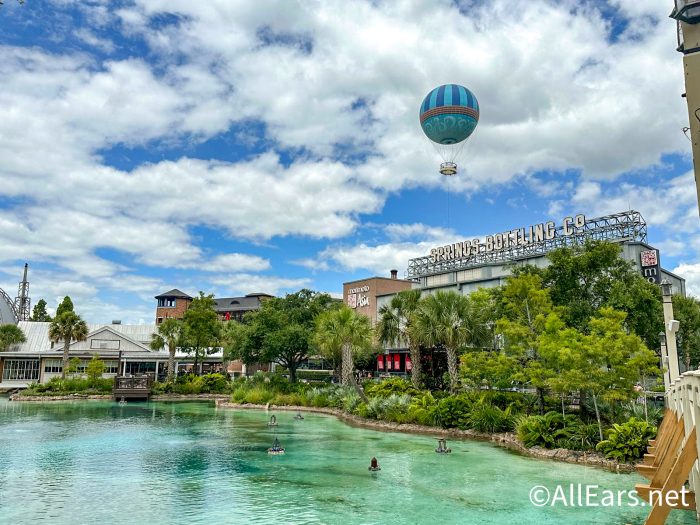
But these families have to GET to Disney World too, and neither of them have chosen to drive!
Prices are all over the place when it comes to airline tickets, so keep in mind these are just estimates. Our family of four is flying in from Baton Rouge, LA, and they secured round-trip airfare for approximately $1,412 . To get to Pop Century from Orlando International Airport, they’ll be taking Mears Connect which will cost $121.80 total.
Sample Family 2 is flying in from New York City and snagged round-trip airfare for around $494 . *It’s important to note that at the time of writing this, flight prices were not yet available for September 2025 flights, so this pricing is based off of September 2024 prices.*
They also used Mears Connect to get to and from Disney World and the airport for a total of $67.20 .
Additional Optional Expenses
There are so many ways to upgrade your Disney World vacation! You can pay to skip the lines and save time waiting with Lightning Lane Multi Pass and/or Lightning Lane Single Pass , or get tickets to an after-hours event like Mickey’s Not-So-Scary Halloween Party or Mickey’s Very Merry Christmas Party if you’re traveling at the right times.

Lightning Lane Multi Pass and Single Pass uses date-based pricing per park, per day , which makes it tricky to plan out how much you’ll be spending ahead of time. Since both families are staying on property though, they get to book 7 days in advance of their trip! For the sake of this exercise, we’ll use an average price of $24 per person per day for Lightning Lane Multi Pass , which includes the option to park hop each day. However, both Sample Families decided to get 2 Lightning Lane Single Pass reservations throughout the duration of their trip, which let’s say adds on an additional $40 per person . That means Sample Family 1 would pay $832 overall for Lightning Lane Multi Pass (spending , and Sample Family 2 would pay $464 . Again, this is to use Lightning Lane Multi Pass on EVERY day of their trip, plus those two Lightning Lane Single Passes.

Memory Maker is another optional add-on, where you can pay one price to download all of the Disney PhotoPass photos from your vacation. Guests can pay a one-time fee of $185 ahead of their trip and have access to all their photos taken by Disney PhotoPass Photographers, or pay $210 while they’re on vacation . However, neither of our families chose to get Memory Maker.
For Sample Family 1 , here is their cost breakdown:
- $4,606.80 for park tickets, hotel stay, and Disney Dining Plan
- $1,412 for plane tickets
- $121.80 for Mears Connect
- $832 for Lightning Lane Multi Pass/Single Pass
Their approximate total cost before spending/souvenir money = $6,972.60

For Sample Family 2 , here is their cost breakdown:
- $6,682.98 for park tickets, hotel stay, and dining
- $494 for plane tickets
- $67.20 for Mears Connect
- $464 for Lightning Lane Multi Pass/Single Pass
Their approximate total cost before spending/souvenir money = $7,708.18

If you book your vacation ahead of price hikes and changes, which often hits right around the start of the fiscal year (aka right around New Years), they won’t affect your trip. This means that the prices we’ve discussed above will likely increase beyond what they currently are after the start of the fiscal year, but if you were to book between now and the end of the year, you’d be looking at right around these prices.
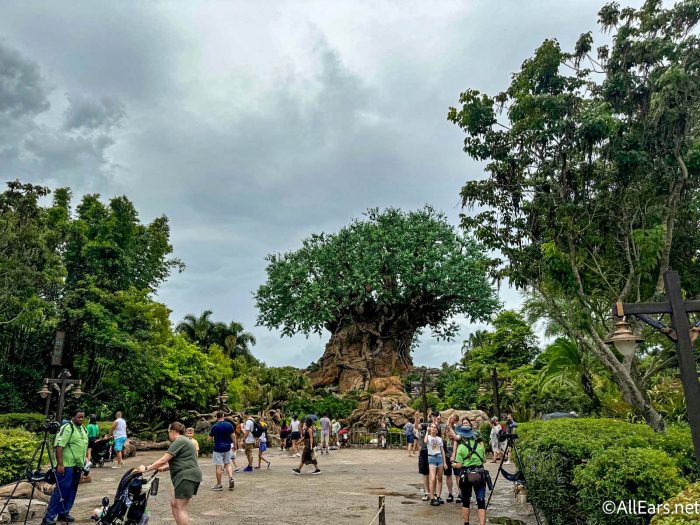
As always, stay tuned to AllEars for all the latest Disney World planning tips and tricks!
5 Critical Disney World Hotel Warnings to Watch Out for in 2025
Join the allears.net newsletter to stay on top of all the breaking disney news you'll also get access to allears tips, reviews, trivia, and more click here to subscribe.
Are you planning a Disney World trip for 2025? Tell us in the comments!
Trending Now

A Tokyo Disney ride will be closing permanently soon to make way for a brand-new...

The latest Halloween popcorn bucket has arrived at Disney World.
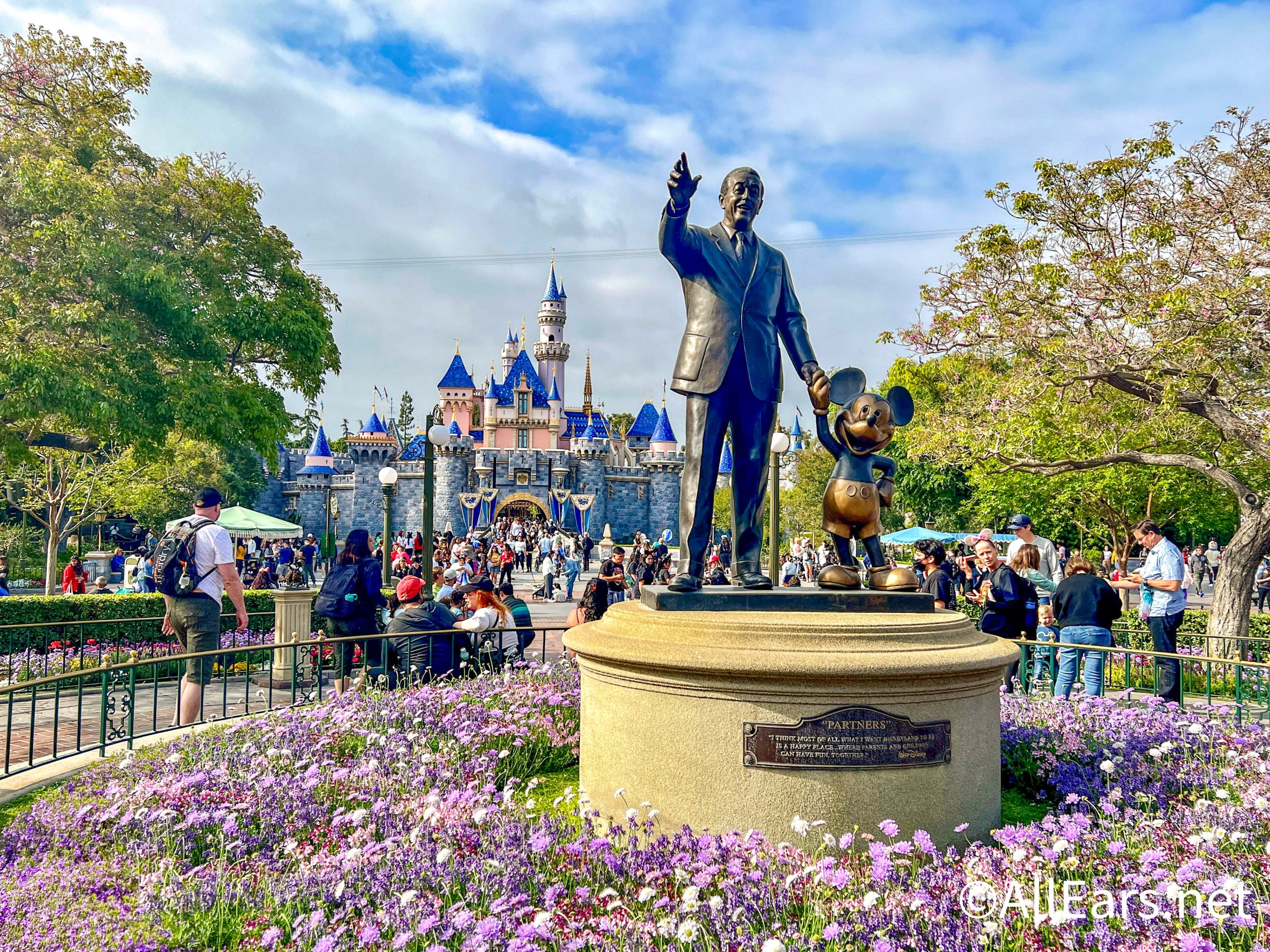
Heading to Disneyland next month? Some rides won't be open for part of the month,...

Brightline has announced NEW perks coming soon!

Loungefly sale alert!

An extremely important holiday is coming up soon and EPCOT is celebrating in the BEST...

A former Disney Imagineer just gave us some insider information into what REALLY happened to...

Let's talk about why people are avoiding this Disney World hotel until 2027 (and Why)!

We wanted to give you a heads-up that TWO rides have officially closed today in...

We have good news for those who didn't get one of the first 2024 'Nightmare...

We've scoped some of the best deals on Amazon and are sharing them with you!
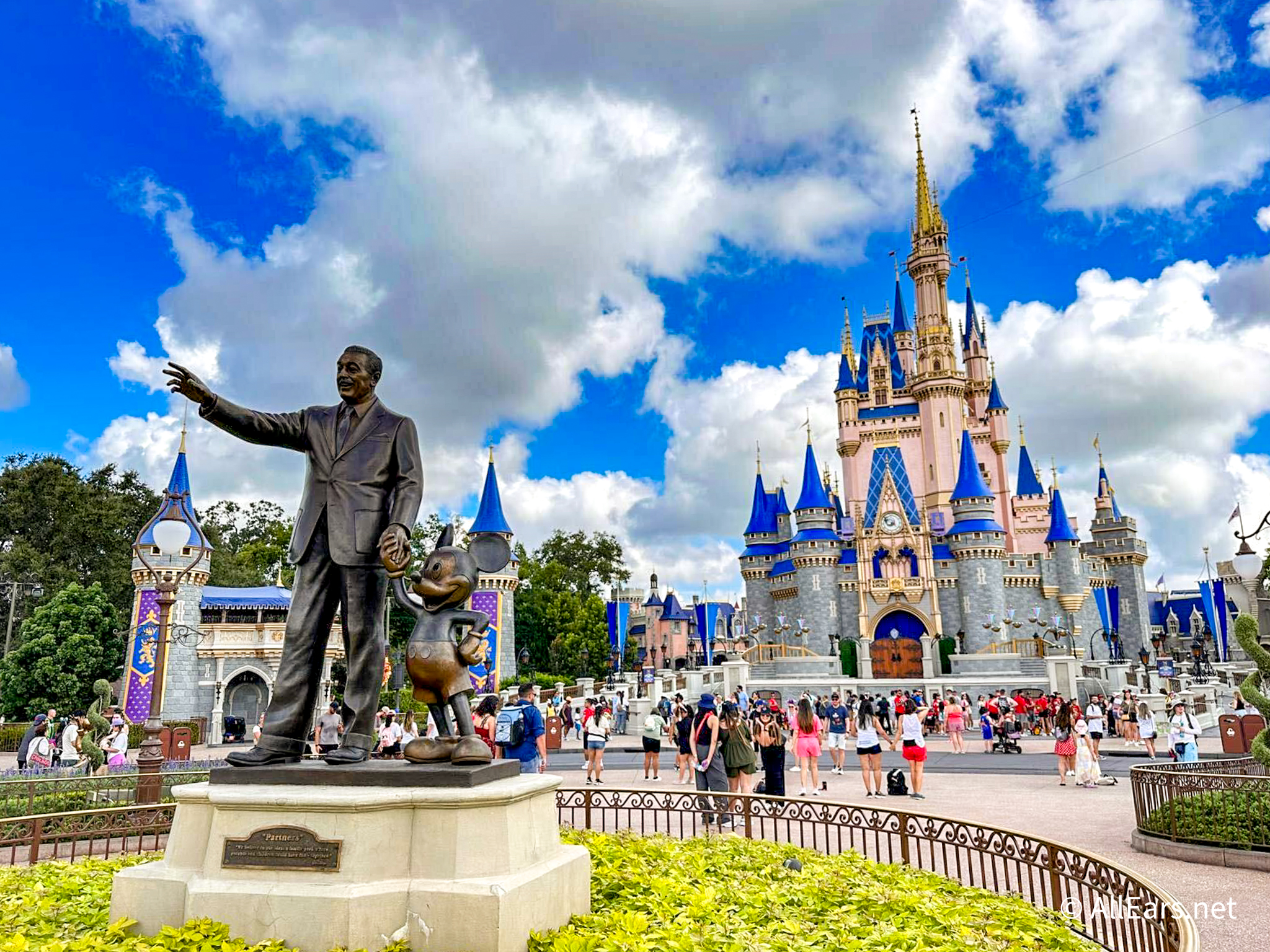
There's a NEW phone hack for Disney World!

Let's talk about the Flying Fish Restaurant and how for some people, the meal wasn't...

Get ready for the most INTENSE game of Uno you'll likely ever see in Disney...

There are a LOT of new shops in Star Wars: Galaxy's Edge at Disneyland. It...

Let's talk about the souvenirs you'll want to check out on your next trip to...

Why pay full price for Disney LEGOs when you don't have to?

Let's talk about some of the things Disney World hotel bathrooms urgently need!

The EPCOT Transformation is finally completed, but what about the Mary Poppins attraction? We asked...

Disney World isn't exempt from mistakes, and as hard as they try, sometimes an experience...
Leave a Reply Cancel reply
Your email address will not be published. Required fields are marked *
Follow us on Social!

Shop the Disney Store | AllEars® Merchandise | Shop Amazon | Press Room | Contact Us
Read more About us or Advertise with us . We respect your right to privacy. Please take a moment to review our privacy policy and terms of use .
Copyright ©1996-2024 AllEarsNet, LLC, All Rights Reserved. AllEars.Net, AllEars® Newsletter and any other properties owned by AllEarsNet, LLC are not affiliated with, authorized or endorsed by, or in any way officially connected with, The Walt Disney Company, Disney Enterprises, Inc., or any of their affiliates. All Disney artwork, copyrights, trademarks, service marks, and trade names are proprietary to Disney Enterprises, Inc. or, its subsidiary, affiliated and related companies. For official Disney information, visit http://www.disneyworld.com
- Search Please fill out this field.
- Manage Your Subscription
- Give a Gift Subscription
- Newsletters
- Sweepstakes
- Disney Vacations
The Disney Dining Plan — Here's How to Plan a Nearly All-inclusive Trip
Here's what you need to know to make the most of this Disney World package.
Amy Smith/Walt Disney World
After theme park tickets, travel, and accommodations, the next biggest component to factor into your Disney World vacation budget is food. Guests at Disney World Resorts however have the option to purchase a Disney Dining Plan, which provides a way to prepay for your favorite snacks, meals, and drinks before arriving. Not only does this give your vacation an all-inclusive feel, but also if you plan ahead, it can even save you money.
With the plan, guests use credits to prepay for meals available at hundreds of dining locations throughout the four theme parks, two water parks, dozens of resorts, and Disney Springs. Here’s everything you should know about the Disney Dining Plan so you can decide if it’s the right add-on for you.
What is the Disney Dining Plan?
The Disney Dining Plan is an optional add-on that can be selected and paid for ahead of your vacation. It can only be added if you book a Disney Resort Hotel Package and it is charged on a per-person and per-night basis. This means if you have three people on your reservation and you add on a dining plan, you must purchase three dining plans for every night of your stay.
Guests with dining plans are allotted a certain number of meal and snack credits for each night of their vacation; the exact number and type of credits depend on the plan selected. Credits can carry over to the next day if you don't use them.
Using the plan is easy and requires a simple scan of a MagicBand+, MagicMobile pass, or Key to the World card. Guests can easily keep track of their credits as the balance is listed on receipts after each transaction and can also be found in the My Disney Experience app.
Types of Disney Dining Plans
There are currently two plans to choose from: the Disney Quick-Service Dining Plan and the Disney Dining Plan. According to research from the Disney Tourist Blog , 2024 Disney Quick-Service Dining Plans are priced per night at $57.01 for adults and $23.83 for children ages three to nine, and the Disney Dining Plan is priced per night at $94.28 for adults and $29.69 for children. These prices are expected to go up by a few dollars and cents in 2025.
The right plan for you comes down to your preferred dining style. If you want to eat on the go, the Quick Service Plan is very convenient, but the standard Disney Dining Plan may be the better choice if you hope to take a break with a table-service meal. The latter also gives you the option to combine table-service meal credits for an upgraded experience.
Quick Service Dining Plan
The Disney Quick-Service Dining Plan is for those who enjoy a more casual approach to their vacation dining. This plan includes two quick-service meal credits and one snack or drink credit per day. A resort-refillable drink mug is also included for each person on the plan, and it can be used at any self-service beverage station at Disney resort hotel quick-service locations for the duration of the stay.
Disney Dining Plan
The Disney Dining Plan is best for those who want both casual dining and table-service experiences. This plan includes one table-service meal, one quick-service meal, and one snack or drink per day. This plan also includes one resort-refillable drink mug per person.
The Disney Dining Plan gives guests the option to redeem two table-service meal credits for specialty dining experiences and private in-room dining (at Disney’s Grand Floridian Resort & Spa). Those on this plan can also redeem two quick-service meal credits for a pizza meal at select value and moderate resorts.
David Nguyen/Disney Parks
What can you order on a Disney Dining Plan?
Quick-service meals.
Quick-service meals for guests ages 10 and older include one entrée and one beverage (guests 21 and up can order a qualifying alcoholic beverage where available). Guests ages three to nine must order from the children’s menu.
Table-Service Meals
Table-service meals include one entrée, one dessert, and one beverage, or one buffet or family-style meal, for guests ages 10 and older. Guests ages three to nine can redeem a table-service credit for one children’s menu combo meal or one buffet or family-style meal. Gratuities are not included, except for the Hoop-Dee-Doo Musical Review and Cinderella’s Royal Table.
Snacks and Drinks
Eligible snacks are subject to change by food stall, but generally, you can use your credits on soft drinks and water bottles, fresh fruit, and ice cream. You can look for the dining plan sticker on each vendor's menu to see what's available with the plan. Snacks that are more than one serving, served in a souvenir container do not count.
Nonalcoholic beverages include soda, coffee, tea, hot chocolate, milkshakes, and fresh smoothies. For ages 21 and older, alcoholic options include beer, wine, sangria, mixed drinks, and specialty cocktails, when available.
Resort Refillable Mugs
Both plans will provide you with a souvenir mug that you can take home and refill at self-service locations inside the Disney Resort hotels.
Kent Phillips/Walt Disney World
Where can you dine on the Disney Dining Plan?
Disney dining plans don't necessarily mean you have total freedom of choice for what and where you eat. For the most updated list of restaurants participating in the Disney Dining Program, check the official website and make sure the dining plan filter is on.
Quick-service meal credits can be redeemed at over 100 locations throughout the theme parks, water parks, and resorts and table-service credits can be redeemed for meals at many locations throughout Walt Disney World Resort, including the beloved character meals at restaurants.
You can even visit signature and fine dining restaurants on the Disney Dining Plan, but you will have to redeem two table-service dining credits per person (rather than just one). Eligible locations include fine dining restaurants, dinner shows, and signature restaurants like Be Our Guest Restaurant . Not all locations will accept dining credits, such as the one-Michelin star Victoria & Albert’s at Disney’s Grand Floridian Resort & Spa.
Is the Disney Dining Plan worth it?
It’s entirely possible to save money by using the Disney Dining Plan, but this is largely dependent on how you choose to redeem your dining credits. If you strategically choose the most expensive options available, like an artisanal milkshake or a $15 specialty cocktail over a soda, your savings will add up. Choosing more expensive restaurants, like character dining locations that accept single table-service credits, and pricier entrées will also help maximize the value of your credits.
That said, many guests select these plans purely for the peace of mind of knowing that a major chunk of their vacation spending is already budgeted for as the Disney Dining Plan adds that all-inclusive feel. However, if your family enjoys table-service dining for every meal, then it may not be the best fit for you.
Harrison Cooney/Walt Disney World
The Fine Print
The Disney Dining Plan is exclusively available for guests staying at Disney World hotels . Packages are currently open for booking on Disney World’s website, over the phone, and through authorized Disney travel agents .
Each plan has a set number of meals and snacks offered based on the length of stay, but credits can be redeemed at any point throughout your vacation. Meals cannot be transferred to another party member, and the package expires at midnight on the day of checkout. Every member of your party, ages three and older, must have the same package for the entire duration of your stay. The dining plan can be added after a vacation package is booked, and restaurant options may be limited depending on availability.
Related Articles
Planning a trip to Thailand? You may have to shell out more. All about proposed tourism tax
Sorawong thienthong, thailand's new tourism minister, plans to levy tourism tax to boost revenue..

By Stephanie Rosenbloom
If a hotel full of children is not your idea of a vacation, why not try a getaway just for grown-ups? From posh city hotels to tropical resorts, these new and recently expanded adults-only escapes beckon solo travelers, couples and friends with nature hikes, classes like pottery and macramé, spa treatments, tequila tastings and perhaps the greatest luxury of all: peace and quiet.
Sedona, Ariz.
After being closed for two years, this longstanding escape amid the red rocks of Sedona has reopened following a $40 million renovation and expansion. Part of the Relais & Châteaux hotel network, the hotel’s new additions include the Hummingbird at Mii amo restaurant, where you can enjoy seasonal local produce. There’s also a 3,300-square-foot movement and fitness studio; a reflexology path designed to massage and engage acupressure points on your feet; an expanded spa, where you can get a massage with CBD oil and try reiki or hypnosis; and a yoga lawn.
Choose from 16 renovated casitas and seven new casita rooms and suites. All of the property’s 23 rooms have fireplaces, outdoor spaces and heated bathroom floors. The new suites have soaking tubs from which you can take in the views.
Visits to the resort, which in the past have been offered for three-, four-, or seven-night packages, can now be booked for up to 10 nights. Included are accommodations, food and drinks, treatments and activities such as hikes and fitness classes. Prices from $4,100 per person for a three-day package.
(Note: At Mii amo, as with some other adults-only properties, the definition of adults includes older teenage guests. Check with your hotel for details.)
Charleston, S.C.
86 Cannon Charleston
You’ll be welcomed with Champagne when you arrive at this 10-room-and-suite hotel in the city’s Cannonborough Elliotborough area, north of the French Quarter. The hotel, spread across four buildings from the 19th to early 20th centuries, recently expanded, adding a fifth building as well as gathering places and accommodations.
The new building, a two-story pink pool bungalow, has a suite on the top floor with vaulted ceilings and French doors that lead to a wrought iron balcony overlooking the hotel’s saltwater pool. Or consider another new accommodation option: the Charleston king, which has 10-foot ceilings, a porch and a fireplace. There are several communal spots where you can crack open a book and hang out, including a library, a cafe, a courtyard garden and piazzas. Look forward to wine and cheese pairings in the afternoons, and chocolates in the evenings. Reservations also include European continental breakfast and free bicycles. Prices from $379 a night for a loft king; from $579 a night for the new bungalow suite.
Cancún, Mexico
Hyatt Vivid Grand Island
Set between Nichupté Lagoon and the Caribbean, this 400-suite, all-inclusive resort is the first Hyatt Vivid property, an adults-only brand meant to appeal to a new generation of travelers seeking a casual vibe. The resort has a contemporary atmosphere where you can take a Spanish class, make pottery, try meditation, enjoy live music and attend mezcal tastings. Three pools include a 295-square-foot rooftop infinity pool. The nearby Ennea Beach Club has yet another pool, as well as a snack bar and restaurant, and access to Playa Delfines, the white sand beach with the “Cancún” sign that’s a popular photo spot. Plenty of places will sate your appetite, including restaurants with cuisines as varied as Mexican, Italian, French and Japanese, along with half a dozen bars.
Even the smallest suites are roomy at about 570 square feet, and all have balconies with water views. Stay in a Vantage Club suite for additional amenities like soaking tubs and espresso machines, and to use the Vantage Club lounge where continental breakfast is served, as well as hors d’oeuvres in the afternoon, desserts and spirits. A grand opening rate of $350 a night, per person, is available for the remainder of 2024.
Also worth nothing: Hyatt just introduced Casa Zamna in Tulum, a 21-room-and-suite, all-inclusive luxury addition to its Zamna Beach Club, about 15 minutes from its adults-only Secrets Tulum Resort & Beach Club , where you can also use the spa and restaurants. Prices from $605 a night, per person.
Cabo San Lucas, Mexico
Grand Velas Boutique Los Cabos
This new all-inclusive boutique beachfront hotel with views of the Sea of Cortez offers 79 contemporary suites in soothing tones, each more than 900 square feet. Inside you’ll find Mexican art and a living area with a sofa, along with a terrace that has a hot tub or plunge pool. Some suites have fire pits. All rooms have welcome bottles of wine and mezcal. Go for a swim in the infinity pool, then head to the spa for treatments like “ocean sounds,” a massage that incorporates vibrating bowls.
A seaside breakfast can be had at the hotel’s Del Mar restaurant. Later, visit LOTO Robata Grill for Japanese cuisine, including grilled seafood. For cocktails, ceviche and views of the sea or stars, depending on the time of day, there’s Roca Snack & Bar , which takes its name from the area’s rock formations. If tequila and mezcal are your beverages of choice, check out the Agave Tasting Room . For craft cocktails , stop at 51 Bar where, in the mornings, you can grab coffee, breads and pastries. Prices are from $626 a night, per person, in double occupancy, and include meals, beverages (alcohol, too), nightly entertainment, 24-hour in-suite service, taxes and gratuity. At the nearby sister property, Grand Velas Los Cabos , guests may use the amenities at no additional charge, including its pools and dining options, such as Cocina de Autor , which was awarded a Michelin star .
Jackson, Wyo.
Hotel Yellowstone
This 36-suite luxury boutique hotel, with breathtaking views of the Teton Range, opened its doors last month, describing itself as the first adults-only hotel in Jackson Hole. Inside you’ll find tranquil suites that are modern and spacious, with balconies, fireplaces, furniture from Restoration Hardware , and bathrooms with soaking tubs (many with views of the Tetons).
You won’t be far from the boutiques and restaurants of Jackson’s Town Square , and you’ll be about 20 minutes from Grand Teton National Park . Whether returning from a rigorous day of hiking or shopping, you can relax at the hotel’s spa with a massage or facial, or indulge in a package like the Cedar Series for men, which includes a “bourbon and coffee sugar scrub” and a “sage deep tissue massage.” In the Himalayan salt room, relieve your stress and congestion by breathing air infused with micronized salt particles, or go for a swim in the heated indoor pool. Hit Jackson Hole for dinner and drinks, or pull up a chair at the hotel’s Olivia’s Restaurant and Bar for flatbreads, burgers, seafood and cocktails against a backdrop of soaring mountains. Prices from $1,499 a night, which includes daily breakfast at Olivia’s (in-room breakfast is an additional cost).
Hatteras Island, N. C.
Edgecamp Pamlico Station
This 14-suite boutique hotel just opened in the Outer Banks with whimsical 700-square-foot rooms designed by Jonathan Adler . Each has water views, a wood-burning fireplace, living room, kitchen, record player and wellness-themed amenities like yoga mats, resistance bands and, for those with tight muscles, a Therabody massage gun . Beyond your suite, a wellness center with a sauna and hot tub awaits. In-room treatments from local therapists can also be arranged, as can private exercise classes and yoga on your deck or on the beach.
The area’s outdoor pleasures include surfing and kite-surfing. If you prefer to stay on dry land, go for a ride in a dune buggy or bicycle. The hotel is not far from sights like the Cape Hatteras Light Station , the North Carolina Aquarium on Roanoke Island and the Wright Brothers National Memorial , the site of the first powered flight. Prices from $244 a night in September with a two-night minimum stay.
Follow New York Times Travel on Instagram and sign up for our weekly Travel Dispatch newsletter to get expert tips on traveling smarter and inspiration for your next vacation. Dreaming up a future getaway or just armchair traveling? Check out our 52 Places to Go in 2024 .
Open Up Your World
Considering a trip, or just some armchair traveling here are some ideas..
52 Places: Why do we travel? For food, culture, adventure, natural beauty? Our 2024 list has all those elements, and more .
Lima, Peru : The city, with its decade-long dining boom , now holds three places on the World’s 50 Best Restaurants list, as many chefs embrace Indigenous Andean and Amazonian ingredients in the seafood.
Kyoto, Japan : The Japanese city is famous for its temples and gardens, but it is laced with waterways that can offer a different, and no less enchanting, view.
Marseille, France : Get the full flavor of France’s second-largest city through its favorite street food — pizza — whether it’s topped with raw garlic, sweet Corsican sausage, Emmental cheese or anchovies.
Rafting in Montana : On a family trip in Montana, a father shares a tradition with his two sons even as climate change threatens the certainty of the rivers he grew up running.
Josh Brolin and Peter Dinklage Plan the Road Trip Heist of a Lifetime in First 'Brothers' Trailer

Your changes have been saved
Email is sent
Email has already been sent
Please verify your email address.
You’ve reached your account maximum for followed topics.
Prime Video is gearing up for a road trip with Josh Brolin and Peter Dinklage with the official trailer for their new buddy comedy, Brothers . Hailing from Palm Springs breakout director Max Barbakow , the new movie pairs the gruff, Oscar-nominated Avengers: Endgame and Outer Range star with the four-time Game of Thrones Emmy winner for a chaotic life-changing journey together to steal their last big score. Just like their appearances, however, the two could not be more dissimilar, setting the twins up for some trouble as they confront their overbearing mother, the police, and their broken bond.
Brothers is about family at its heart, as it follows the younger, meeker brother Moke (Brolin), an ex-con trying to leave the criminal life behind. He re-encounters his whirlwind twin Jady (Dinklage), who reels him back in with the promise of a heist of a lifetime and re-opens some old wounds in the process. Though the two initially seem like they won't survive the road trip together without killing each other, they'll work throughout the film to mend the relationship they once had and try to live like a somewhat normal family. With their mother Cath ( Glenn Close ) joining in the journey and taking part in their hijinks, they have a chance to explore the hierarchy of their family dynamic and heal some old wounds. It's just a matter of whether they'll end their journey in prison or not.
In addition to Brolin, Dinklage, and Close, Barbakow's action comedy brings together some big-name Hollywood talent for the supporting cast. Best Actor winner Brendan Fraser joins as a police officer named Farful, as seen in the first look images , gives Jady a tough time while Taylour Paige reunites with her The Toxic Avenger remake co-star Dinklage . Rounding out the call sheet are legendary character actor M. Emmet Walsh and Yellowstone alum Jennifer Landon .
Who Else Is Working on 'Brothers'?
In a previous interview for Transformers: Rise of the Beasts with Collider's Steve Weintrau b , Dinklage revealed that the origin of Brothers stemmed back to a remark a friend of Brolin's made to him about the similar size of their heads . The joke became a full-fledged story with help from Tropic Thunder writer Etan Cohen . Macon Blair , who directed Dinklage and Paige in The Toxic Avenger and recently co-starred with him in the dark western The Thicket , penned the screenplay and served as an executive producer with Trish Stanard . Both Dinklage and Brolin also served as producers with Andrew Lazar and David Ginsberg .
Brothers will enjoy a brief theatrical run starting October 10 before hitting Prime Video on October 17. Check out the trailer in the player above.
Get Prime Video
We've detected unusual activity from your computer network
To continue, please click the box below to let us know you're not a robot.
Why did this happen?
Please make sure your browser supports JavaScript and cookies and that you are not blocking them from loading. For more information you can review our Terms of Service and Cookie Policy .
For inquiries related to this message please contact our support team and provide the reference ID below.

IMAGES
VIDEO
COMMENTS
Last updated on January 5, 2024 by Shannon. You're planning an around the world trip.Congrats! My one-year trip turned into a decade of wandering and it transformed my life.My own one-year trip itinerary took me through 15 countries and countless experiences—but narrowing down my dream countries to just 15 was hard.
To get the most out of your round-the-world ticket, consider stock-piling vacation days, tagging on public holidays or even arranging a sabbatical from work to take off at least two months (but ideally six months to one year). Because most airline alliances give you up to a year to use your ticket, you can maximize your purchase if you plan ...
Here's a simple, 3-step plan for crafting your round-the-world trip itinerary: Make your wish list. Compare it to the number of days you have to travel. Adjust accordingly. Critically evaluate how long you actually need to see each desintaiton on your wish list. Great Barrier Reef, Australia.
Establishing a Realistic Budget. When planning a round-the-world trip, budgeting is a crucial aspect to consider. Determine how much money you are willing to spend on your journey, taking into account expenses such as flights, accommodations, meals, transportation, activities, and visas. Remember to include a buffer for unexpected costs as well.
Key Takeaways: How to Plan a Trip Around the World. -Step 1: Decide where you want to go. Try to choose 3-4 continents to visit and choose 2-3 destinations on each. -Step 2: Plan a route. Try to find the most efficient and cost effective route between your destinations. -Step 3: Plan a budget.
It can be a daunting prospect though, with many contending factors to consider. Here's how to start planning the ultimate round-the-world trip. 1. Take to the sky. Air travel is, predictably, the ...
Planning a world trip itinerary can indeed be daunting. It's easy to get completely confused and overloaded by the vast number of choices you have. But with some organization and tips, it can be done, and more importantly, it can be fun! We spent 13 months traveling to 27 countries in Europe, Asia, and Oceania.
On this page you'll find links to numerous AirTreks travel planning resources — use them to help you figure out how to plan an Around the World trip that's affordable, efficient and just plain awesome! Our personal travel consultants are also available to answer your questions and help you book a trip. You can call them at 415.977.7100.
New Zealand (March 13 - April 10) I started off the around the world itinerary by taking a one-way flight to Auckland, New Zealand and from there got to explore both the North Island and South Island of the country. After spending a night in Auckland, I grabbed a rental car, and then began the journey from north to south.
Prioritize travel insurance as an essential part of your world trip planning to ensure a worry-free and financially secure adventure. Step 12: Cultural Etiquette and Social Norms When embarking on a world trip, understanding and respecting the cultural etiquette and social norms of the countries you visit is crucial.
In this section you can plan the travel expenses of your trip. Simply assign expenses to a waypoint or to the whole trip and your expenses will be calculated. The travelers and the number of nights are included in the calculation, so you can easily and quickly adjust your travel plan and immediately see the impact on your travel budget.
The Best of Six Continents. Most round the world trip planners will want to see the "whole world" on their trips—all six inhabited continents, and potentially even Antarctica. Regardless of where your RTW travel originates, the general path you will follow is North America-Asia (Australia/New Zealand)- (Middle East/India) Europe (Africa ...
Get inspired from guides around the world — with expert tips and recommendations from the Wanderlog community. See all Wanderlog travel guides. Slide 1 of 8. Sri Lanka: Top Unique Places to visit ... Plan your road trip or vacation with the best free itinerary and road trip planner. Wanderlog lets you to make itineraries with friends, mark ...
Step 6: Relieve Yourself of Current Commitments. Leaving for an around-the-world trip means pressing "pause" on life as you know it. Consider all your current life commitments, such as your job, your home, your car lease or your pet. Traveling long-term means leaving all of the above behind, albeit temporarily.
Step 2: Determine length of stay. Some locations are easier than others when it comes to around the world itinerary planning. Just at a glance we knew we weren't going to need 10 days to "do" Oktoberfest but we knew that driving a campervan around New Zealand might take up to 4-6 weeks. By adding a second column to our spreadsheet titled ...
Chapter 8: Planning your round-the-world trip and checklist. OK, you have all the cards in hand to plan your round-the-world trip, all you have to do is to establish a checklist before the big departure! We have established a summary schedule for you, spreading out all the preparations over 1 year before D-day.
Last Updated: 2/17/23 | February 17th, 2023. I remember when I started planning my first trip around the world. I had no idea what I was doing. When I decided to quit my job and travel the world, I walked into a bookstore and bought Lonely Planet's Southeast Asia on Shoestring.Buying that guidebook was my first step toward long-term travel.
Know that you need an around the world ticket or an air ticket with 3 or more stops (We can do up to 100 stop for country counters) Are interested in this concept of slow travel or long-term travel. We have been called authorities on this topic over the past decades. Want to look at other options beside Disneyworld and Carnival Cruises and ...
Popular Around the World Tours. See all 27 Around the World trips. Discover our popular around the world tours, each crafted with unique themes, diverse price ranges, varying durations, and different physical levels. Search several options and choose the tour package that aligns seamlessly with your vision of the perfect trip around the world.
Add your travel destinations on a map, select your transport modes, visualize and share your itinerary for free. My itinerary This is a free demo version of our mapping software. Create an account to save your current itinerary and get access to all our features. ...
Before we begin, we want to remind you that using a Disney World travel agent is the way to go when you book your vacation, especially if you're concerned about your budget! A travel agent's services are free to you, and Disney is introducing new discounts all the time. Your agent will stay on top of those announcements, and be able to help you get any new promos that will reduce your cost ...
The Disney Dining Plan might be the key to planning a nearly all-inclusive trip to Disney World, but is it really worth it? We help you decide if the meal plan extra is right for you.
If you choose to only watch ONE DFB video before you go on your upcoming Disney World trip, let it be THIS one! THAT'S how important we think it is! Because ...
Thailand's new tourism minister, Sorawong Thienthong, plans to start collecting 300 baht (around ₹750) as tourism tax, a proposal which was put on hold by the previous Prime Minister Srettha ...
Lima, Peru: The city, with its decade-long dining boom, now holds three places on the World's 50 Best Restaurants list, as many chefs embrace Indigenous Andean and Amazonian ingredients in the ...
Almost two thirds of employers are planning to offer employees smaller pay increases in 2025 than in 2024, according to the survey by Incomes Data Research, an independent data and analysis ...
Prime Video is gearing up for a road trip with Josh Brolin and Peter Dinklage with the official trailer for their new buddy comedy, Brothers.Hailing from Palm Springs breakout director Max ...
European Commission President Ursula von der Leyen announced plans for a loan of up to €35 billion backed by the profits from immobilized Russian central bank assets to help provide more ...